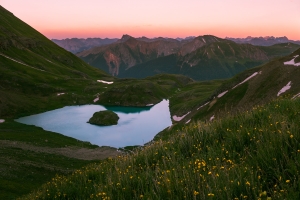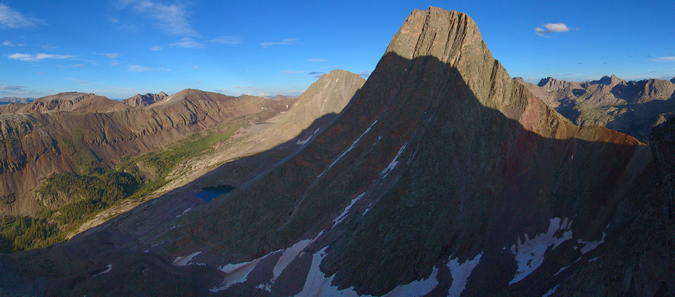Displaying items by tag: Ice Lake Basin
Adventures in Silverton, Colorado: Backpack to Island Lake and summit U.S. Grant Peak
After visiting Ice Lake Basin in August of 2013, I knew that I had to return to the area to photograph the wildflowers there at peak season (mid-July). After moving back to Colorado in November of 2015, I knew that one of my first destinations would be the Ice Lake Basin area. I also wanted to get my wife into backpacking so I got her equipped with some light gear and we both began exercising together to get ready for the primetime hiking season. Since my wife was new to backpacking, I decided to get our pack weight as low as possible. My friend Todd Myers loaned us a great book on Ultralight Backpacking by Mike Clelland which offered some great tips to get our weight down. The items I picked up for my wife included a new sleeping bag, a new sleeping pad, and a new backpack. We were able to get her pack weight under 15 lbs, which I think is a huge success. Here's the short list of gear we picked up for her:
1. REI Joule Women's Sleeping Bag - my wife sleeps super cold and this bag kept her nice and cozy at 12,500 ft, and it only weighs 2 lbs 2 oz. Success.
2. Therm-a-rest NeoAir XLite Sleeping Pad - while this is probably the lightest sleeping pad I've ever seen and it packs down to almost nothing, my wife complained it was a bit too small. Get the longer version.
3. Osprey Tempest 30 backpack - this pack was the perfect size for what she was carrying and weighed under 2 lbs. Awesome.
For myself, I picked up a new backpack as well, the Osprey Exos 48 - a perfect size pack for a tent, bag, pad, food, cookware, and my camera system.
We weighed all of our gear using a kitchen scale and used the awesome gear planner from Erik the Black to calculate our total weight. The whole planning thing helped my wife get into the ordeal and get excited, I think.
Lastly, we invited some of new friends from Durango, including Todd, Autumn, and Ellen. Good times were for sure going to be had! From my last adventure up to Ice Lake Basin, I knew about a shortcut by taking the road up to Clear Lake and then parking at the 1st switchback. This saves about 1,000 feet of total climbing. We arrived at the small parking area, which was empty (a good sign for sure). Our adventure began immediately by crossing the strong creek coming down from Clear Lake. This was my wife's very first stream crossing and she did it like a champion. The trail was steeper than I remembered and my wife struggled a great deal on the way up, but our group was supportive and I was SO proud of her determination. She rocked it! As we entered lower Ice Lake Basin, we had a decision to make - to continue on to Ice Lake Basin, to stay at the lower Ice Lake Basin, or to go to Island Lake, which was somewhere I had never been. The group unanimously voted to go to Island Lake since we anticipated the weekend to be quite busy with wildflower peepers and we thought Island Lake would be a little less busy. I personally had no problems with this since I could head over to Ice Lake no problem to take photos if I wanted. We made quick work up towards Island Lake as sunset approached and I captured a shot of the last light as we gained elevation quickly. The wildflowers were insane. By the way, you can check out the map of where we went and the GPS / GPX file over on Gaia GPS, who generously gave me a free Pro account. I love Gaia GPS - such an awesome app! You can purchase it here and help support the site.
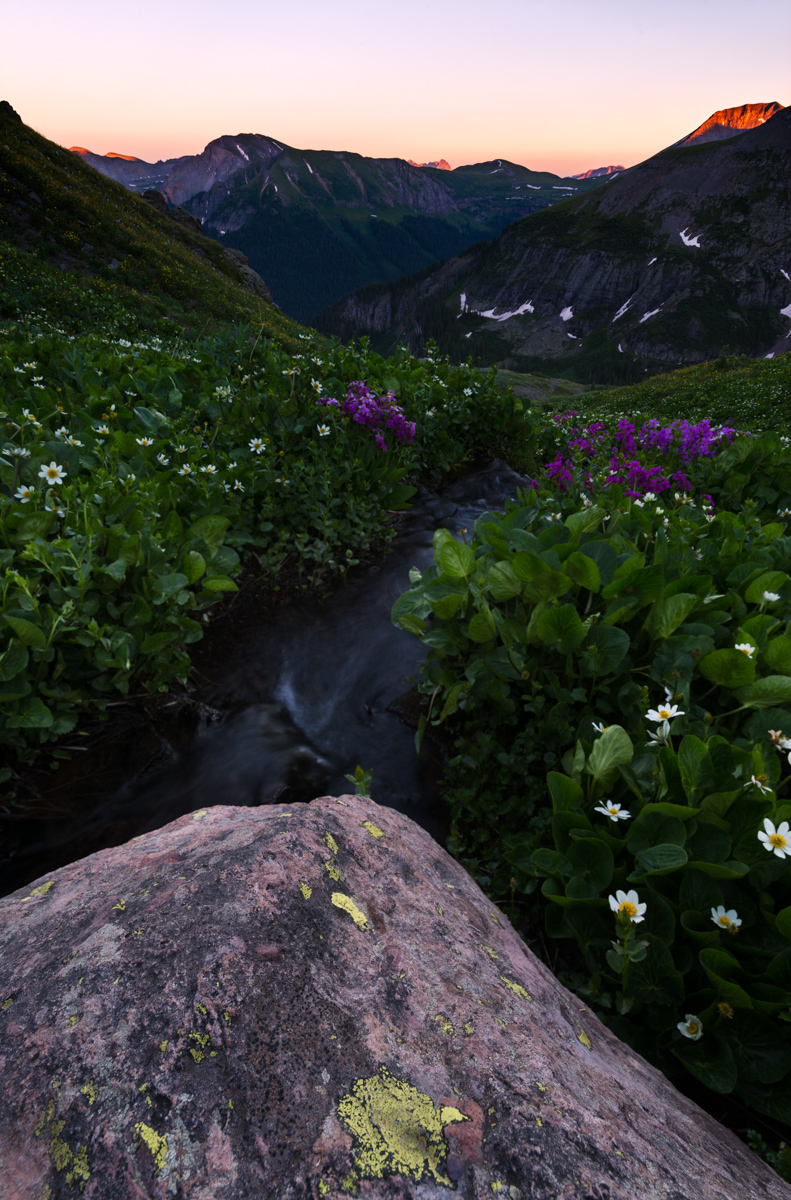
Upon arriving in the upper basin near Island Lake, the whole area opened up to the South and East, revealing views of the Grenadiers, the Chicago Basin 14ers, and Rolling Mountain (right). As you can see, the yellow paintbrush were stunning.
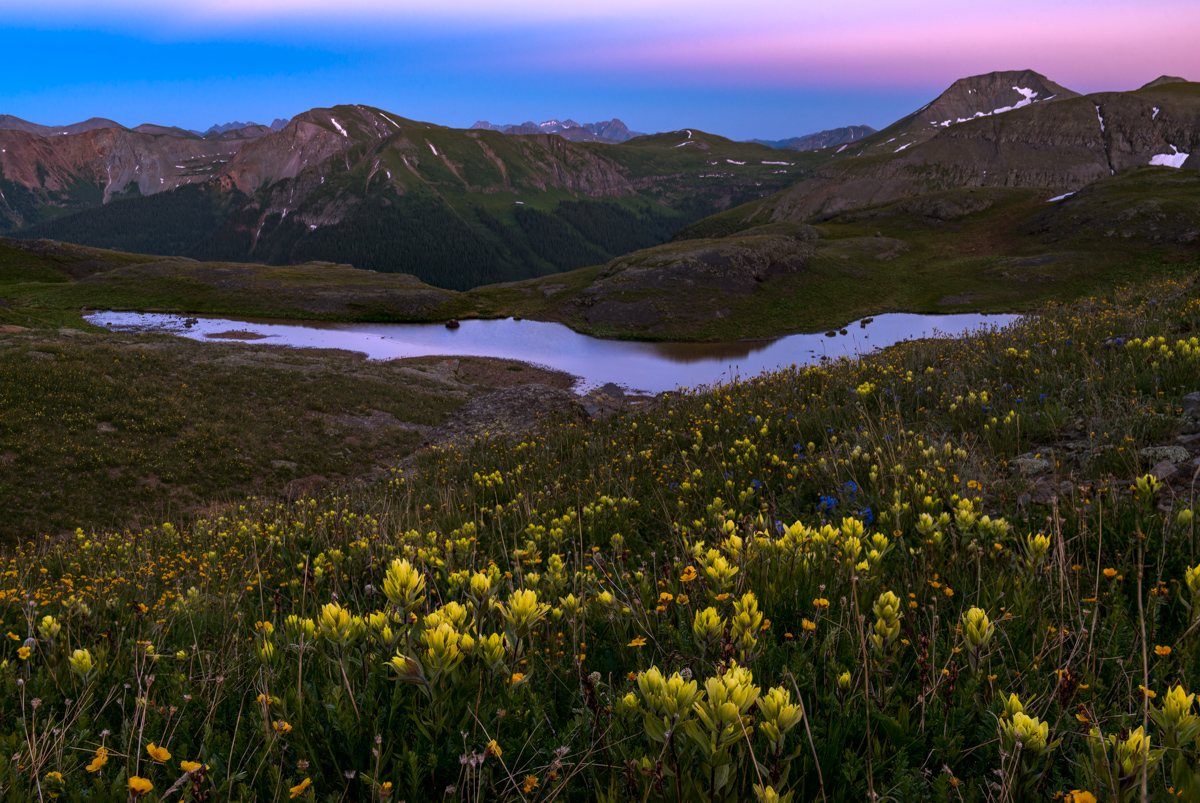
Our group found a great spot right by Island Lake to camp and we proceeded to get set-up. We were alone at the lake (or so we thought) and just loved the solitude. I knew that I would have some great opportunities for some photography at night - I had studied the projections for the moon's brightness, location, and time of rise/set as well as the location of the Milky Way and the time it would rise and set - all using a handy app called PhotoPills. Since the moon was looking to be quite bright and nearly full, I knew that I would shoot in two sessions - early at night for the bright moon illumination, and later in the very early morning after the moon had set. So - I set off to take some photos using the bright moon light to provide some ambient light in the basin. The Milky Way was barely visible, but the moon provided some light to bring out the flowers in the basin and the summit of U.S. Grant Peak.
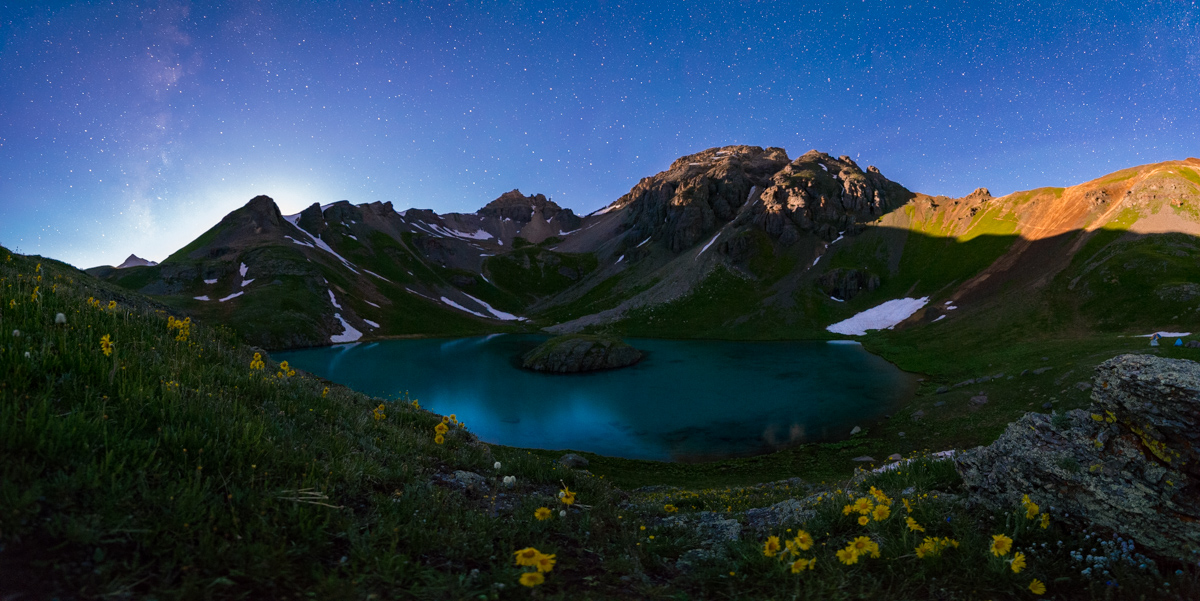
The lake was mesmerizing. I could sit there and take it in for hours.
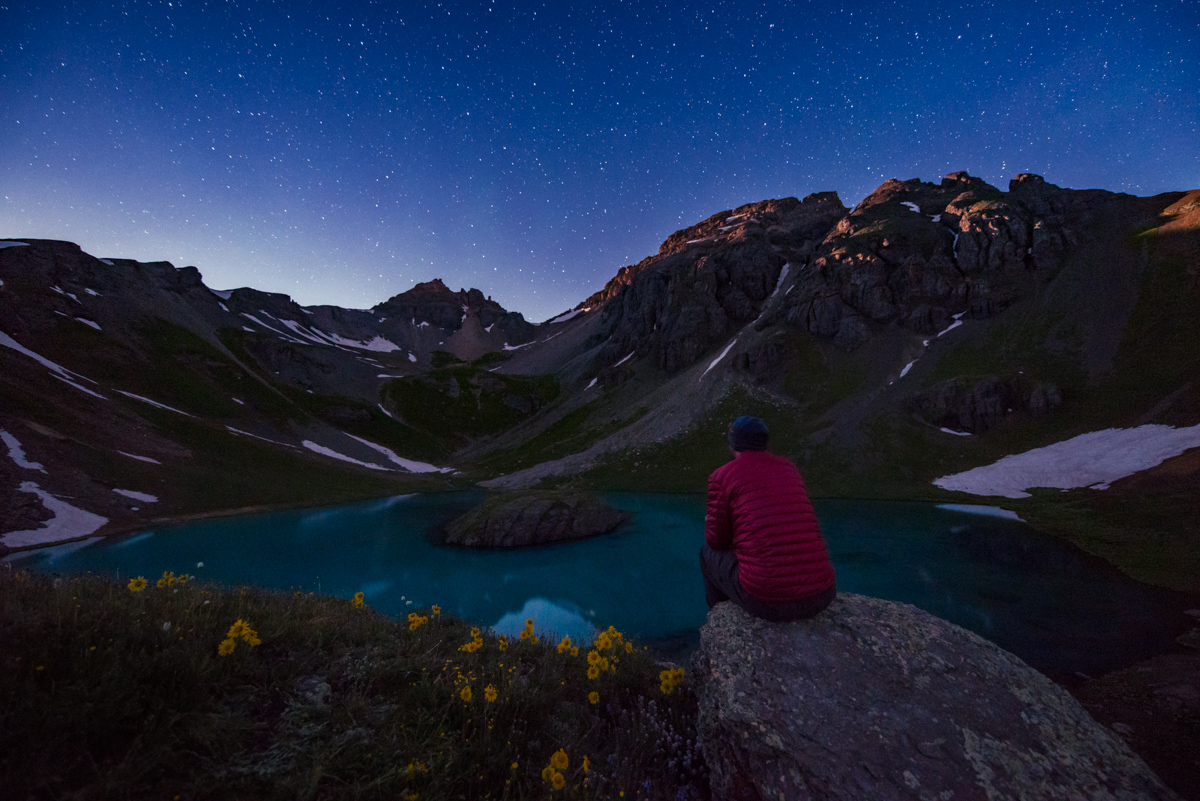
After wandering around for awhile taking photos, I decided to re-join the group at our campsite and go to bed. I set my alarm for 2 AM so that I could find a cool spot to photograph the Milky Way. Sleep is over-rated. None of us slept all that well - it was eerily quiet and everyone could hear everyone else move in their bags, open and close zippers, etc. It was pretty tough to get any sleep. I got out of the tent at about 1:45 AM and looked for a good spot to shoot the Milky Way, as planned. I found a little shallow lake nearby that had a nice view over towards the Ice Lake Basin 13ers. I was able to find a way to place my tripod in the center of the lake (it was really only about 3 inches deep), and loved how I could get the reflection of the Milky Way in the water. An amazing sight, for sure!
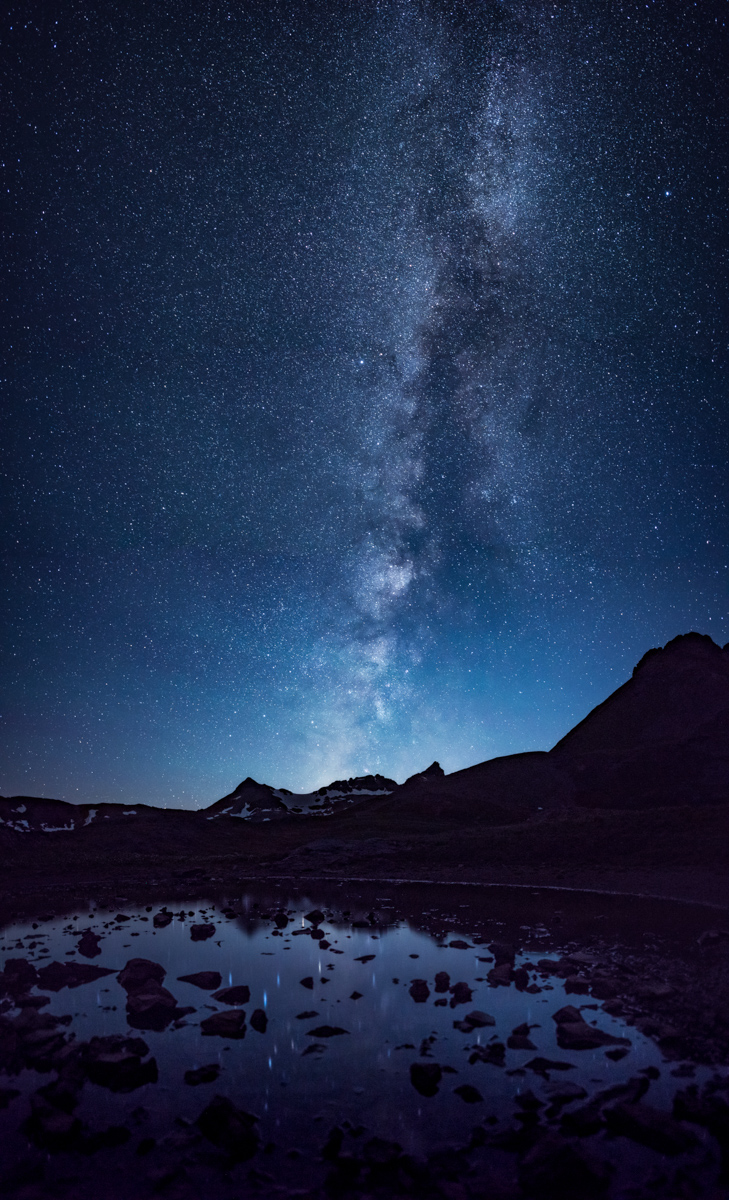
I really wanted to get a 180 degree panorama of the full Milky Way reflected in the water, and was able to pull it off after some work on my settings. The airglow (those high, green looking clouds) was looking awesome as well.
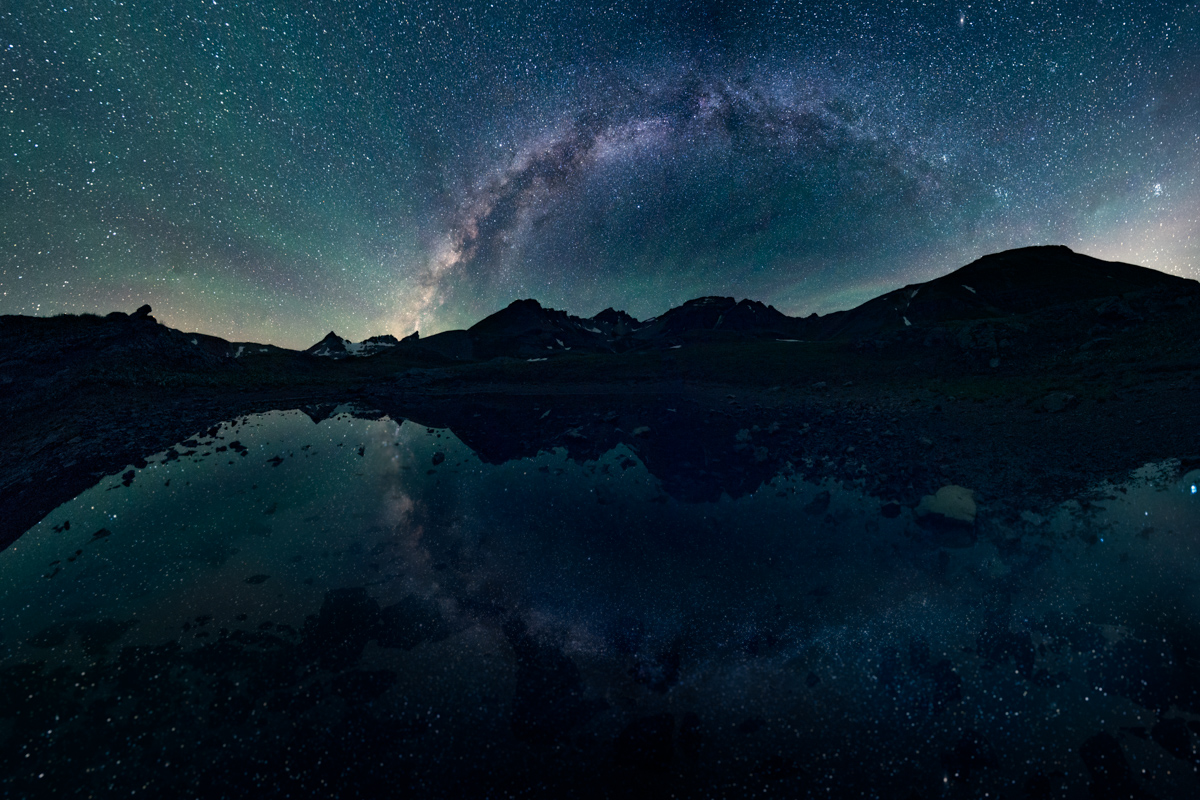
I played around a little with my headlamp as well, wanting to add a human element to the scene. I think it worked out pretty nicely.
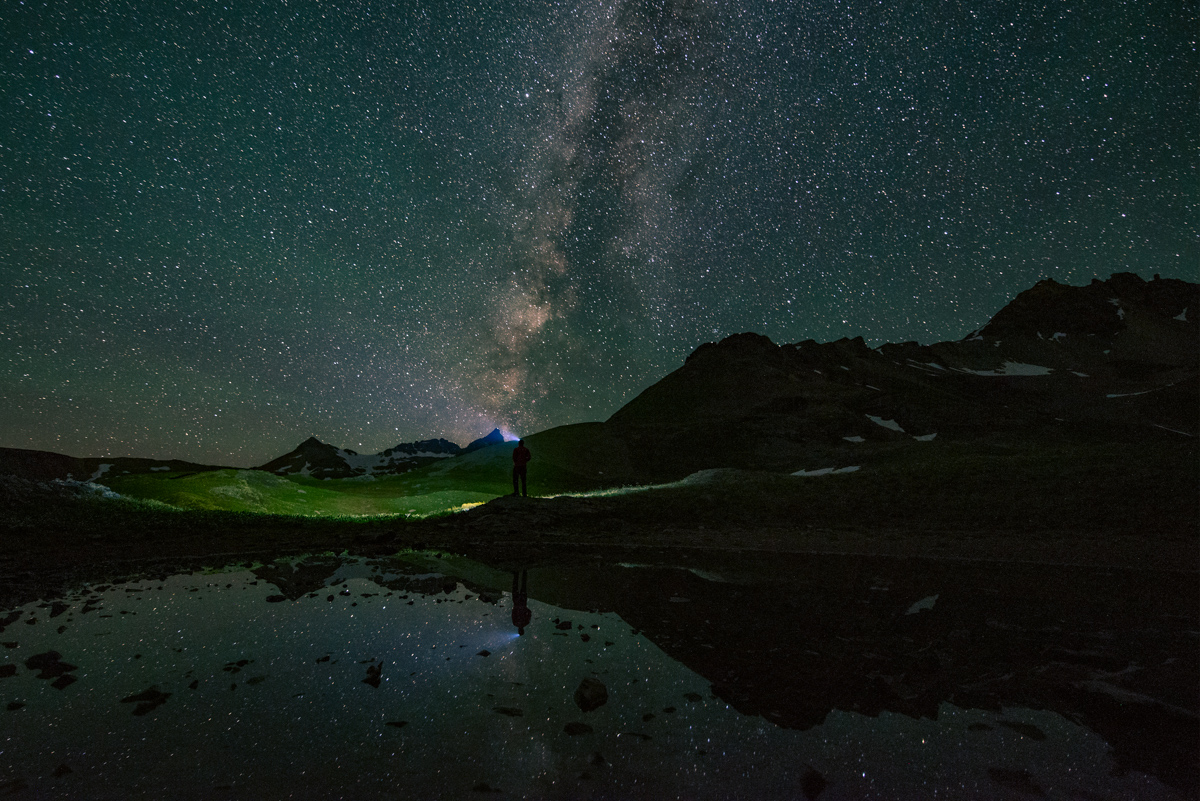
I went back over to Island Lake to set-up for one last shot before going to back to bed. This was a photo that I shot as a tattoo concept that I have been thinking about for awhile - imagine the flowers or a campfire at the bottom on the wrist and then the tattoo works its way up the arm to the mountain and then the Milky Way. I think it would look great, personally.
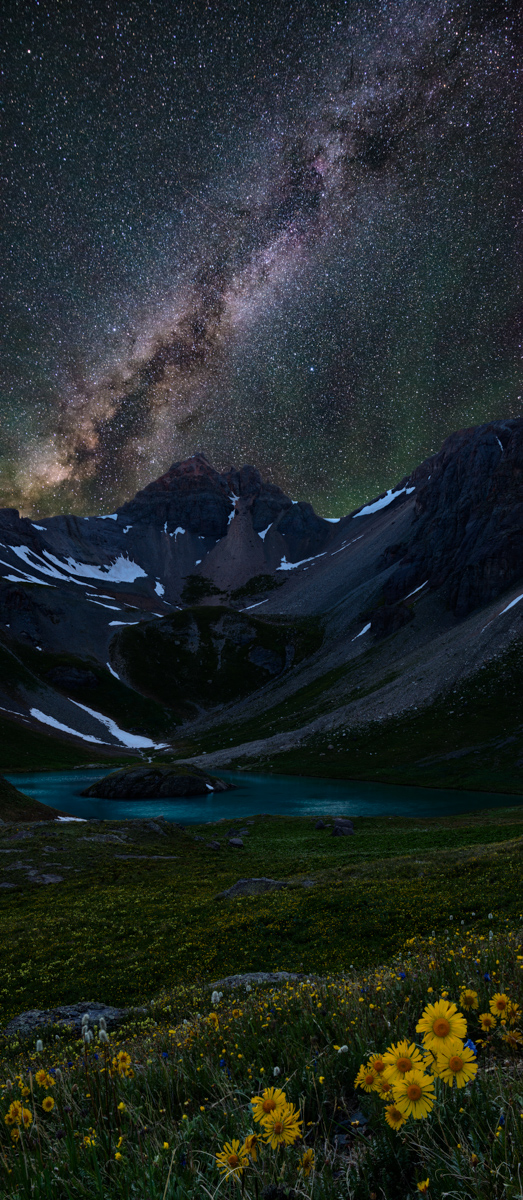
I went to bed again around 4 AM, getting about 4 hours of sleep total. We all woke up and enjoyed the amazing view from the lake and noticed some hikers heading up U.S. Grant Peak. I threw out the idea of doing the same and everyone agreed to give it a shot. So, we made breakfast and got ready for an adventure up U.S. Grant Peak. Normally I do a lot of research before climbing any peak; however, for this one, I decided to just see how things would go and turn-around if needed. I knew there was some challenging class 3 or 4 sections but had no idea what would be in store for us. Exciting!
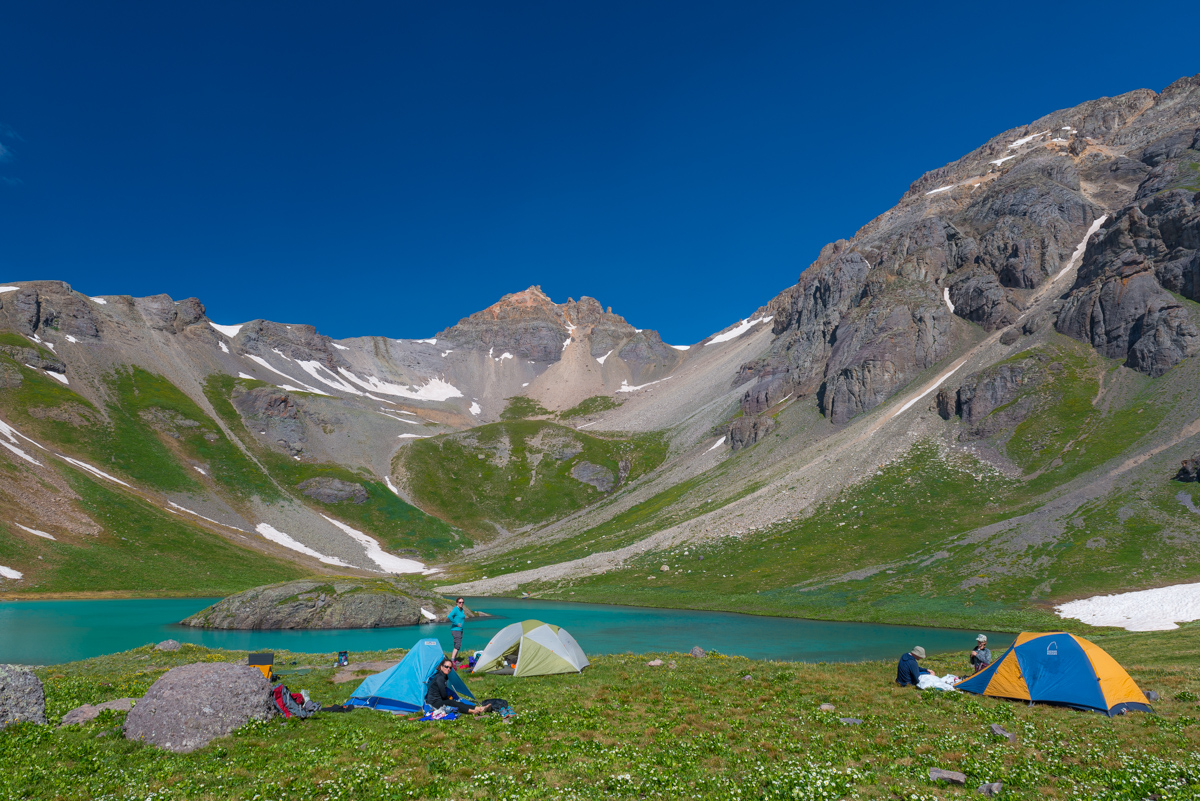
Off we went towards U.S. Grant peak - our goal was to gain the saddle between the two small areas of snow to the right of the peak above the lake seen above.
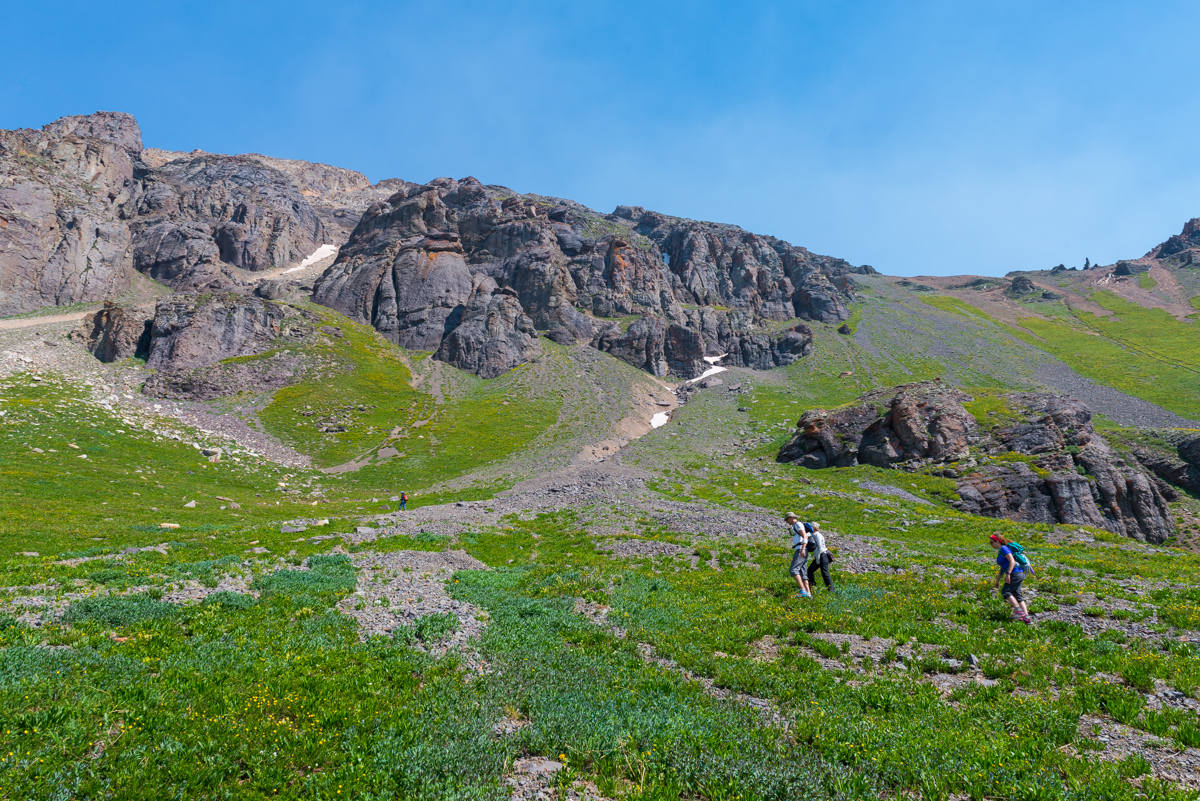
While we were hiking up there was a large group of day hikers having a bit of fun on the island - one even took a backflip off the lake. I'm thinking that was pretty damn cold. More on that later.
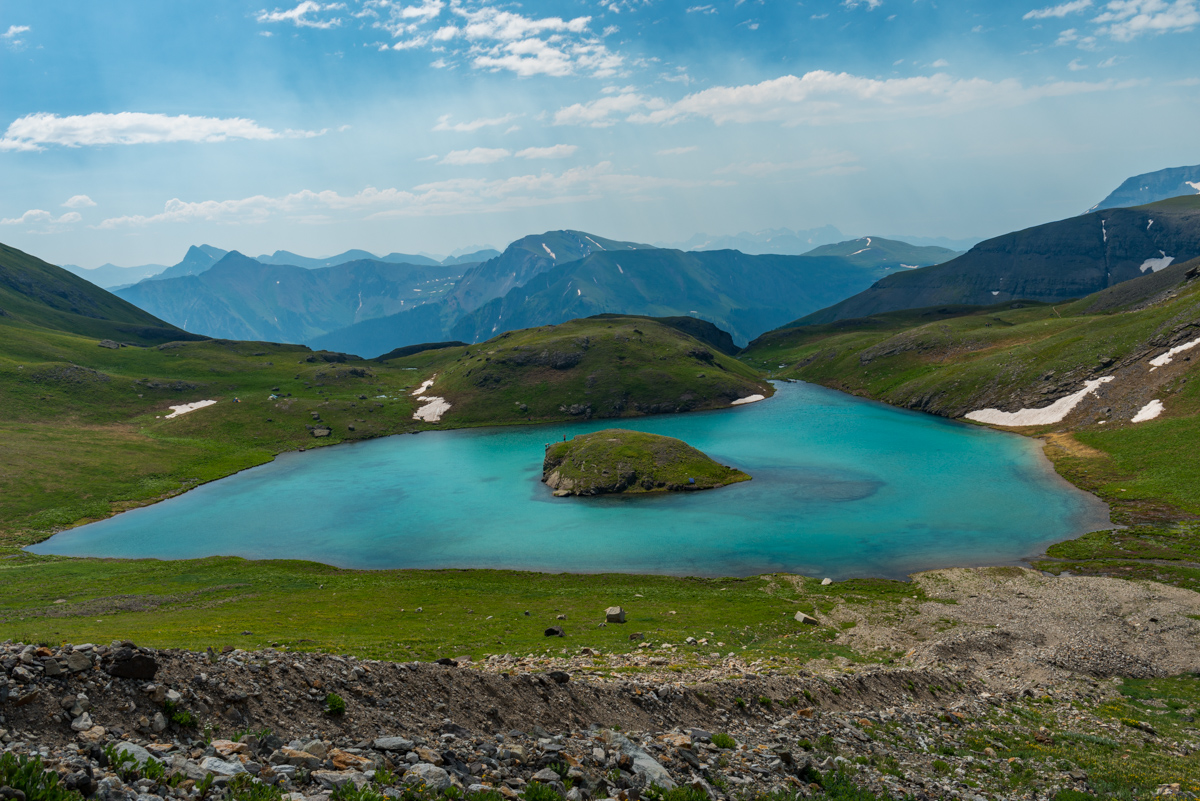
We reached the last section with grass and that is where my wife decided to rest while we continued on. She had an amazing view to take in.
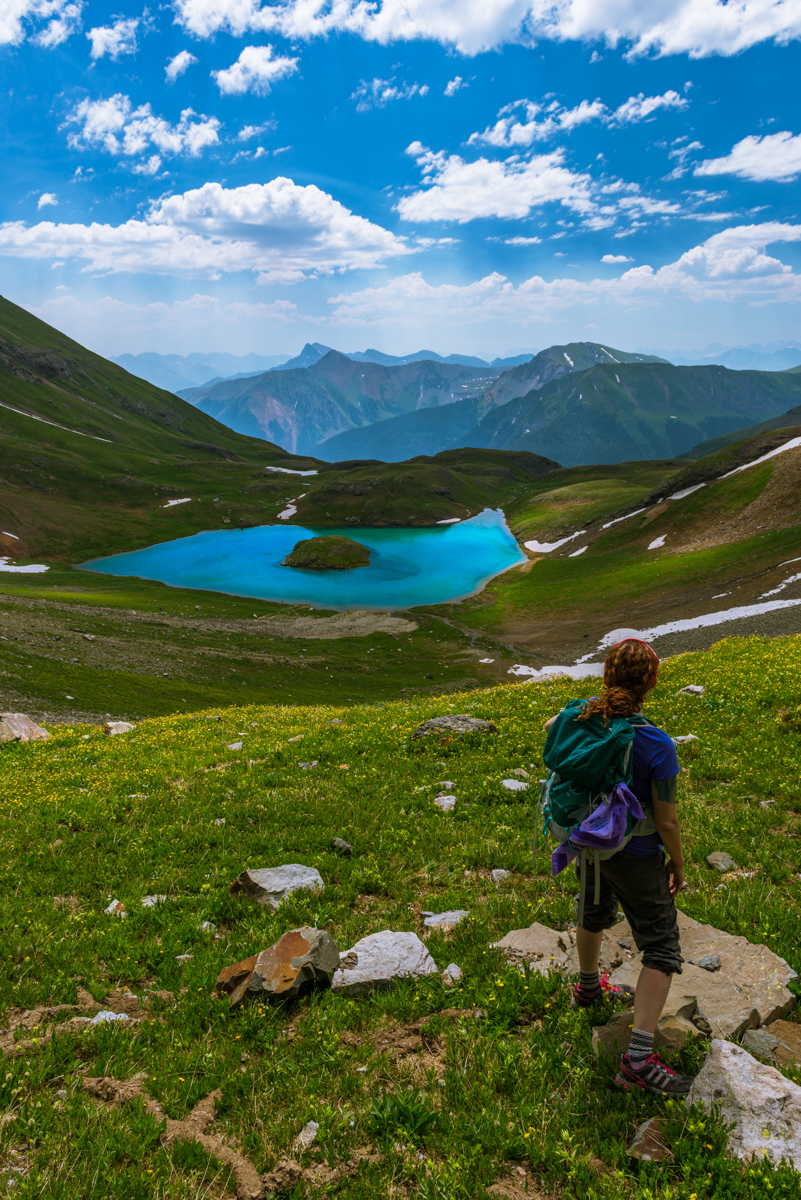
There was a very lightly travelled trail up to the ridge up the muddy dirt and scree. My legs were feeling great so I took the lead, which was awesome because then I could stop and take photos of my friends climbing up. This was a particularly memorable climb because it was Autumn's first mountain climb in Colorado, one I'm sure she will remember.
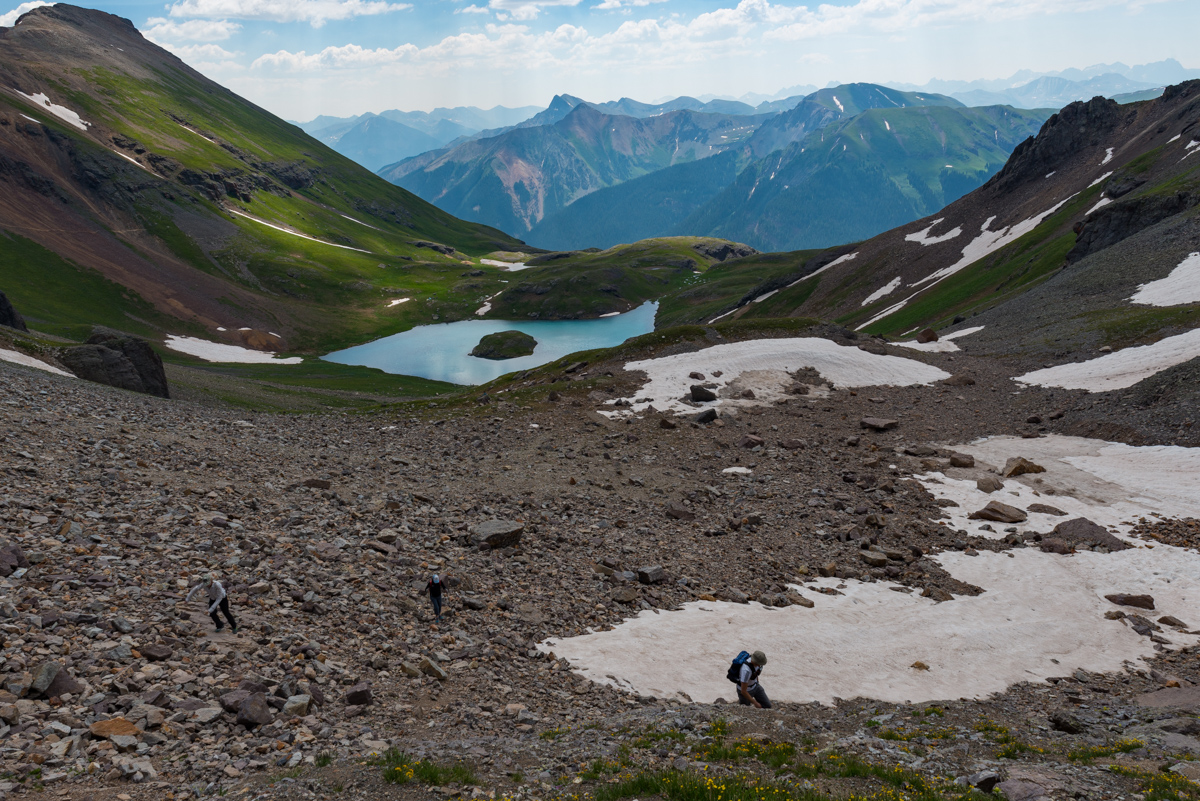
The higher we got, the better the view was, which eventually opened up fully to reveal the San Juans in their glory, from Pigeon all the way over past Vestal and again past Jones and Handies (right to left).
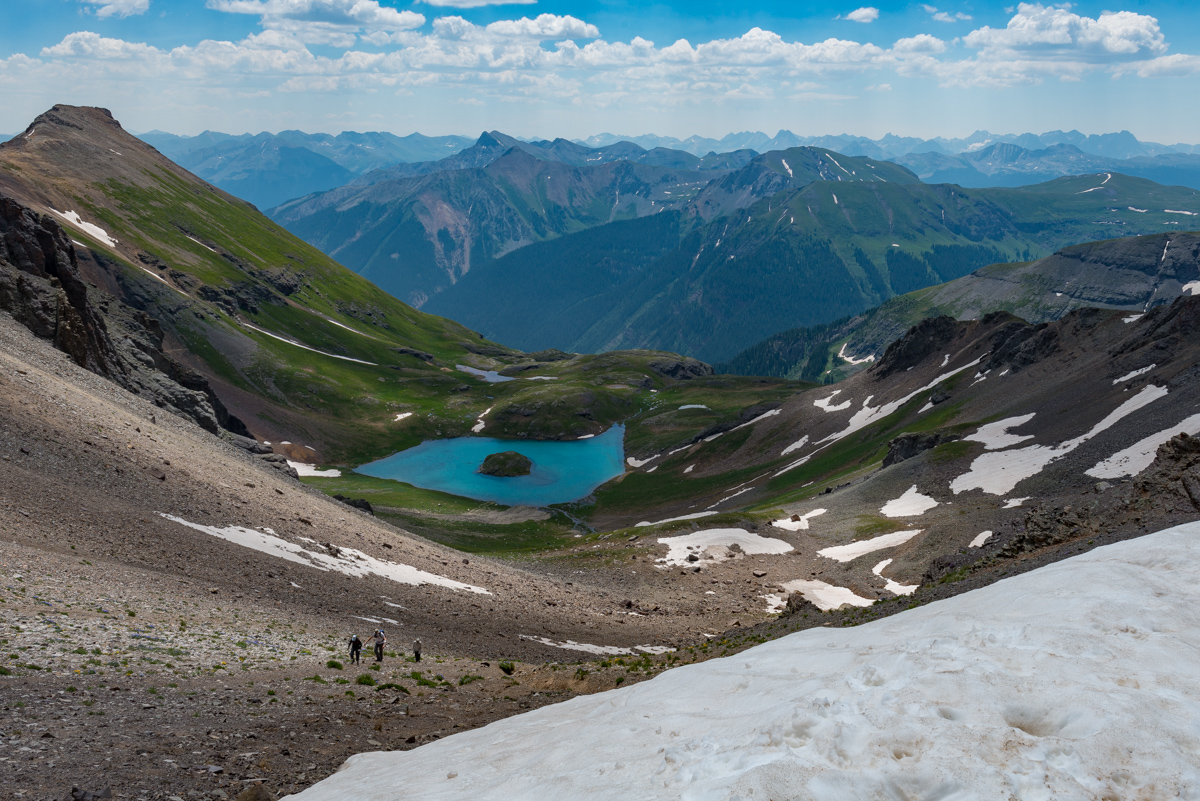
Upon reaching the ridge, I was greeted with a glorious view of Mount Wilson (left), Gladstone (left of center), and Wilson Peak (center). It was great seeing them from this vantage point since I had just climbed Gladstone and Wilson Peak the weekend before from Bilk Basin.
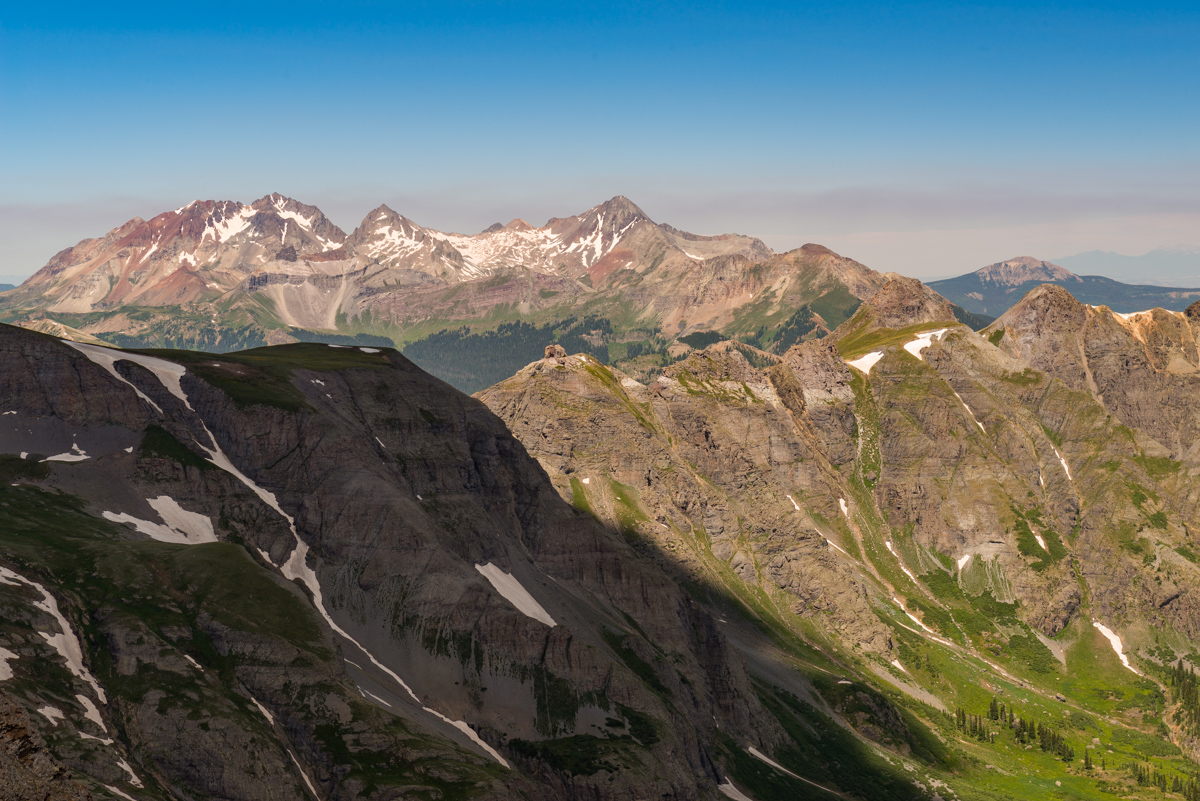
Ellen and Todd joined me on the ridge to take in all of the awesomeness.
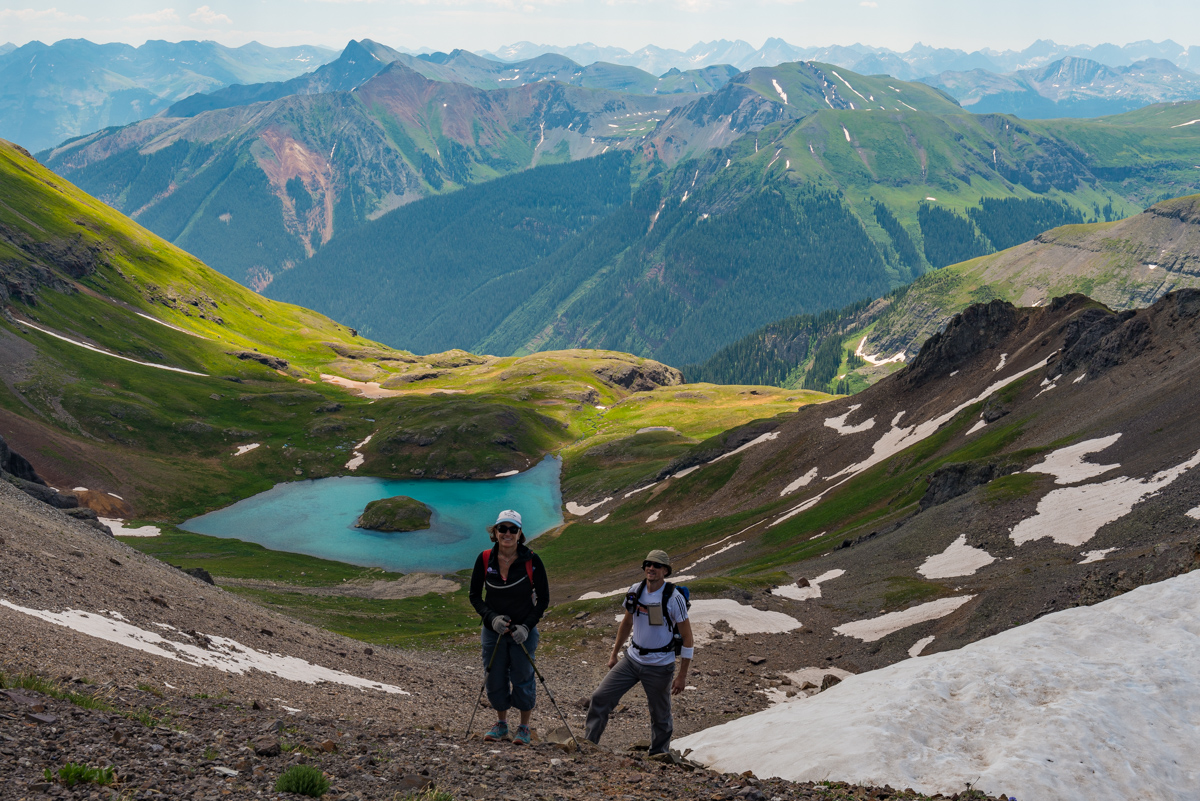
From the ridge we took a right turn and followed a very solid but slightly loose trail straight up the ridge. Here is a view looking down that ridge.
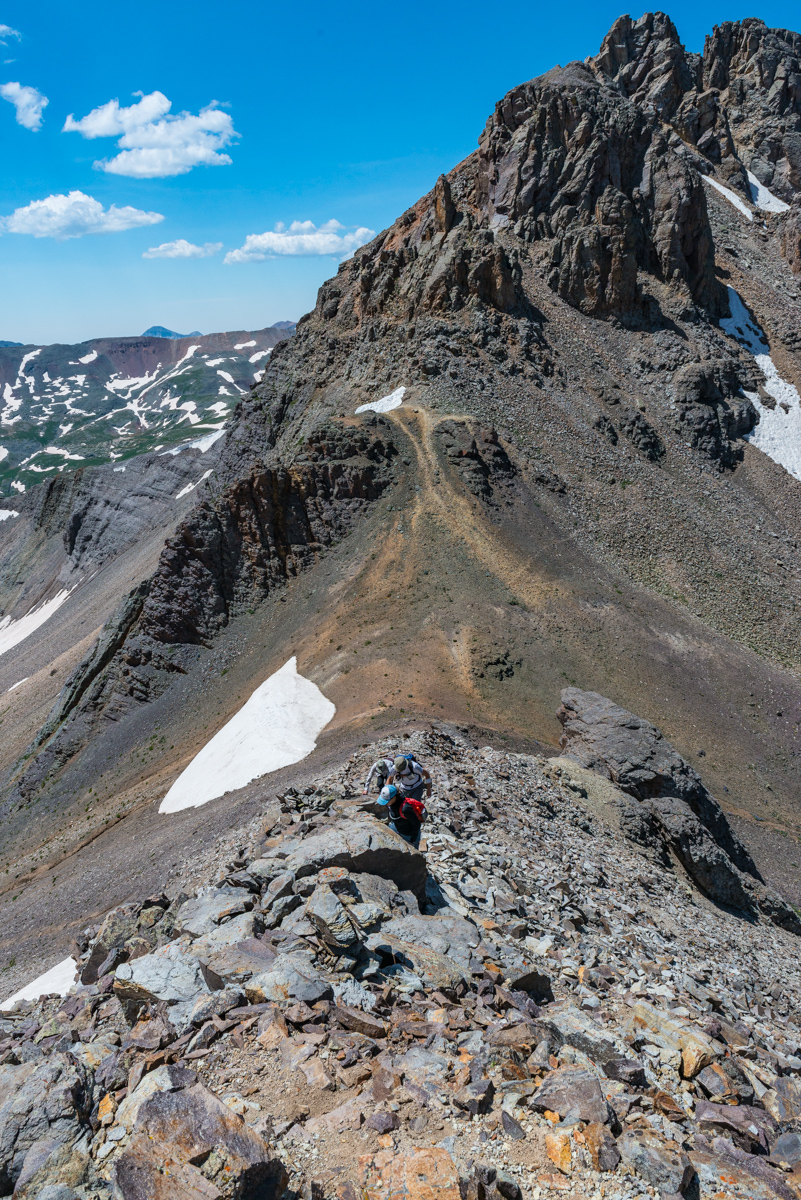
The view back down to Island Lake dominated my mind as we scrambled up the relatively easy class 2+ scree.
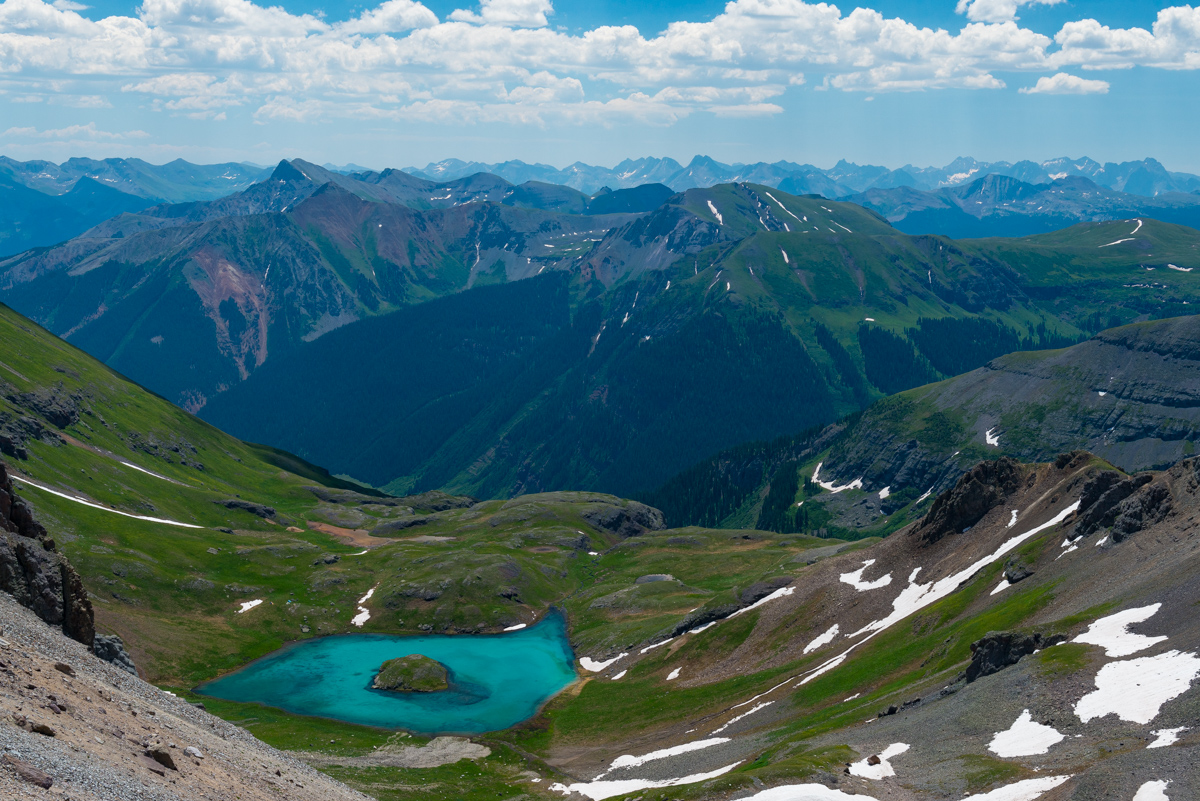
Eventually, looking back we could see Pilot Knob's gnarly summit block behind us over in Ice Lake Basin. The group continued the slog up the loose scree, which was pretty manageable.
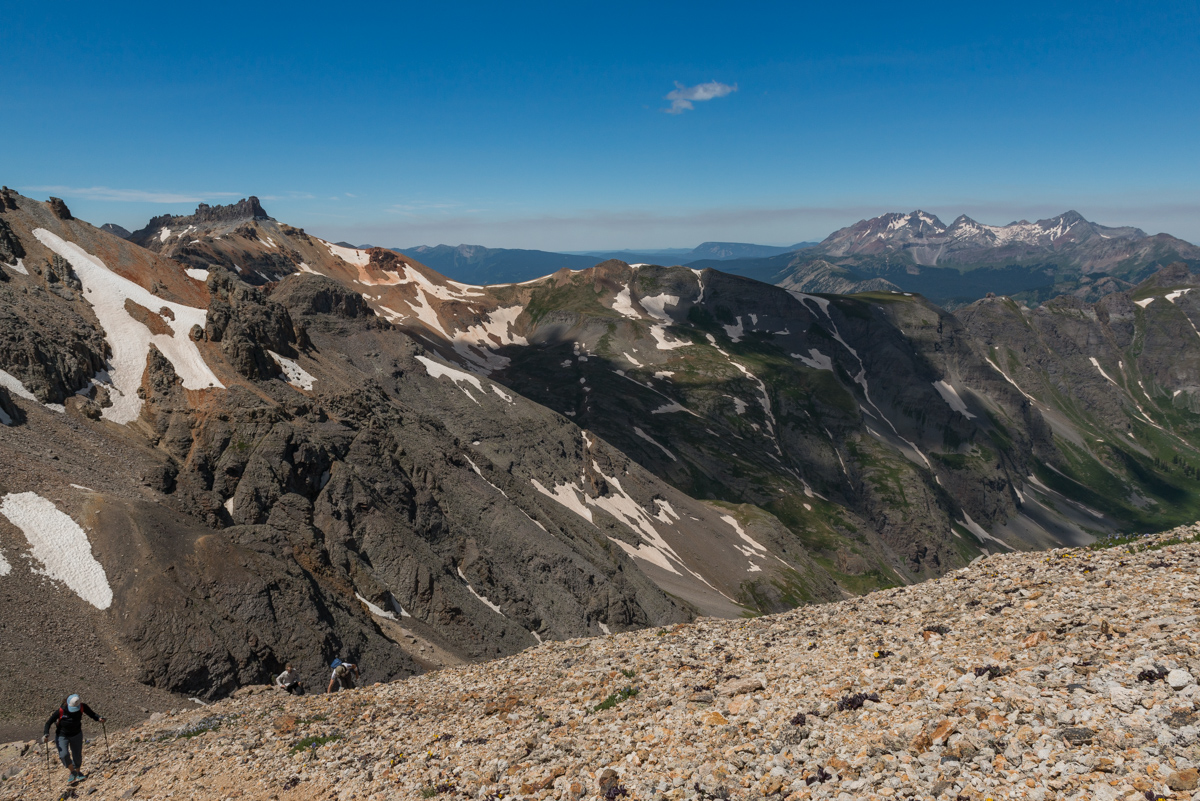
I live for this kind of terrain but I think my friends thought I was a little crazy for enjoying it. The rock was pretty much what you'd expect in the San Juans.
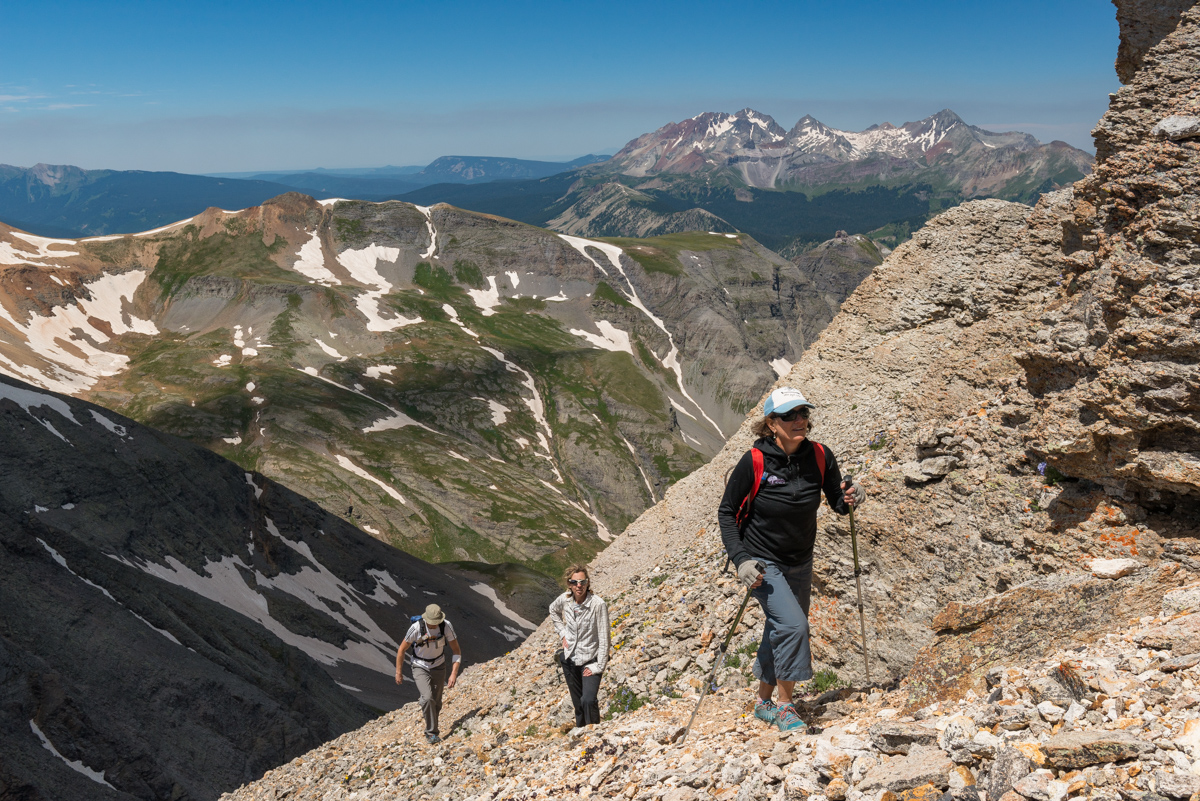
We eventually found ourselves in a steep orange gully with great hand-holds on the sides which was fairly loose. Sticking close to the wall made for pretty easy navigation.
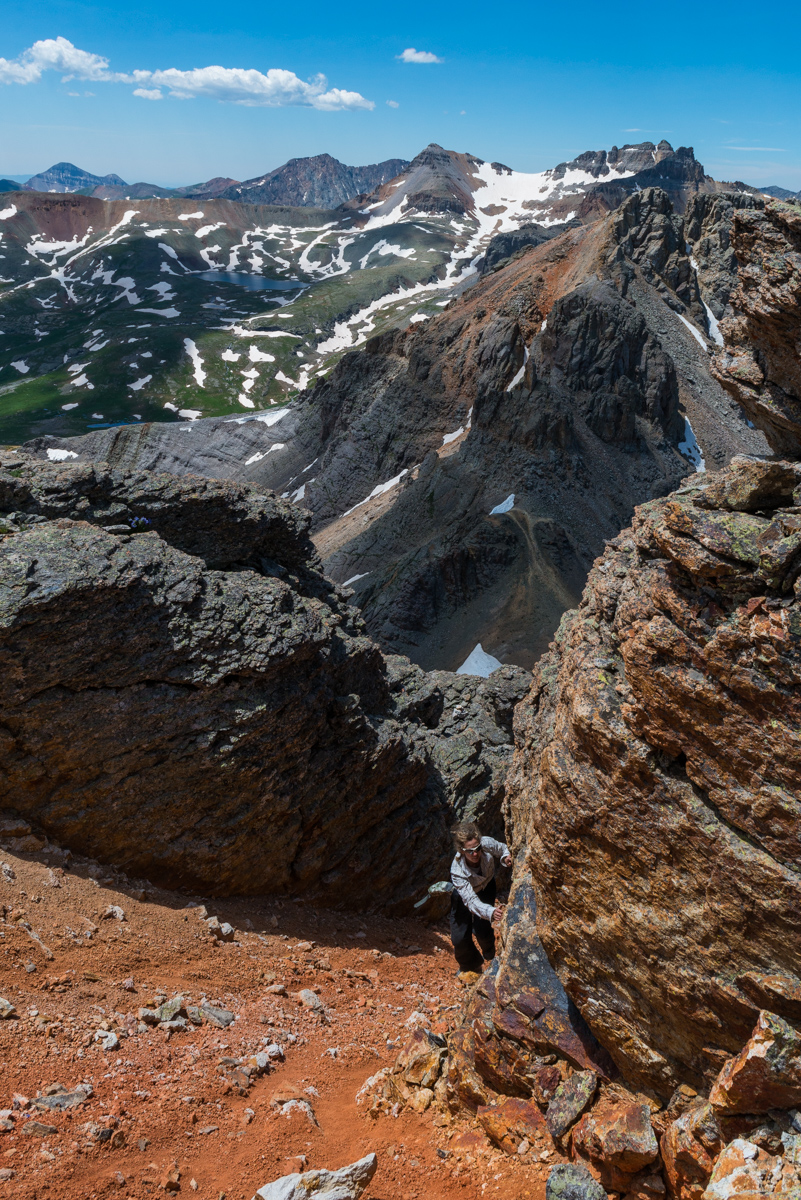
The full beauty of Ice Lake Basin presented itself as we gained elevation, showcasing both Ice Lake and Fuller Lake. The weather looked like it would hold for the whole day.
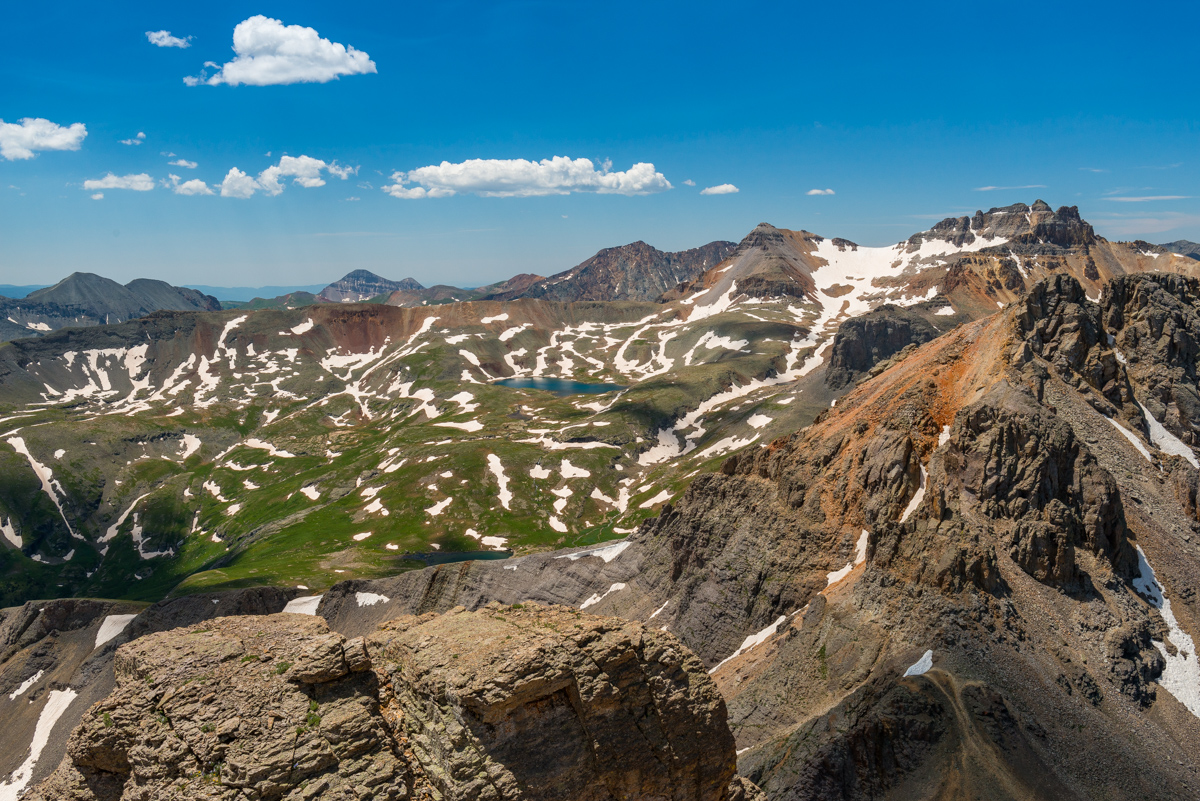
Honestly, I think I could have stayed up there for hours on end, taking in the views in every direction. It was just the reason I moved back to Colorado.
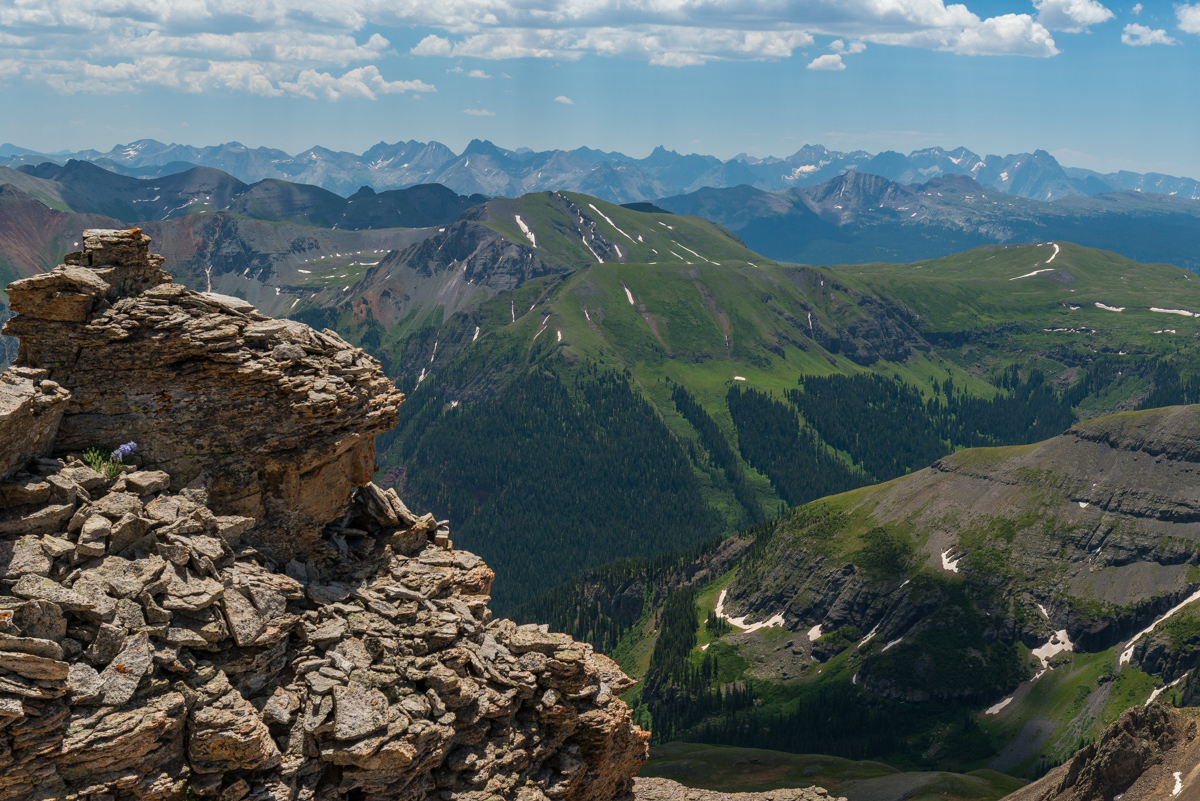
Island Lake pretty much stayed in view the entire way up, a nice beacon and reminder of just how high we had climbed in such a short amount of time.
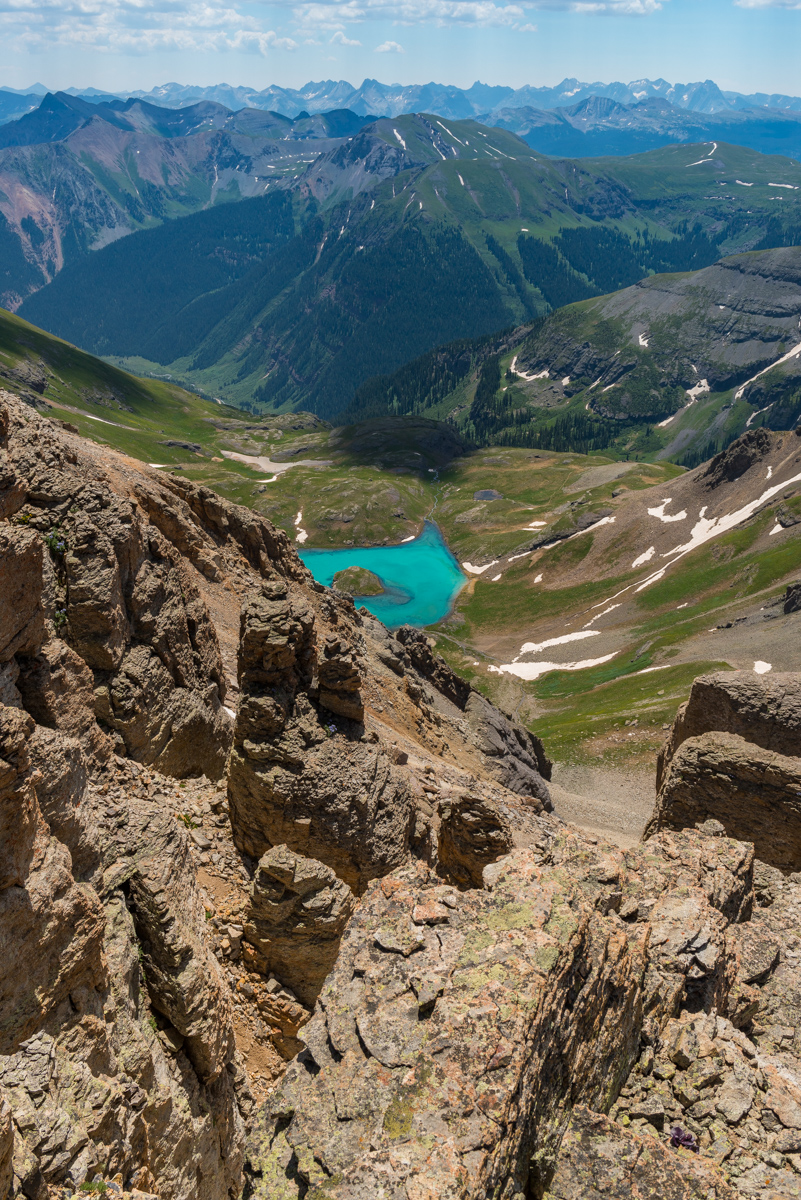
At last we reached the crux of the climb, which I had no idea existed. We got to this wall and wondered if we had taken a wrong turn or if we needed to go around, or, what? Upon close examination I decided it was the only way up. It consisted of three or four relatively exposed moves up to a small ledge, which wrapped around to the right. I went first and Ellen decided to join me. Todd and Autumn decided to stay behind because it looked too difficult.
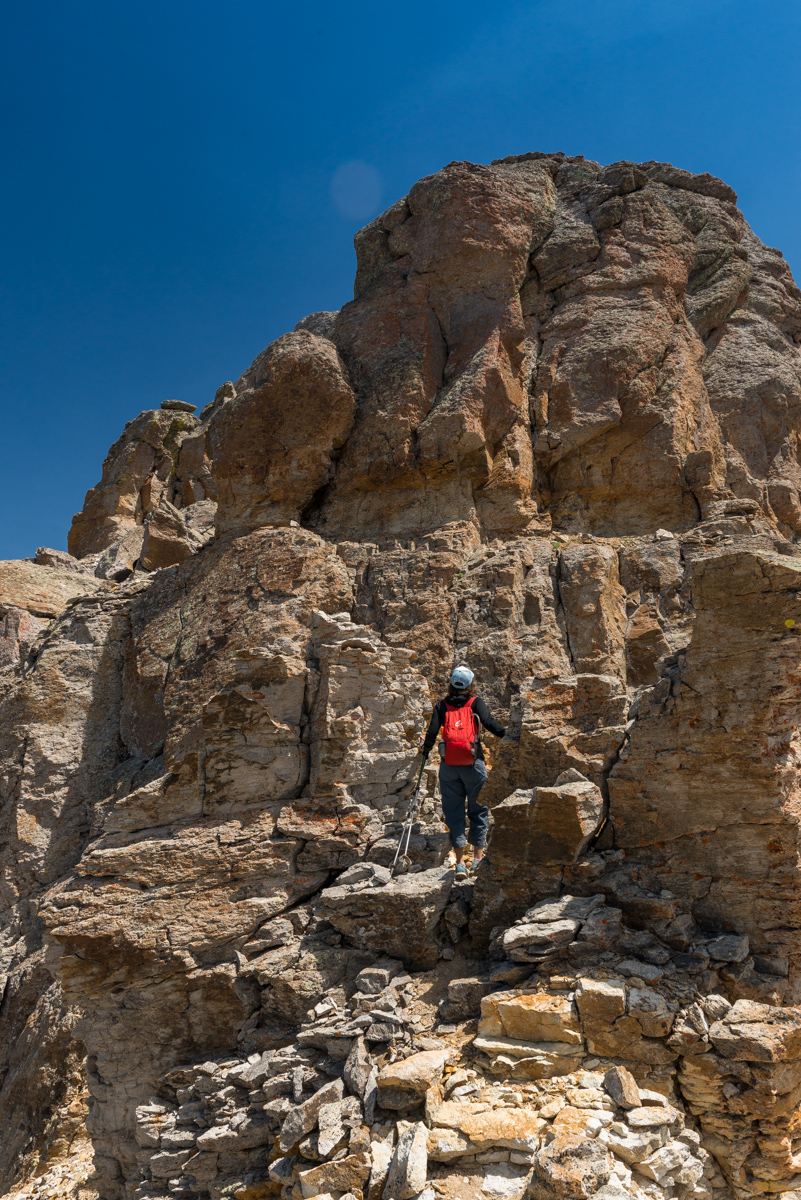
When Ellen and I got to the top, about 3 minutes later Todd and Autumn joined us - we were so excited that they decided to come up the wall. Even though the shots are out of sequence, I thought it best to show how hard the wall looked, on our way down, with Todd and Autumn still needing to downclimb it (below).
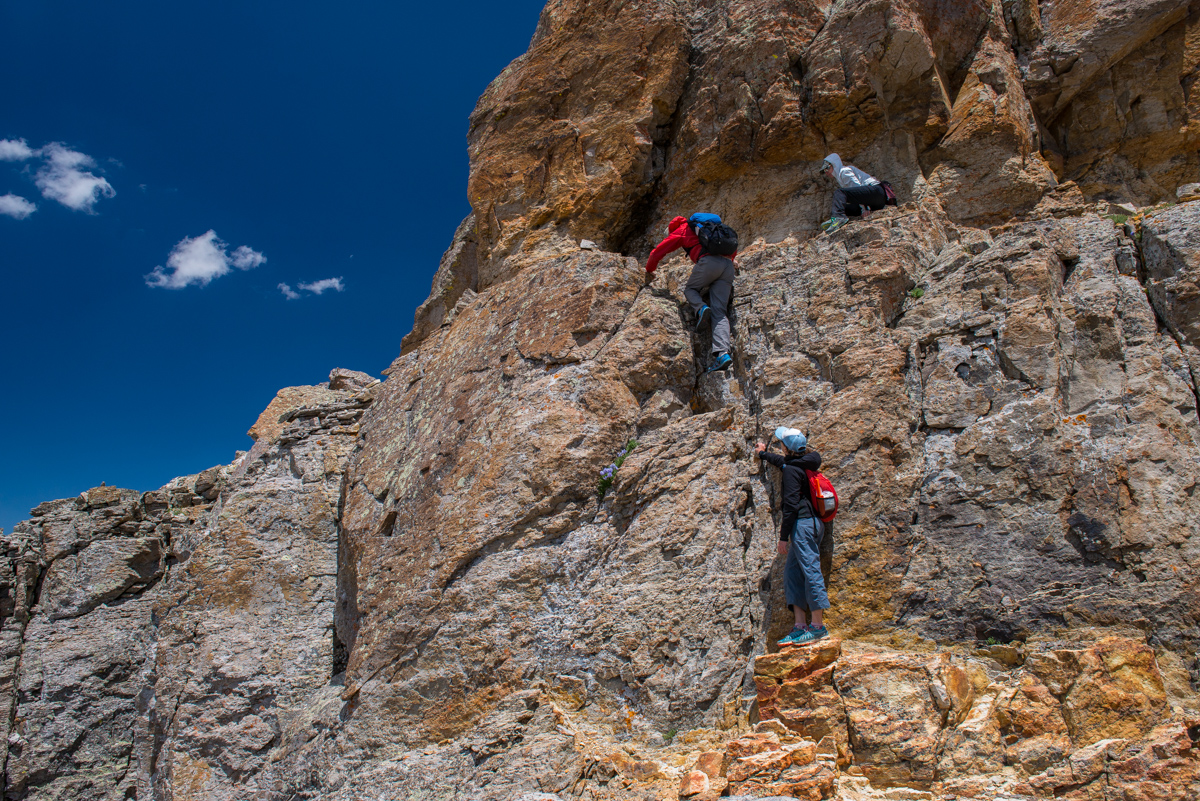
The top was magnificent. Here's Ellen topping out on a summit filled with purple wildflowers (their name always escapes me).
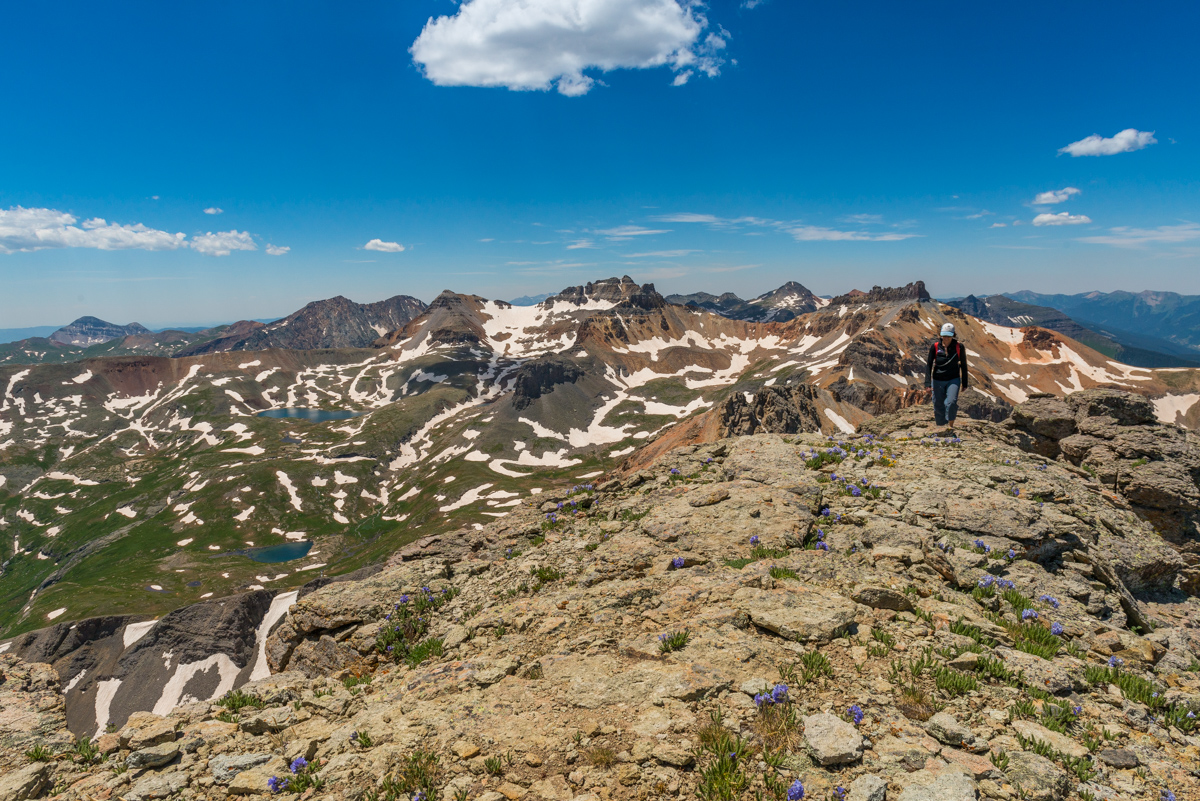
From the summit you could make out every major summit in the San Juans, including Uncompagre and Wetterhorn (top center).
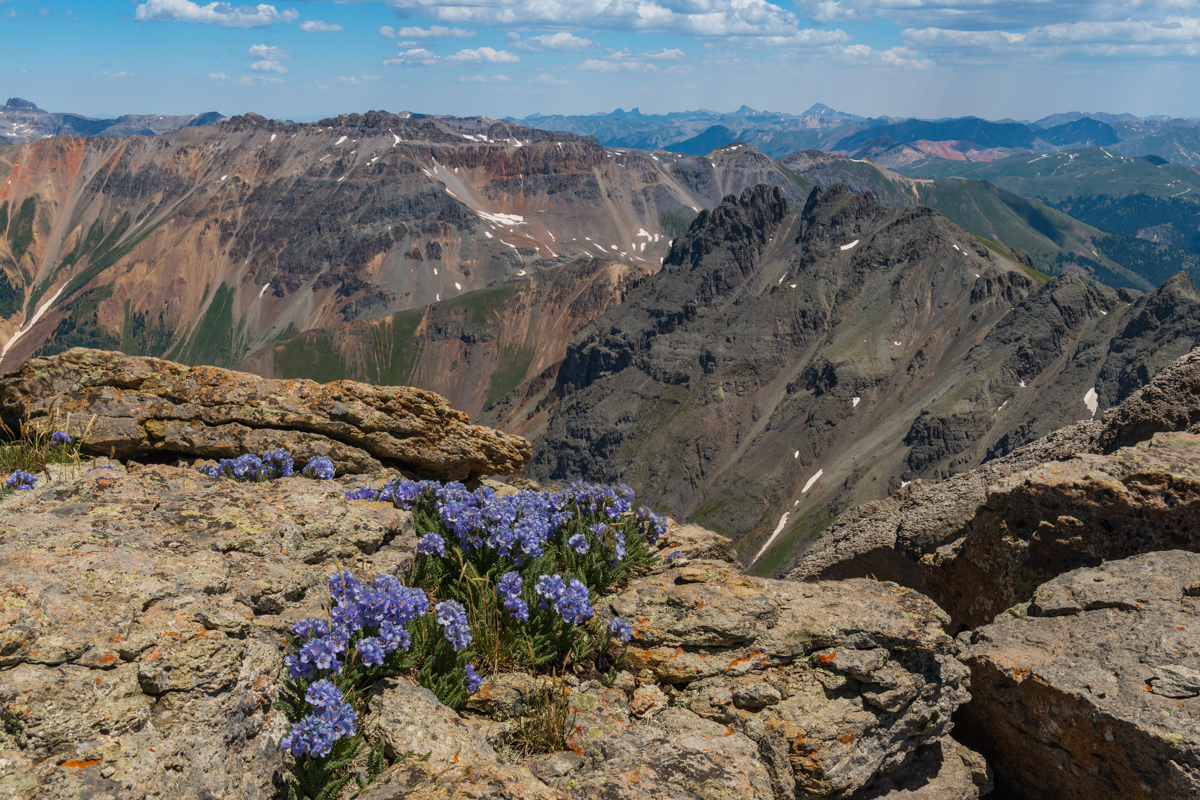
My gaze kept going back over to the San Miguels to the west. They were so damned impressive.
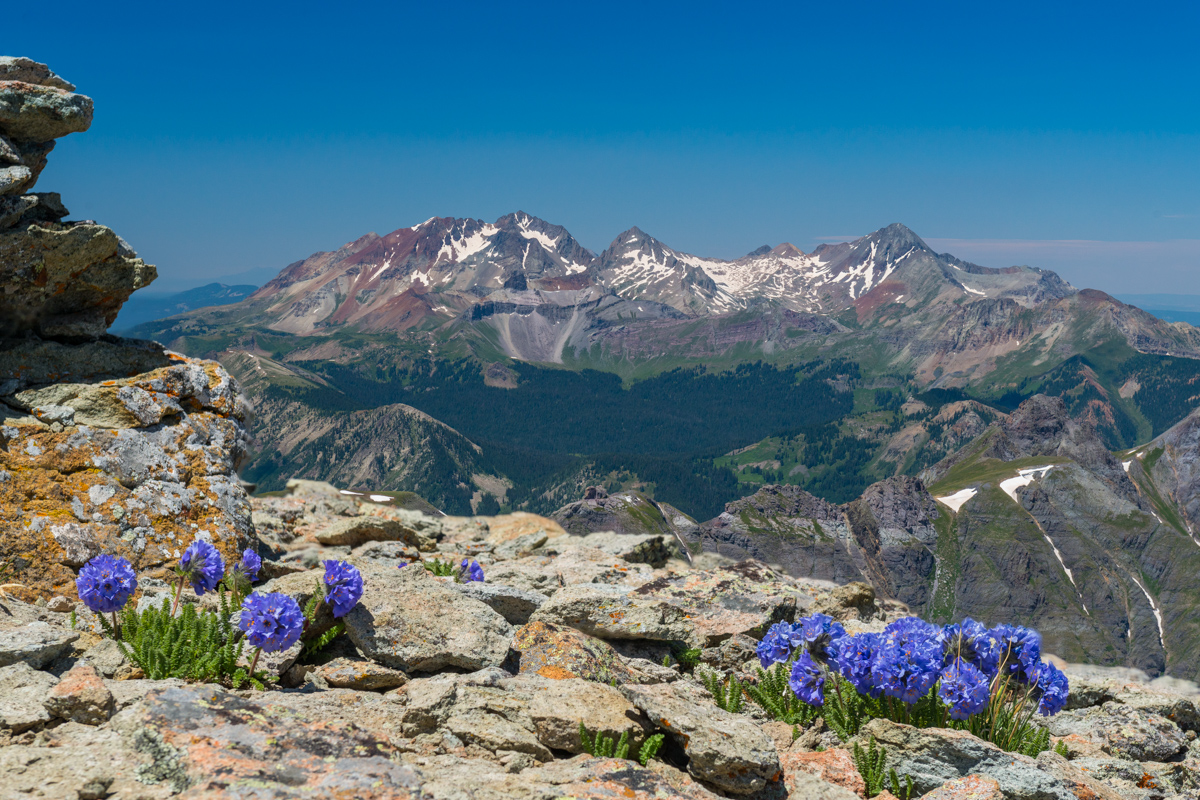
Next, a 180 degree view showing most of the San Juans and Ice Lake Basin, and Island Lake. So amazing.
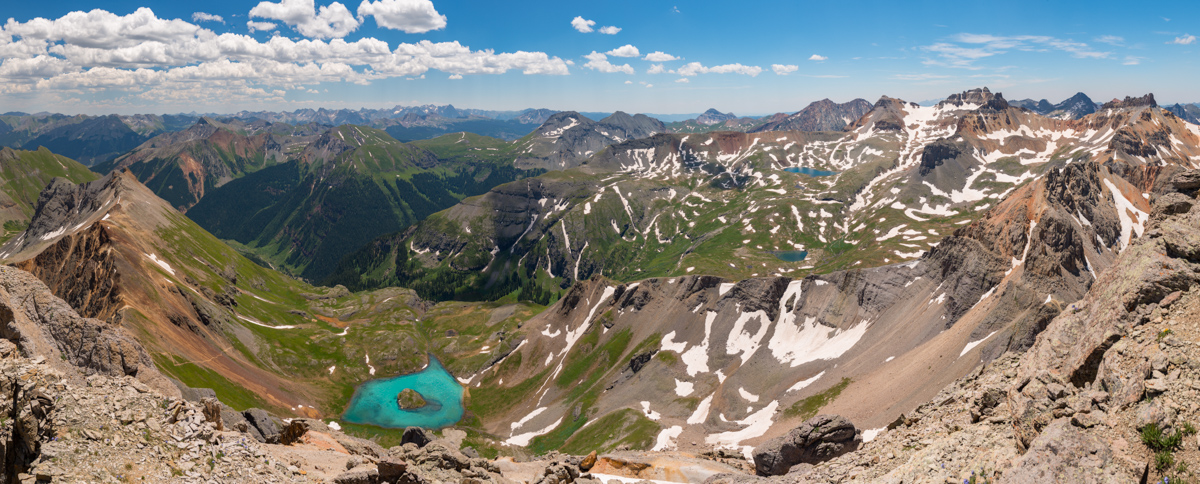
A quick group photo was in order, so I set up the tripod and self-timer. All I remember is that Todd invented a new food item on top - a burrito consisting of Peanut Butter, Fritos, and slices of apple. Apparently it was quite delicious.
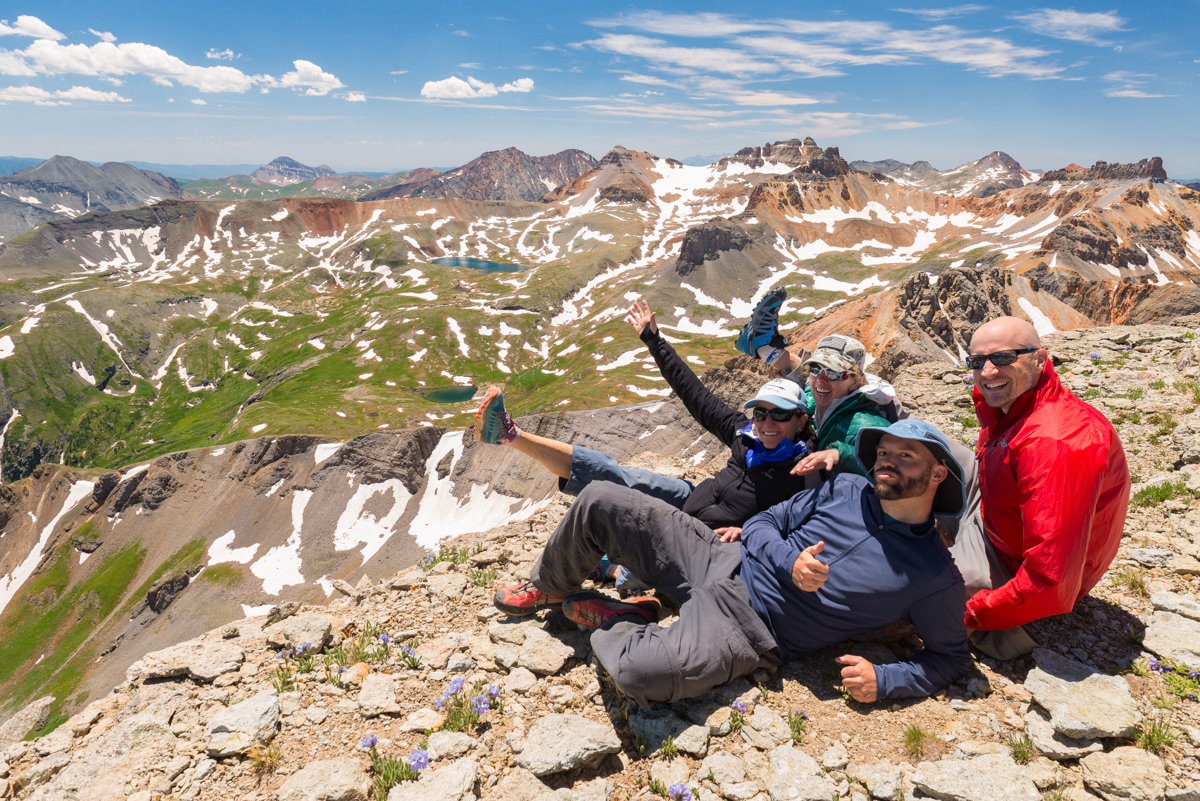
After enjoying lunch, we head back down, without any issues at all. We all faced-in on the crux and it was surprisingly easier than I thought it would be. Now, remember above where I said the lake was cold? When we were about 1/2 way down the ridge, I noticed a group of people huddled around our tents at the lake. I was not too concerned until I saw them open Todd's tent. My first reaction was, "what the heck are they doing, trying to steal beer or something?" I raced down the mountain at a quick pace and caught up with the group. As I approached they asked if they were invading our campsite. I replied, "well, yes, kind of...". They apologized and said that their son (probably about 14) had swam in the lake and was getting hypothermia and needed somehwere to lay down and warm up, and was that OK? I felt horrible for thinking they were doing something bad and replied, "of course not - not a problem at all, and that makes total sense!" The rest of our group arrived and we helped them ensure he had food and was warm before they departed the basin. We rested up and as the sun dropped lower and lower I decided to get the camera out and take some photos of sunset at the lake. It was a pretty nice one. The marsh marigolds and fireweed looked awesome.
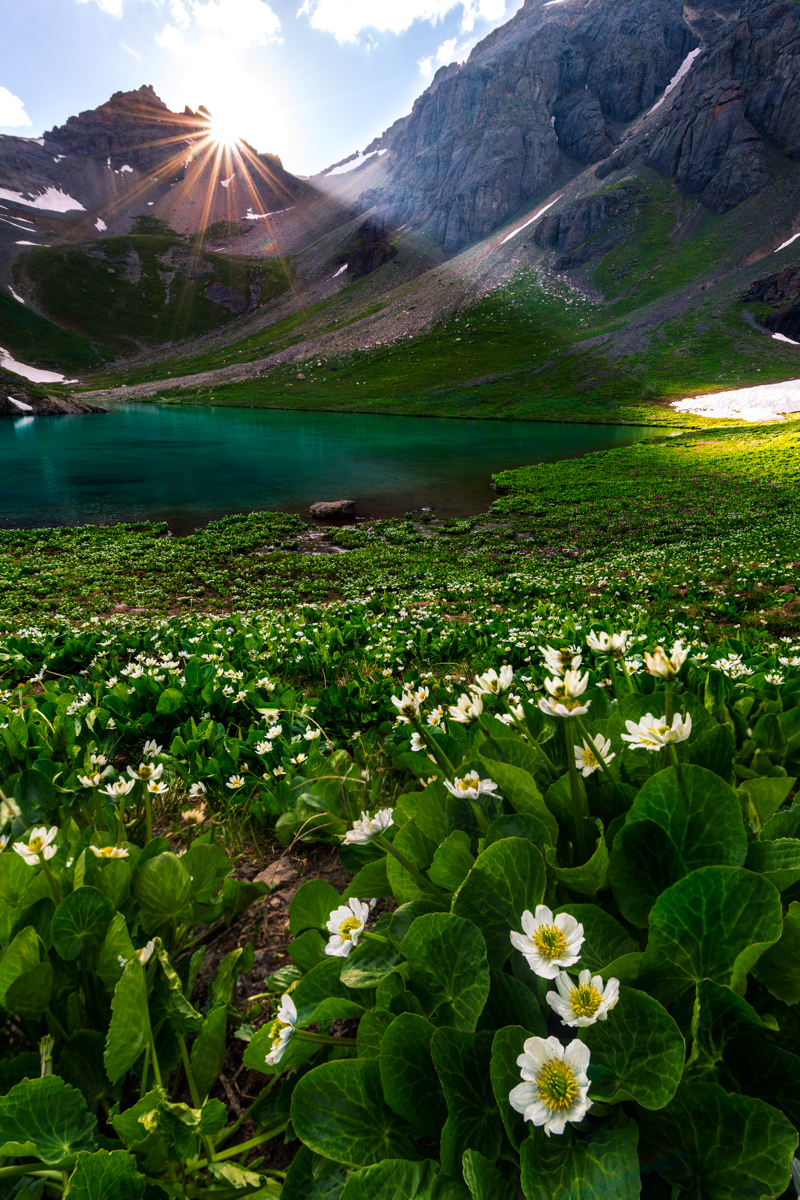
The last light left an impression on the fireweed that I knew would look fantastic in camera. I think I was right.
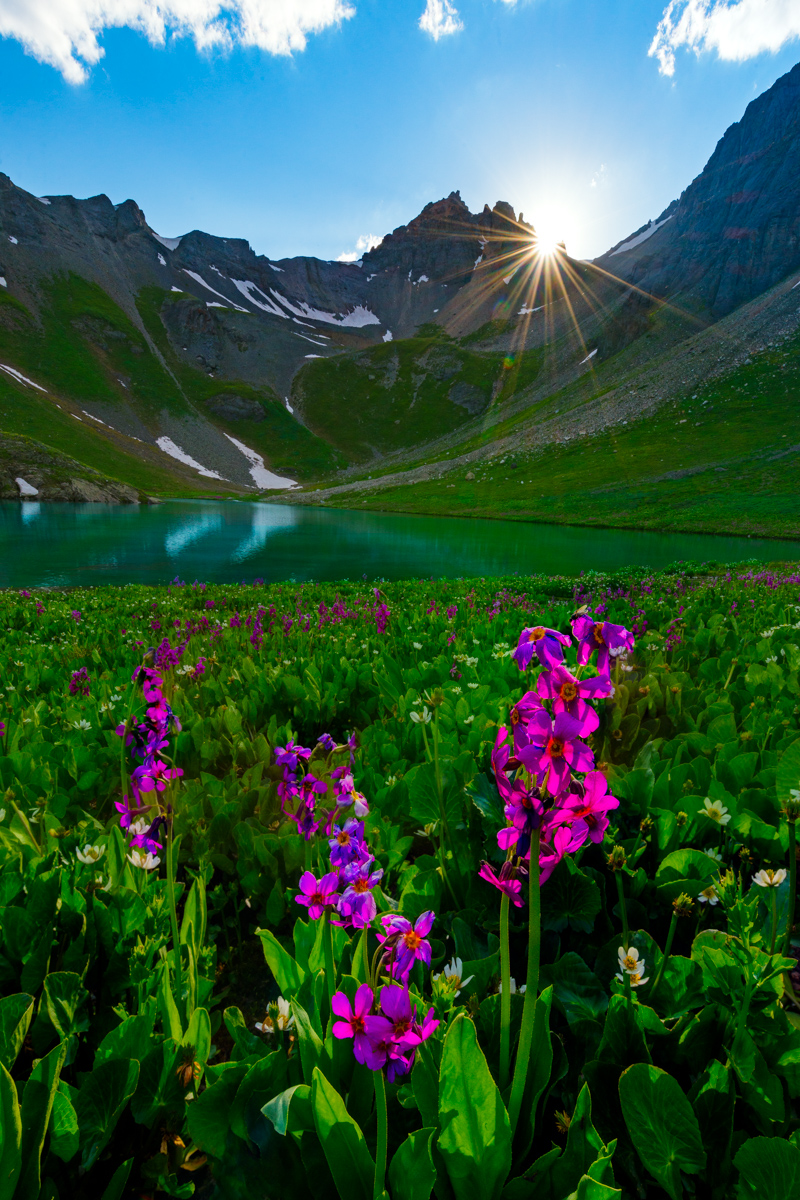
After dinner, I decided that I wanted to hike back up to the top of the grassy area below the ridge for U.S. Grant. I know that sounds crazy but I had a vision for some shots looking back over the lake at sunset. I hoped the clouds would stick around, and they were looking like they might, so I took a chance and hiked back up the mountain again. Todd thankfully joined me and kept me company. Unfortunately, the clouds did not cooperate much, but I think I still got some decent shots, including one with the nearly full moon in it.
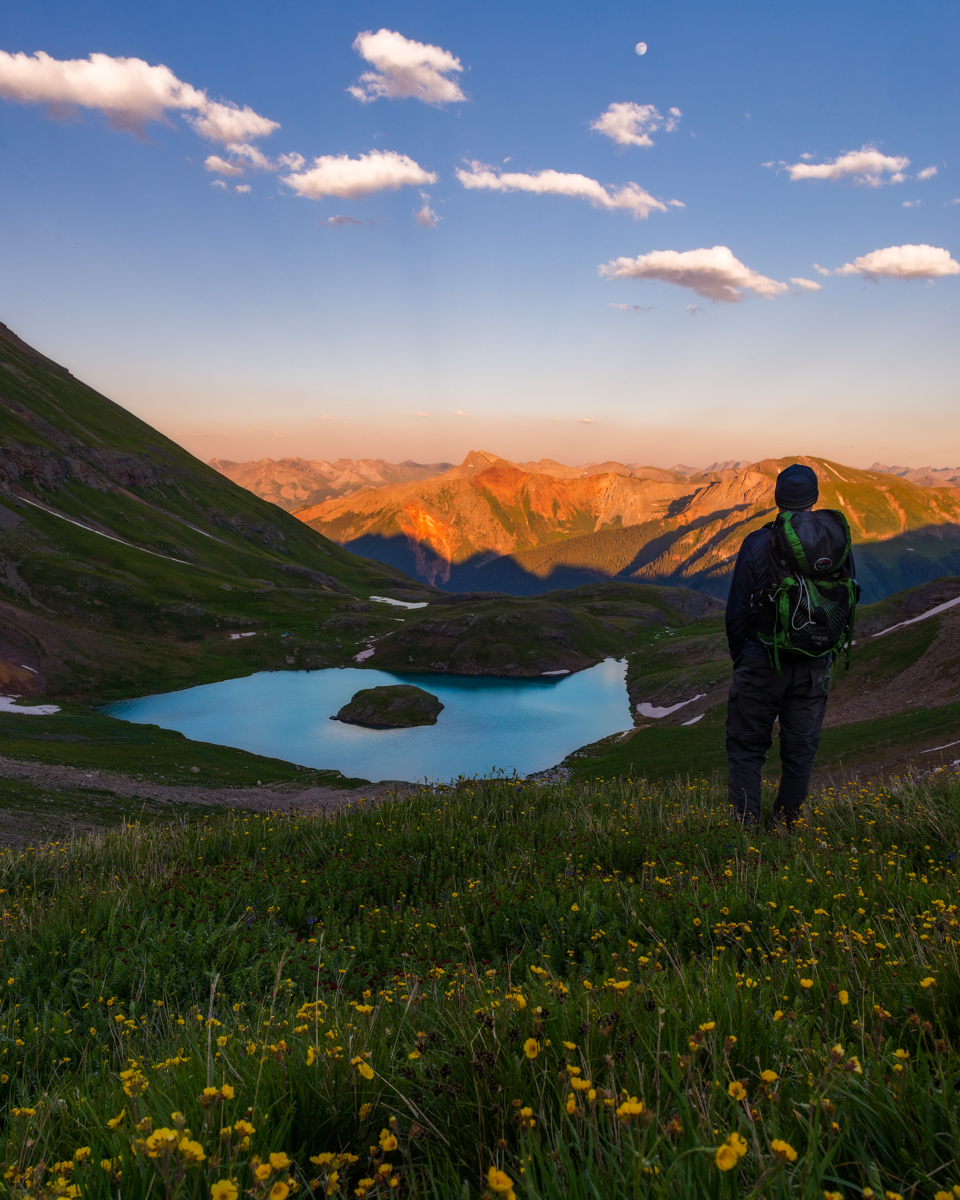
As the last light kissed the tops of the Chicago Basin 14ers, I took advantage and snapped off a two-row panorama to include the pink sky (which was a bit hazy from fire I presume), the lake, and some wildflowers.
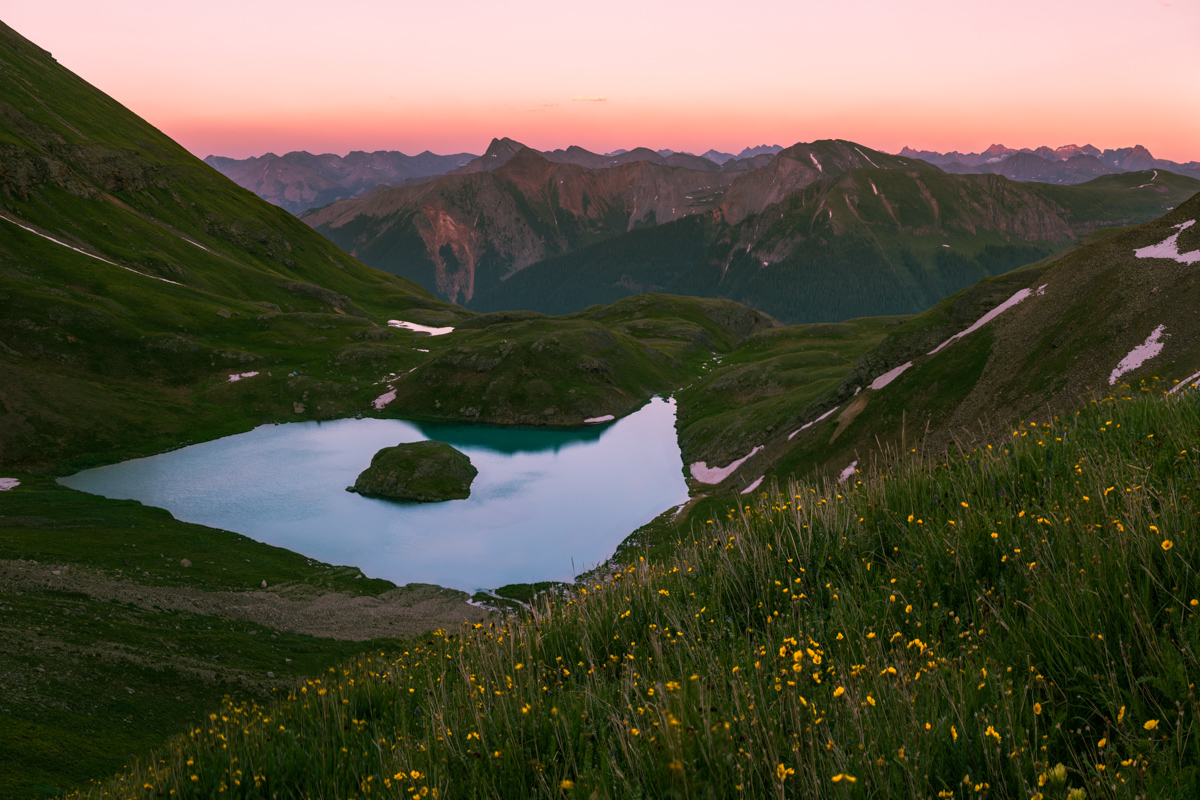
It was quite a memorable sunset, for sure. Flowers + sunset + Island Lake + San Juan Mountains in alpenglow = awesome.
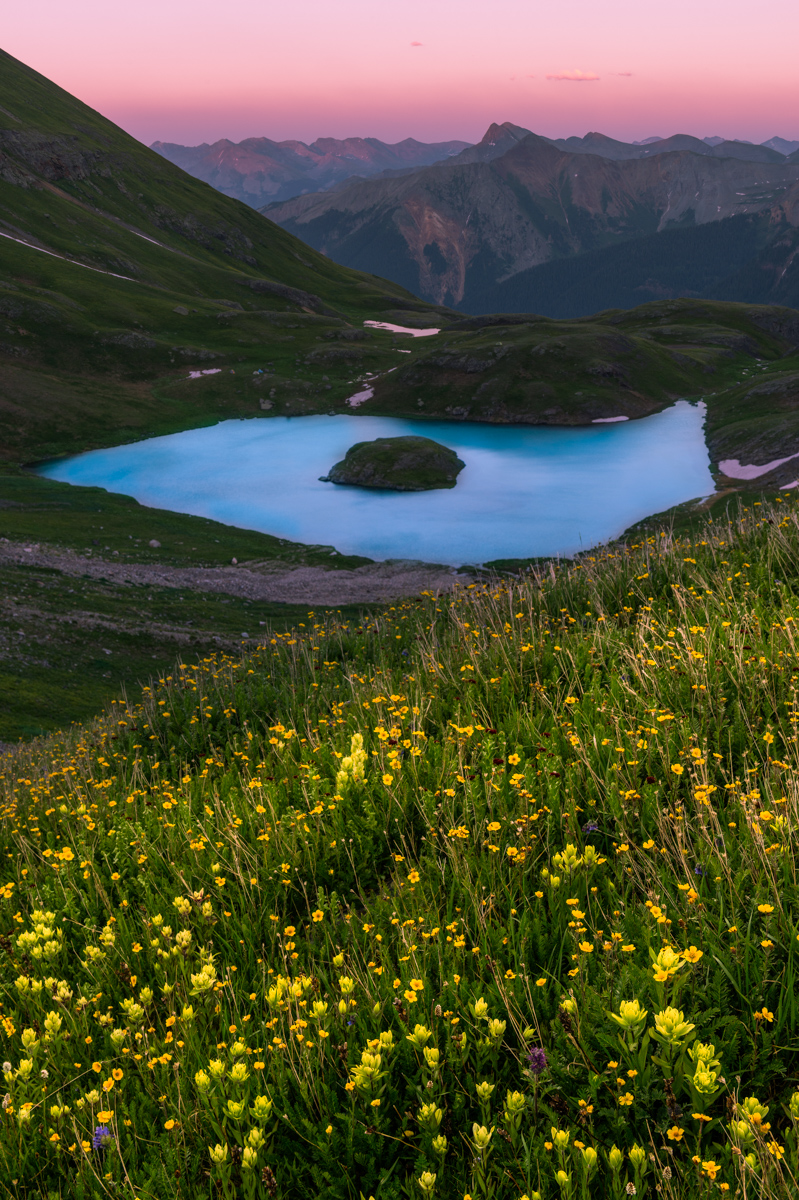
We head back down to our tents and got some much needed sleep. I never did make it over to Ice Lake for sunrise wildflower photos. Maybe next year! As a reminder, you can take a look at my GPS and/or KML file for this hike over on Gaia GPS. Prints of my photos are always available on my photography website (if you see one you like and can't find it, let me know). Thanks for reading!
Top 5 Stunning Colorado Locations
Colorado is easily one of the most scenic places in the whole world, so creating this set of lists was not an easy task by any stretch of the imagination. Having lived in Colorado my whole life and having visited nearly every mountain range the State has to offer, I wanted to reflect on my absolute favorite locations as well as highlight the places I’ve not yet visited. If you’ve not yet had the opportunity to visit some of these places, I would highly recommend that you do so immediately! Without further ado, here is my list of the top five stunning locations in Colorado that I have visited:
- Vestal Basin. Vestal Basin is a very remote valley located deep within the Weminuche Wilderness Area 32 miles northeast of Durango, Colorado. The surrounding mountains are members of the Grenadier Range, which is a sub-range of the San Juan Mountains. Vestal Basin is home to one of the most aesthetically inspiring mountains in Colorado, Vestal Peak. Vestal Peak towers above the basin in a upwards sloping fashion and contains one of the most classic climbs in all of Colorado up what is known as Wham Ridge. Vestal Peak is easily recognized from all directions by the dramatic and awe-inspiring Wham Ridge. Next door to Vestal Peak lies the also impressive Arrow Peak, which also has similar traits, in that it rises to the sky in a very dramatic fashion. A trip up these two incredible peaks should be on any serious Colorado mountaineer’s bucket list.
- Capitol Lake / Elk Mountains. Capitol Lake sits at the base of Capitol Peak, located deep within the Elk Mountains 13 miles west of Aspen, Colorado. Access to some of Colorado’s most stunning peaks is granted from this location, including the challenging task of summiting Capitol Peak via its famous Knife Edge. Once above tree-line, views of other famous peaks, such as The Maroon Bells and Pyramid Peak are seen to the southeast. The Elk Mountains are a truly magical place to behold.
- Mount Sneffels Wilderness Area. This pristine wilderness area is located 10 miles south of the town of Ridgway, Colorado in the San Juan Mountains. The area is home to the famous Yankee Boy Basin and several incredible mountains within the highest 100 of Colorado, including Mount Sneffels, Teakettle Mountain and Dallas Peak. Dallas Peak is arguably the most difficult mountain to climb out of the highest 100 in Colorado. The rugged terrain and incredible foliage located in this area are something every visitor to Colorado should take time to see. Especially beautiful in the fall, the wilderness area’s aspen trees change to a magical display of deep gold, red and yellow, all with the dramatic and spectacular Mount Sneffels in the background. This area is a must-see for natives and out-of-state visitors alike.
- Colony Lakes / Cottonwood Creek. These two magical lakes rest at the eastern base of Crestone Needle, Crestone Peak and Humboldt Peak in the Sangre de Cristo Range, 13 miles southwest of the town of Westcliffe, Colorado. Cottonwood Creek runs on the western side of Crestone Peak and Crestone Needle and provides remote access to one of the densest, most pristine wilderness Colorado has to offer. Unfortunately, access to Cottonwood Creek is currently problematic due some private property complications at the trailhead near Crestone, Colorado. Hopefully this area will be opened back up someday so that others can fully appreciate the natural wonder and beauty this area has to offer. Access to the Colony Lakes is still available by way of a four-wheel drive road that recently was re-developed by the Forest Service. There is plenty of controversy surrounding this access point as well, due to damage to the ecosystem at the lakes above.
- Highland Mary Lakes. Highland Mary Lakes are some of the most remote lakes in Colorado located quite deep within the Weminuche Wilderness Area in the San Juan Mountains, southeast of Silverton, Colorado. The lakes are located on the Colorado Trail on a stretch of earth that is completely above tree-line for several miles in each direction. It is truly insane to be on such an elevated plateau with some of Colorado most splendid mountain vistas surrounding you. This location is a favorite attraction of mountain goats as well. An amazing 3-5 day backpacking trip can be made by traveling from north to south or south to north from the silverton-side trailhead of these lakes all the way to Vallecito Reservior or vice-versa. The trek is truly magnificent. Be sure to coordinate a car shuttle ahead of time!

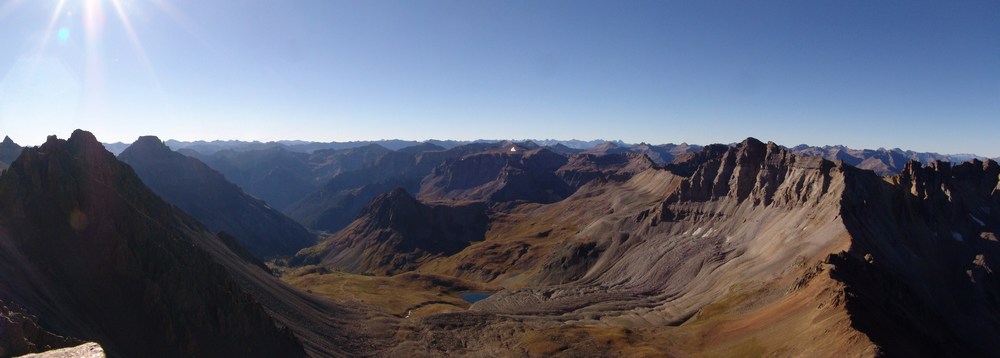
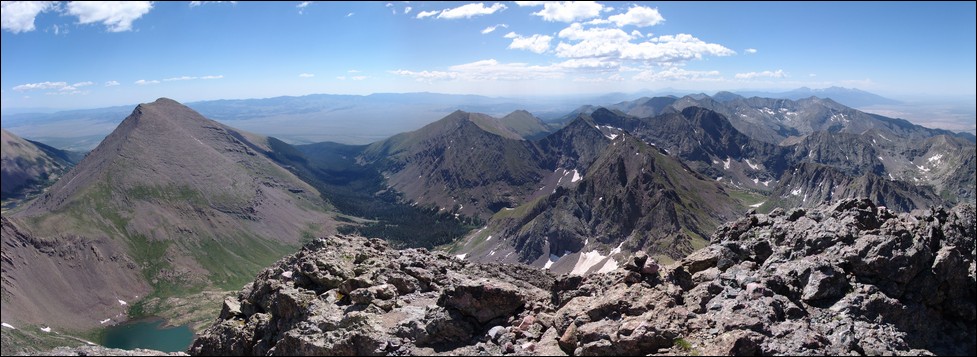
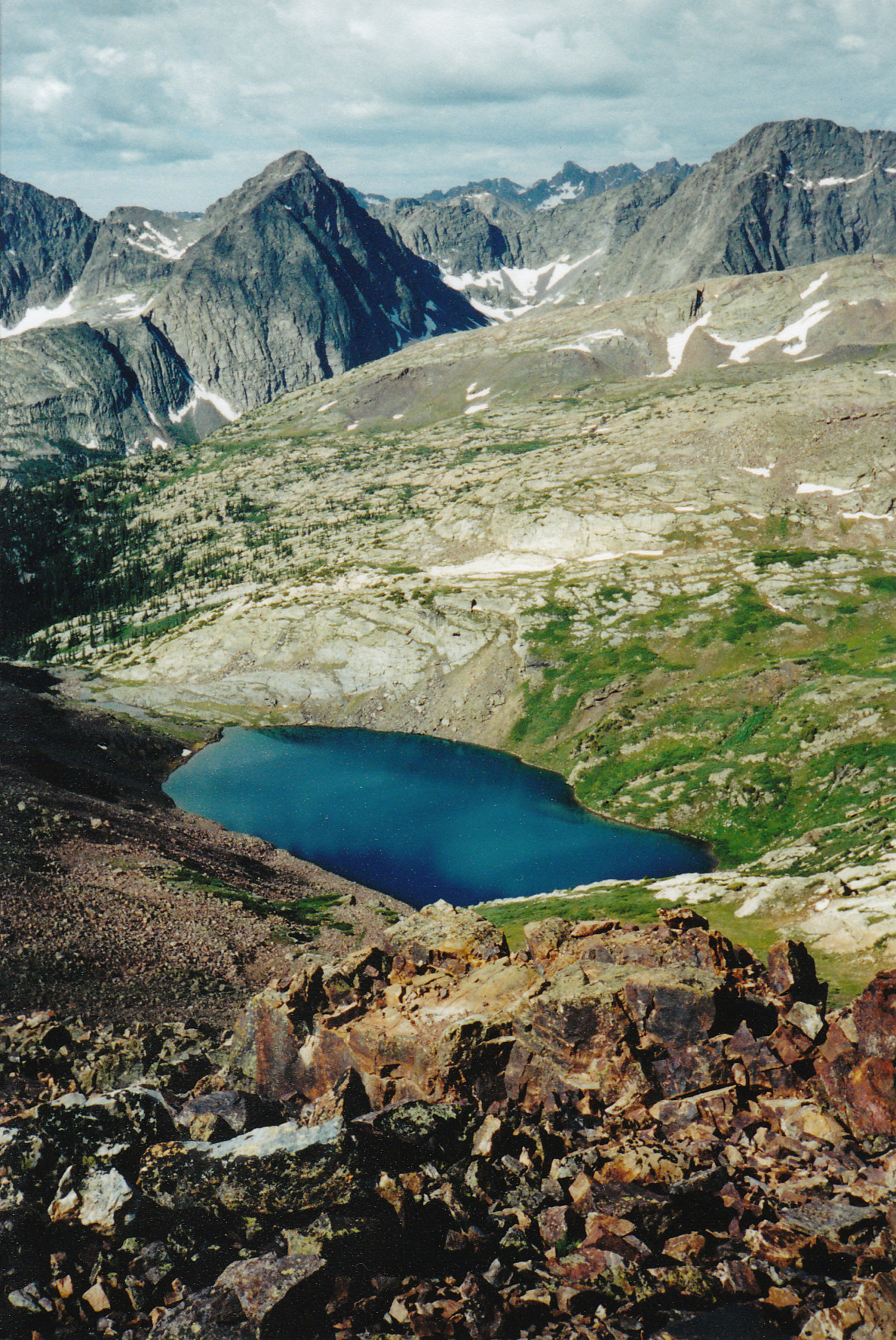
-
The top 5 places in Colorado that I’d like to visit but not had a chance to yet:
- Ice Lake Basin. Ice Lake Basin is a remote area west of Silverton, Colorado. From what I understand, this is one of the most incredible places in Colorado and I cannot wait to see it myself. The basin provides access to some of Colorado’s greatest peaks, including U.S. Grant Peak, Pilot Knob, Vermillion Peak and Fuller Peak.
- Chicago Basin. Chicago Basin is home to three of Colorado’s 14ers, Sunlight Peak, Windom Peak and Eolus Peak. Located deep within the San Juan Mountains’ Needle sub-range, these mountains are quite possibly some of the most photogenic and rugged looking out of any set in the State. While travel to the area is popular due to the access provided for the area’s 14ers, it is still tops on my list of places to visit.
- Indian Peaks Wilderness Area. Indian Peaks Wilderness Area is located northwest of Denver, Colorado, just south of Rocky Mountain National Park. While this area boasts no 14ers and only one peak over 13,500 ft, it is apparently a very pristine mountain range full of incredible hikes and challenging climbs.
- Gore Range. The Gore Range is a relatively unknown area north of Vail, Colorado and obtains some of Colorado’s most glaciated and rugged looking peaks. Many mountains in this range have never been named, mostly because of the remoteness of the area.
- West Elk Wilderness Area. This swath of wilderness is located north of Crested Butte, Colorado is home to some of the most insane images of autumn colors ever imaginable.
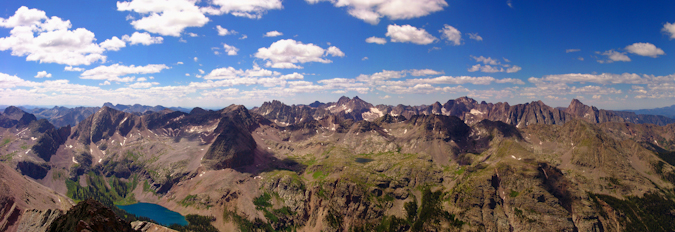

Photo by KAE Photography
What areas not covered have you been to that you’d like to share? Have any places you have yet to visit that you want to? I’d love to hear about your thoughts.
{fcomment}
Handies Peak and Whitecross Mountain - a sweet San Juan saunter
Hiking in the San Juan Mountains was quite possibly the best gift a dad could get. Make that two dads.
My dad is who introduced me to climbing mountains at the young age of six, and it was fitting that we spend Father's day climbing a mountain that we had both had our eyes on for quite a few years. While my dad had originally planned in the 1980's to save Handies Peak as his last 14er, he decided to give up that idea. The last time my dad climbed a 14er was Uncompahgre Peak in 2001 - another father-son outing in the San Juan Mountains, nearly 10 years ago. Having prepared for the past two months through rigorous training and exercise, my dad, now 60 years old, believed he was ready again for climbing. Since all I talk about anymore is climbing mountains, it was no surprise that his interest in climbing is renewed and I was very pleased that he asked to join me on my attempt of Handies Peak. My dad (Old Climber on this site) and I debarked from Colorado Springs at roughly 5:00 PM on Friday, June 18th 2010, heading straight for the rugged San Juan Mountains in southwestern Colorado. We drove south down State Highway 115 and connected with Highway 50 heading west. We stopped for a bite to eat in Salida and drove to Gunnison and south towards Lake City. The drive up towards Cinnamon Pass from Lake City was a somewhat confusing one in the dark - there are a couple points where you can make a wrong turn - neither intersection having been mentioned on the route description at 14ers.com. To top things off, the road was pretty rough, but my Jeep handled it like a champion. We managed to find our way to the American Basin near Handies Peak and began setting up camp with our headlamps on at around 11:30 PM.
Here are some interesting statistics from this amazing adventure:
Total elevation gain: 3,629 ft.
Total distance hiked: 8.22 miles
Total time hiking: 8 hours, 15 minutes
Total photos taken: 346
Total wildlife sightings: 3
Total distance driven: 480 miles
Trip duration: 28 hours
A map of our driving route to our campsite in the American Basin from Colorado Springs
As we began setting up camp, I turned back towards my vehicle to see two glowing eyes about 20 feet away. These were no ordinary glowing eyes - these were quite large and clearly fit a very large animal. I whispered to my dad, "Ray - look - there is an animal over there!" Ray got out his flashlight and revealed a giant moose! We were both in shock, as neither of us had seen a moose in the wild in Colorado before. The moose walked around our campsite for much of the remainder of the night and at one point got within 5 feet of the tent before walking away. I decided to name the moose "Tim" since I thought it would be funnier and more convenient to refer to the moose by name instead of "it" or "moose."
The moon was about half-full and lit the basin up quite well. We could make out the ridge line of Handies Peak and the American Basin crags (American Peak, ranked 102nd highest in Colorado).
We enjoyed the views of the basin in the moonlight and set the alarm on my Suunto Core watch for 5 AM. The tent was sitting on a lot of wierd bumps, so sleeping was not the easiest of tasks. I think I did get a few hours of pretty spotty sleep before the alarm went off. We woke up and broke down our camp pretty quickly while eating some oatmeal. "Tim" was still hanging around, eating some willow trees 50 or so yards away from our campsite. We prepared our packs and debarked up the road towards the trailhead, but not before taking a photo of the basin around our campsite.

Handies Peak seen at left of center with American Peak at dead center and UN 13,512 at far right. The American Basin is a very peaceful locale.
The plan for the day was to ascend Handies Peak (14,048 ft. and ranked 40th in Colorado) via the standard trail and then to traverse over to Whitecross Mountain (ranked 222) to the northeast of Handies. Starting the hike pretty early and at a respectable elevation, I believed that the itinerary would be quite manageable.
A topo map with my route shown in red. We began the hike near the word "Fork" on the map.
Ray and I quickly began the hike up the trail at 6:15 AM and within minutes, the sun began to light up the surrounding peaks, including American Peak.

American Peak gets a healthy dose of sunlight.
The basin itself was quite serene, with waterfalls everywhere and green slopes and orange mountain tops surrounding us in all directions.

Ray Payne with an awesome waterfall in the background
We probably could have made better time, but I was taking tons of photos the whole way up!
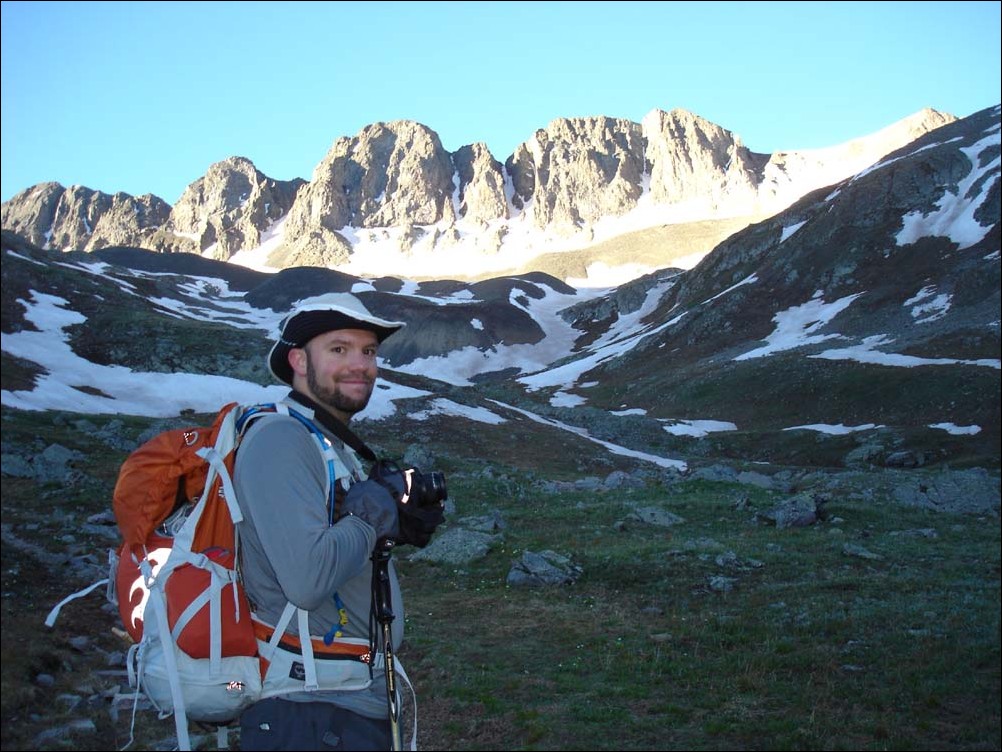
Matt Payne with American Peak in the background.
The trail was mostly snow-free, with a few sections of snow obscuring the trail. We were able to quickly follow the trail up the side of Handies Peak, weaving our way up towards Sloan Lake.
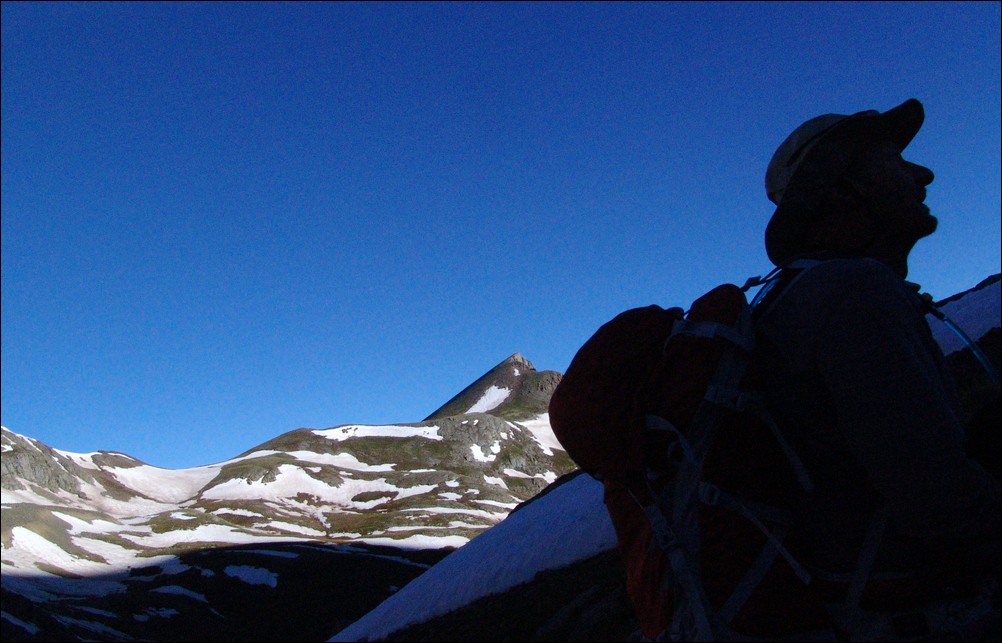
Ray Payne gazes up the side of the relatively steep trail leading up Handies.
Shortly before reaching the turn-off for Sloan Lake, I stumbled across a beautiful ptarmagin, still in the process of changing out of its winter coat and into its summer colors.
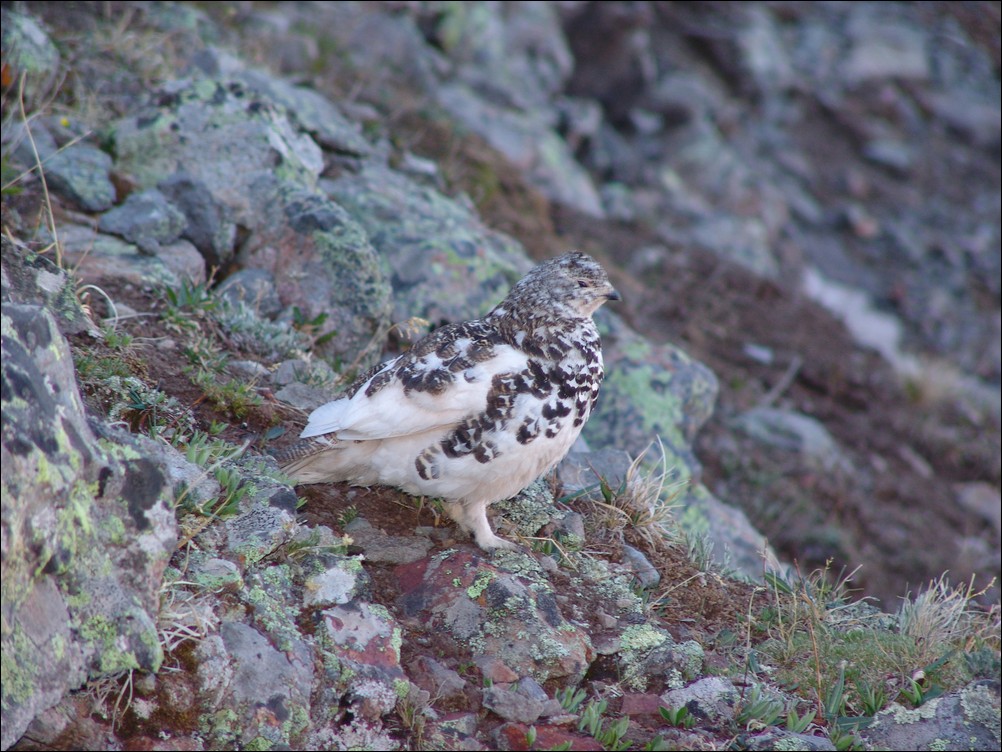
A ptarmigan rests on rocks near the trail leading up Handies Peak.
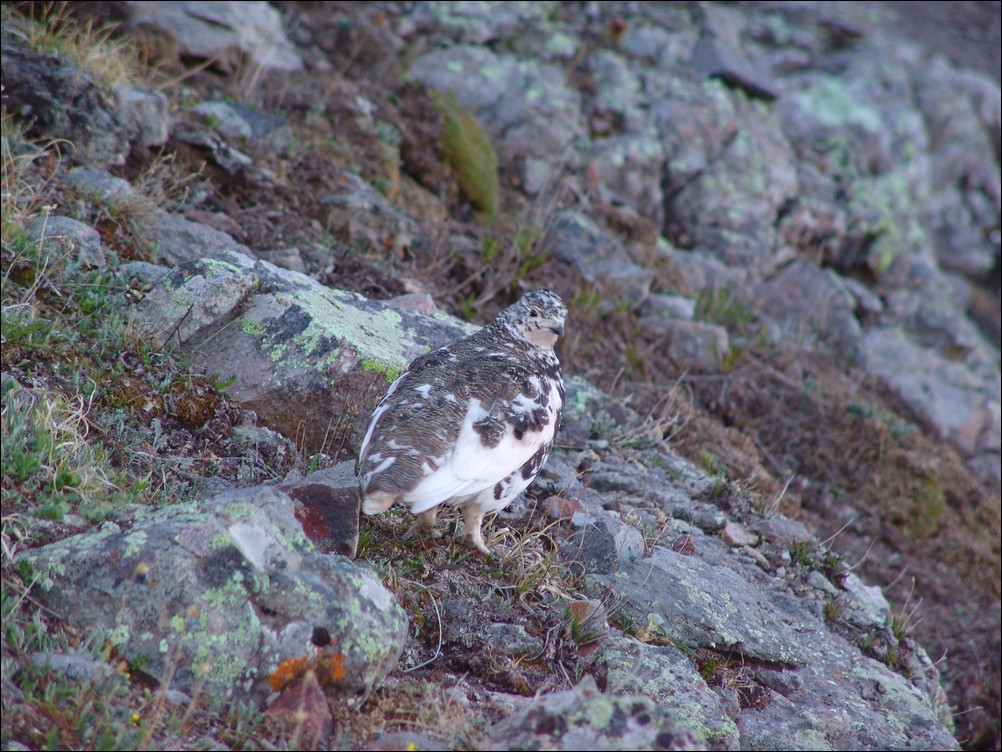
The ptarmigan peers back at me, wondering if it is on the menu for dinner.
The ptarmigan made a loud squak and flew down the trail and away from our threatening gaze. What a pleasure it was to see wildlife!
Shortly after heading away from Sloan Lake, the trail turns back towards Handies and down through a small snowfield. The snow was steep but easy to navigate.
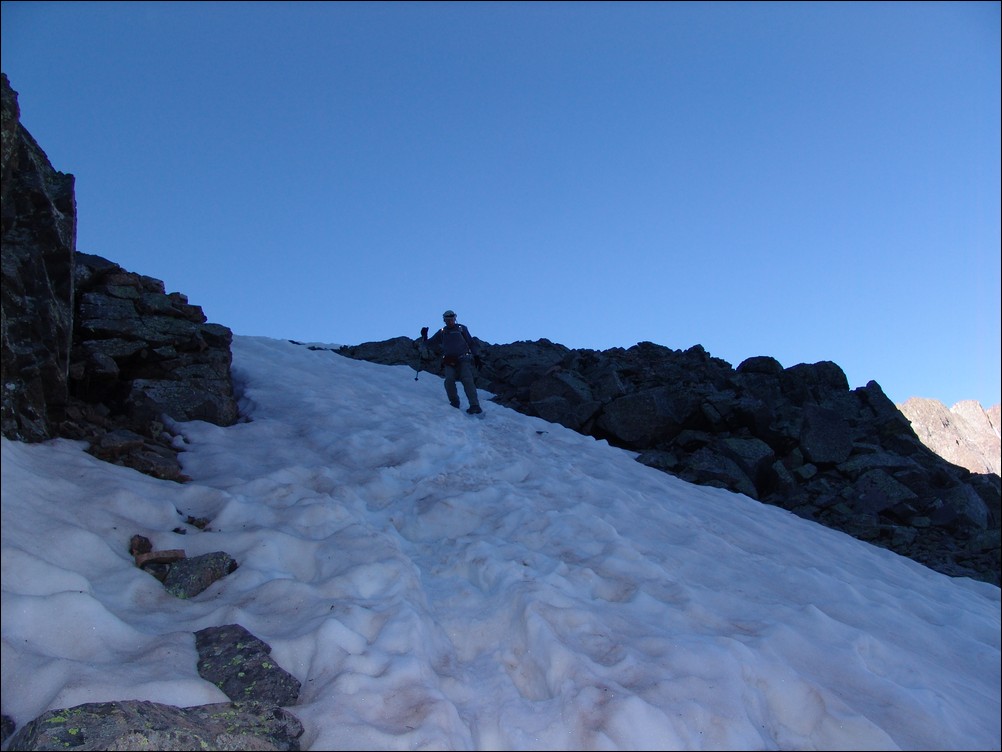
Ray navigates through a steep snow field.
The trail quickly zig-zags up Handies and before we knew it, we gained some incredible views back down into the American Basin.

Sloan Lake sits in front of American Peak, with the Handies standard route trail below. The first view of distant San Juan Mountains is revealed.
We rested in the shadows for a bit and resumed the hike up towards the saddle between Handies Peak and American Peak. Once gaining the saddle, views east into the next valley over were presented with the morning sun welcoming us.

A 360o view from the Handies - American Peak saddle. As a reminder - many images can be clicked on to view the full resolution versions!
We continued up towards the summit of Handies and were wildly surprised with a view of Rio Grande Pyramid, one of the top 100 summits in Colorado (ranked 97).
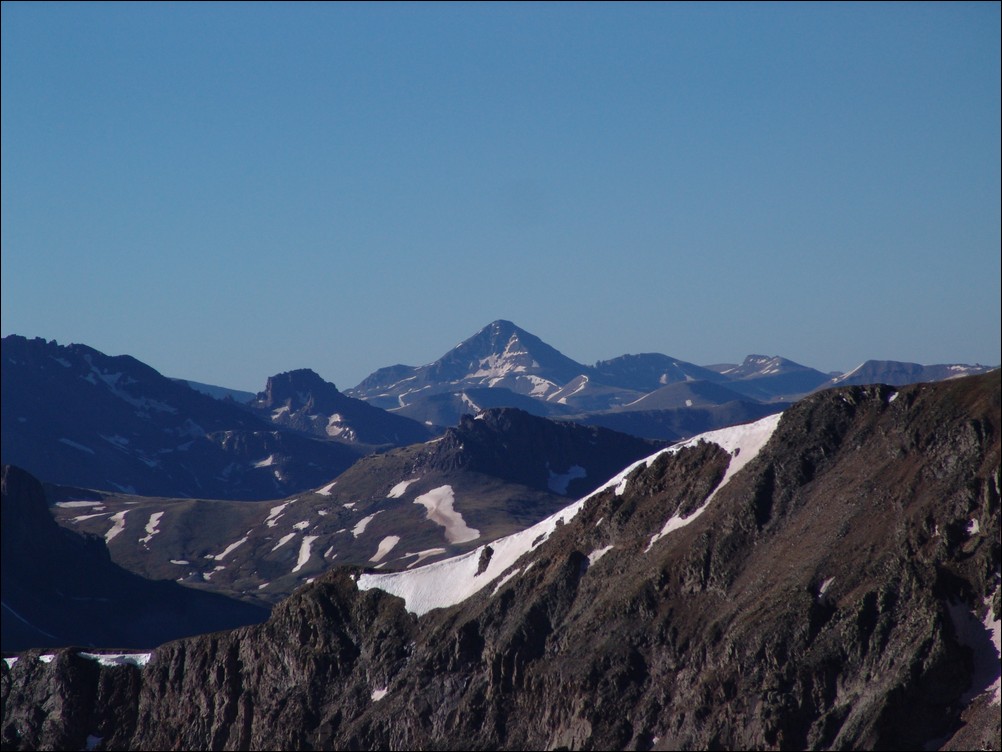
Rio Grande Pyramid sits prominently in the far distance to the south of Handies Peak.
This was a particularly exciting discovery for Ray and I since we are planning to climb Rio Grande Pyramid at the end of August of this year. Getting a first-hand view of this magnificent mountain was quite awesome.
We also could not help but notice the other quite prominent mountain sitting in front of Rio Grande Pyramid Peak on the near side of Pole Creek Mountain (ranked 138th in Colorado) - Half Peak (ranked 86th in Colorado).
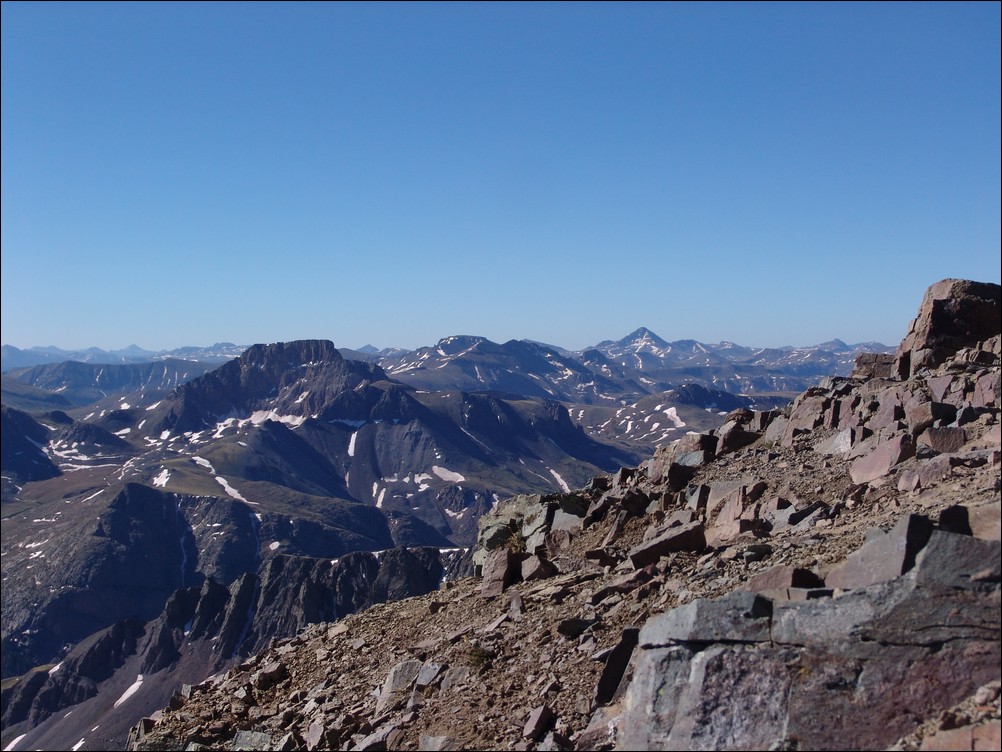
Half Peak (left of center) sits left (northeast) of Pole Creek Mountain, and Rio Grande Pyramid.
Additionally, views of Mount Sneffles (ranked 27th in Colorado) and the surrounding mountains came into view.
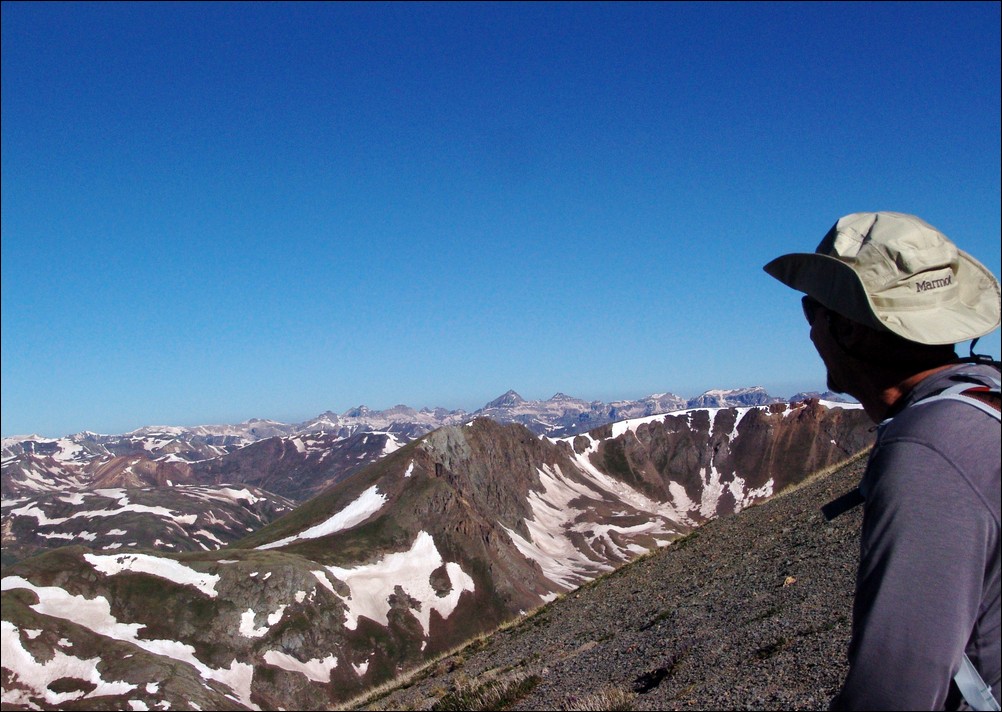
Ray Payne gazes towards Mount Sneffels to the northwest.
Ray snapped a shot of me before I continued up the trail.
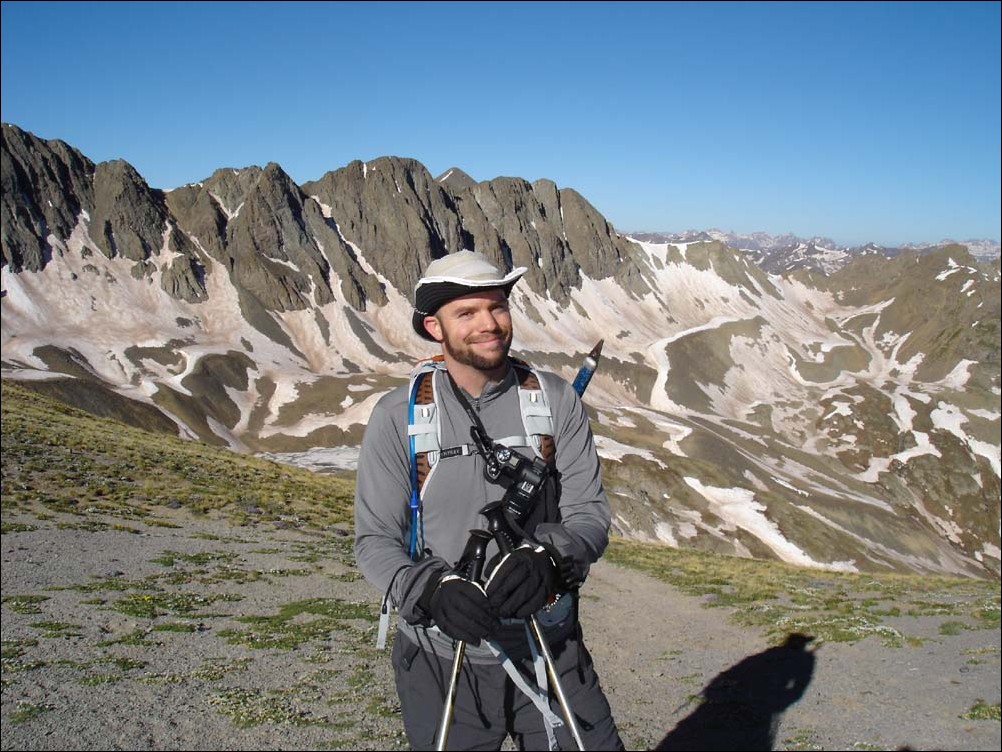
Having gained the amazing views of the San Juans, I was re-energized to hike faster, so I quickly made my way up towards the summit of Handies. I peered back to catch the first glimpse of the Grenadiers and Needle Mountains near Silverton. I have always been completely awe-struck by these mountains, so seeing them from here was quite exciting for me. Views of Pigeon Peak (ranked 57), Vestal Peak (ranked 77), and Arrow Peak (ranked 104) were impressive. Due to the fact that I am climbing Vestal's Wham Ridge and Arrow Peak in three weeks, this view was especially awesome.
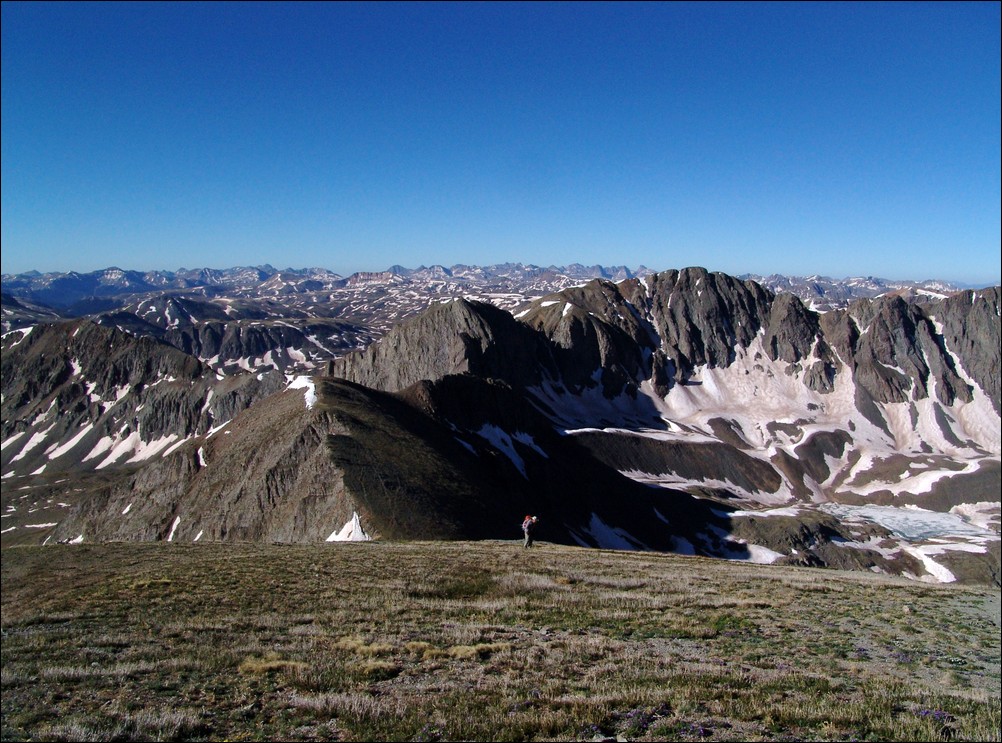
Ray Payne ascends Handies with the Grenadier range and Needle Mountains showing themselves above American Peak. Pigeon Peak seen just above American Peak, with Arrow and Vestal Peaks to its left.
I was able to complete the climb of Handies at 9 AM, a brisk 2 hours and 45 minutes after we started, and was greeted at the top by Ray within minutes. Handies was the 48th 14er for Ray and the 36th 14er for me.
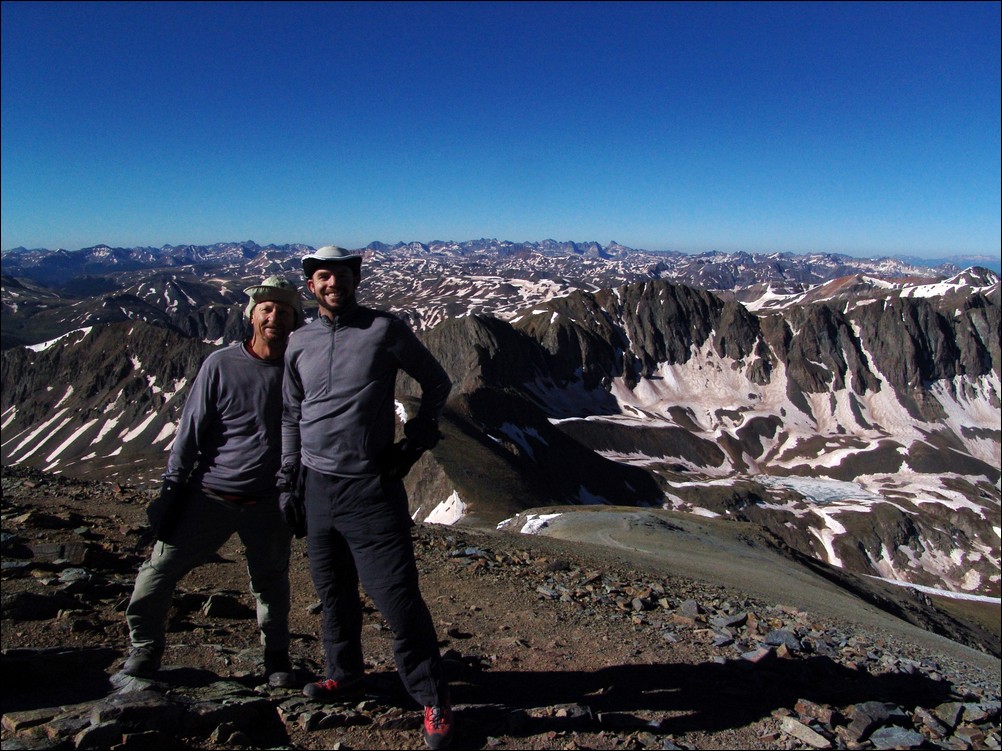
Matt and Ray Payne celebrate on top of Handies with the Grendiers and Needle Mountains in the background.
The wind on top was fairly chilly, so Ray and I found shelter on the eastern side of the summit. Ray got out his topographical maps and I began to take my ritual photos for the 360 degree panoramic photo from the summit. The views from Handies were much more impressive than I could have ever imagined.
A 360o view from the top of Handies Peak. The views of the mighty San Juan Mountains were astounding. Click on the image for the full resolution version (very large).

A 180o view looking northeast to west from Handies Peak.
I continued to marvel at the sheer impressiveness of the Grenadiers. The thought of climbing them in a few weeks seemed very surreal. Vestal's Wham Ridge looked impossible.
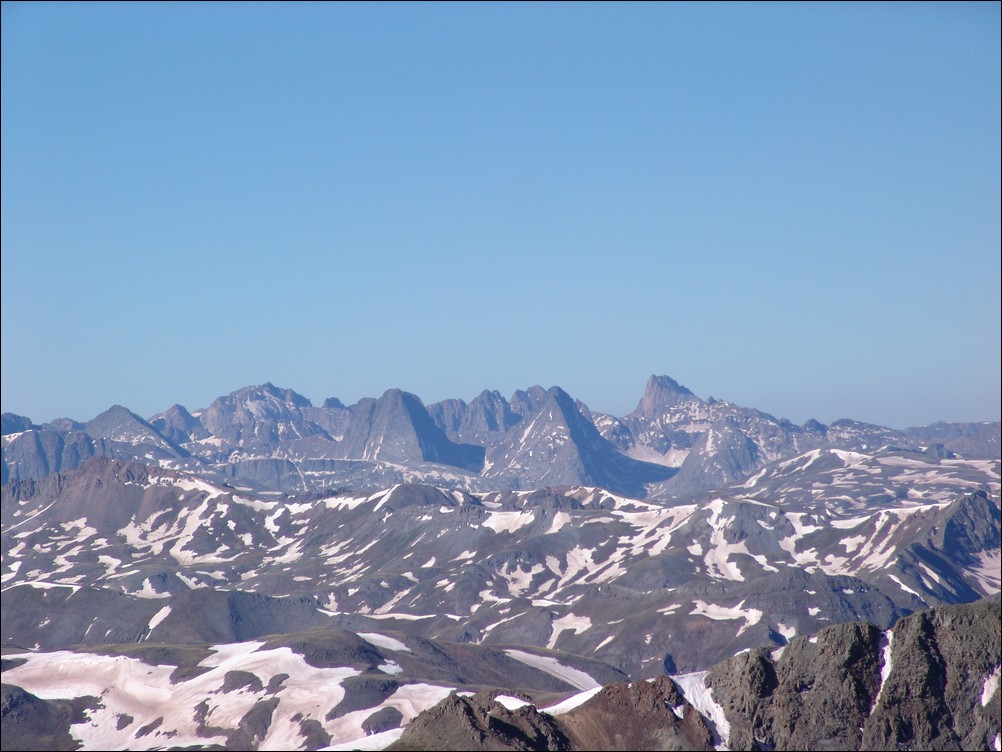
The Grenadiers and Needle Mountains zoomed in.
Views of other areas of the San Juans also did not disappoint. The Ice Lake Basin and Wilson group were quite impressive as well.

Looking west from the summit of Handies Peak
In my office at work, I have a framed topographical map composed of many different 7.5 minute maps of the Grenadiers and Needle Mountains. I had always wanted to capture a comprehensive photo of that area, showing the various summits of the region. I had a great time using the 100summits.com Google Earth plugin tool to attempt to correctly identify all of the mountains in the following giant panoramic photo. I would greatly welcome and appreciate any feedback or corrections to the labels, as the viewpoint from Handies made for a distorting and confusing process for peak identification. Be sure to click on the images to see the full resolution versions and the labeled photo (2nd photo).

A large zoomed-in panoramic photo of the San Juan Mountains.

Many mountains are labeled in this version. Send corrections to This email address is being protected from spambots. You need JavaScript enabled to view it.
For a more natural way of viewing this photo, check out THIS PAGE.
Views of both Wetterhorn Peak and Uncompahgre to the north were also outstanding.
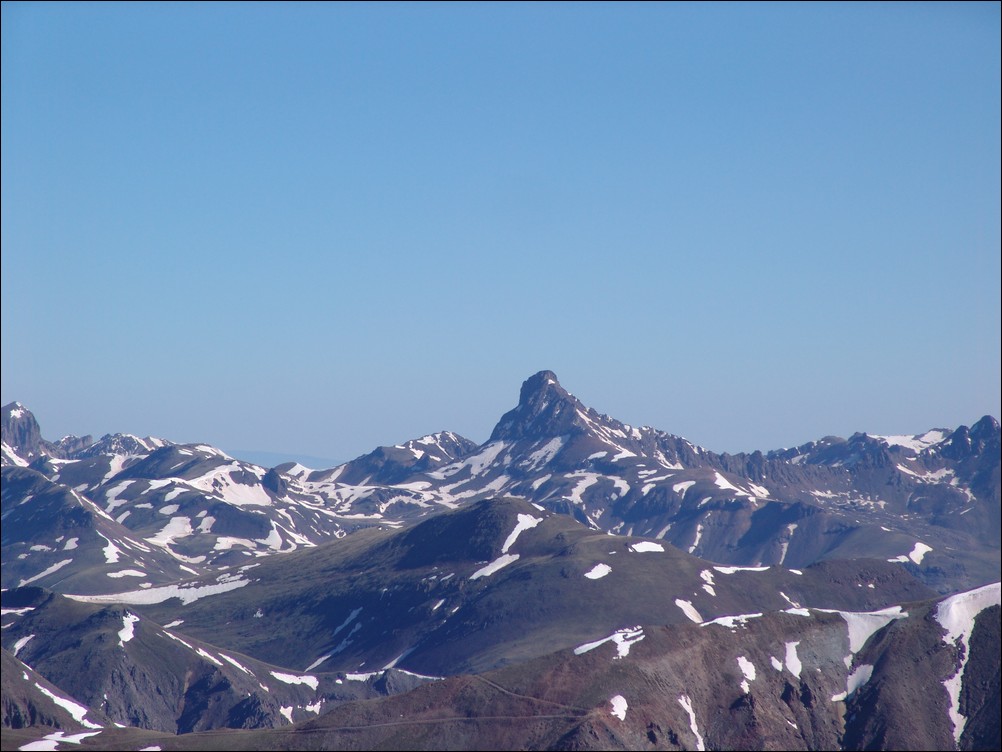
Wetterhorn Peak
Wetterhorn Peak (left of center) and Uncompahgre Peak (right of center) rise up impressively to the north of Handies
Looking further west, were able to identify Mount Sneffels and Teakettle Mountain (ranked 98th).
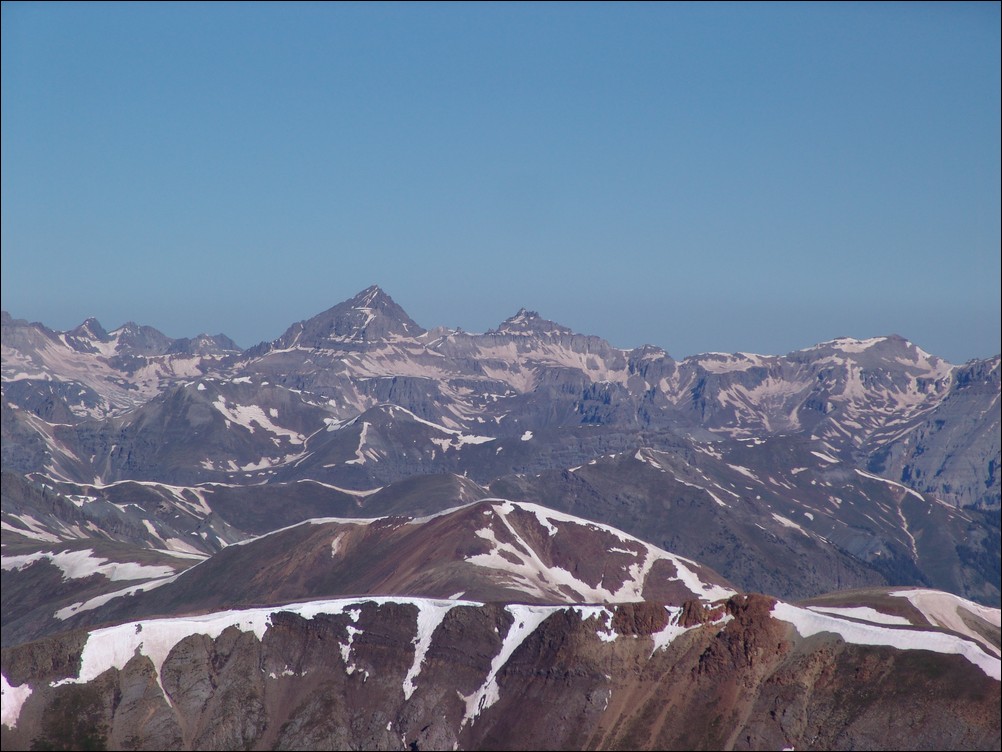
Mount Sneffels (largest at center) and Teakettle Mountain (right of Sneffels)
Due west of our position on Handies, were caught view of the Ice Lake Basin. We originally thought this was the Sneffels group; however, upon further investigation, we believe we have correctly identified the mountains west of Handies as U.S. Grant Peak (ranked 119) et.al.
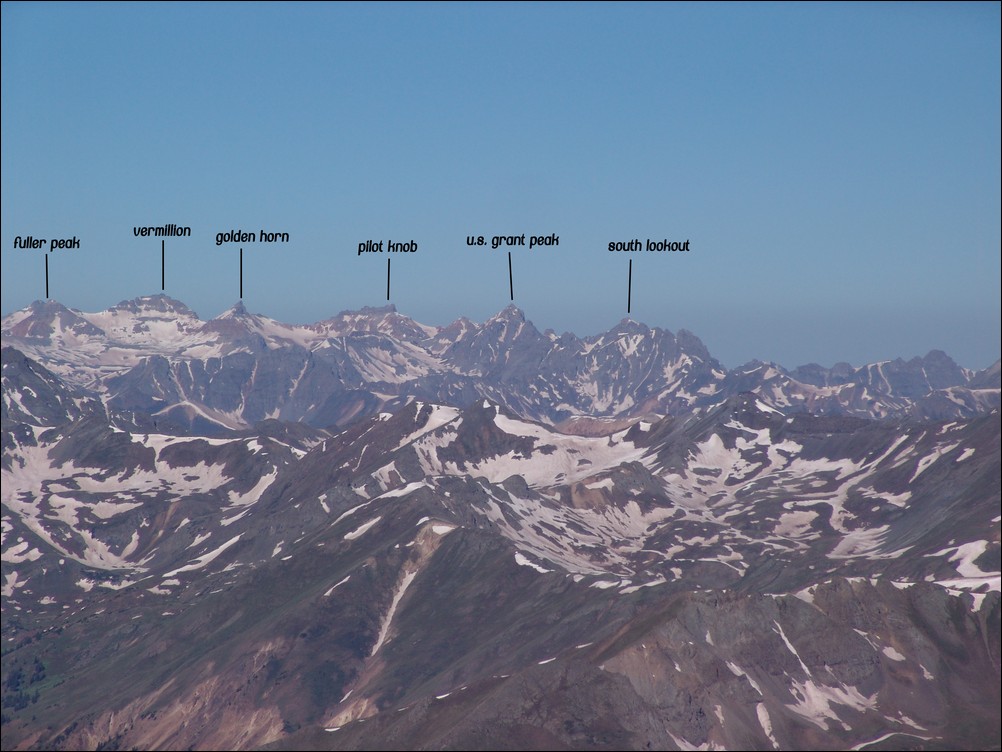
The Ice Lake Basin - send corrections to Matt at This email address is being protected from spambots. You need JavaScript enabled to view it.
After the whirlwind of photo taking, I decided to sit-down and eat some food. Ray ate his hard-boiled egg (apparently a long-standing tradition for him), while I chowed down on a Clif Bar and some cashews.
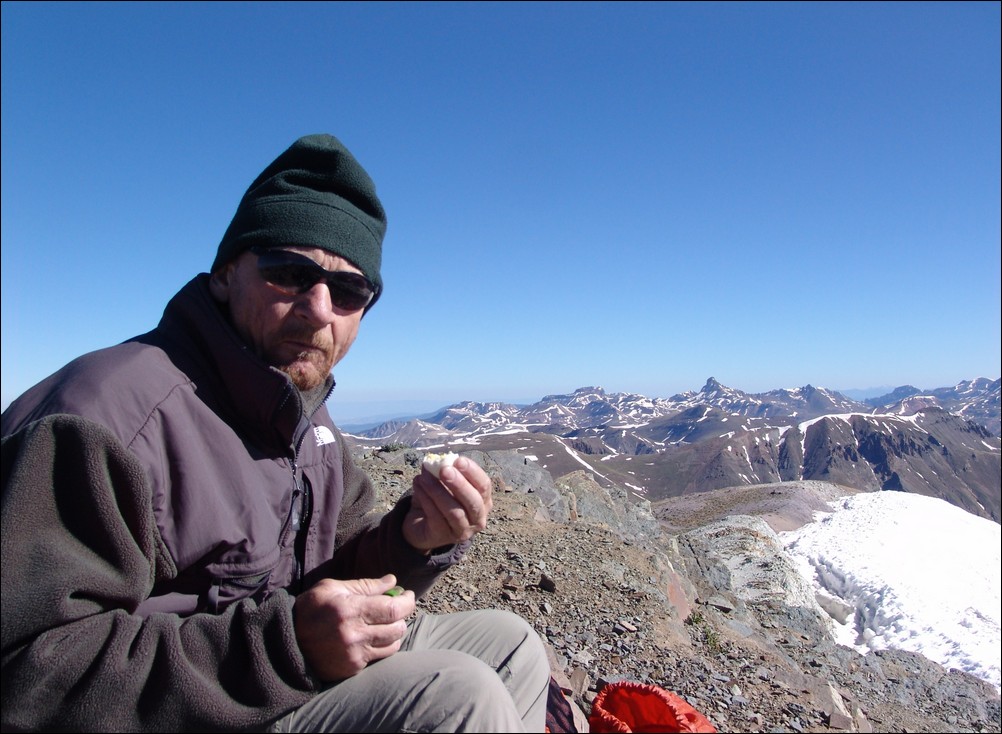
Ray chows down on a hard-boiled egg with Wetterhorn Peak behind him.
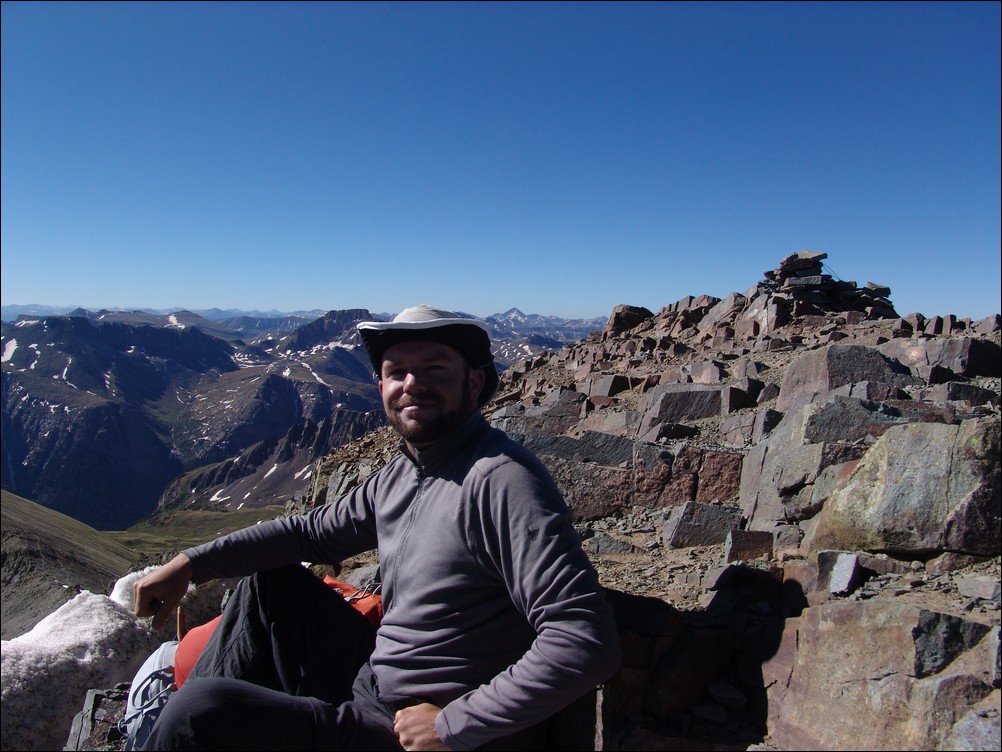
Matt Payne relaxes on the summit of Handies.
Sitting on the east side of Handies to eat, we were able to get a great view of Grizzly Gulch, Sunshine Peak and Redcloud Peak (ranked 53 and 46 respectively).
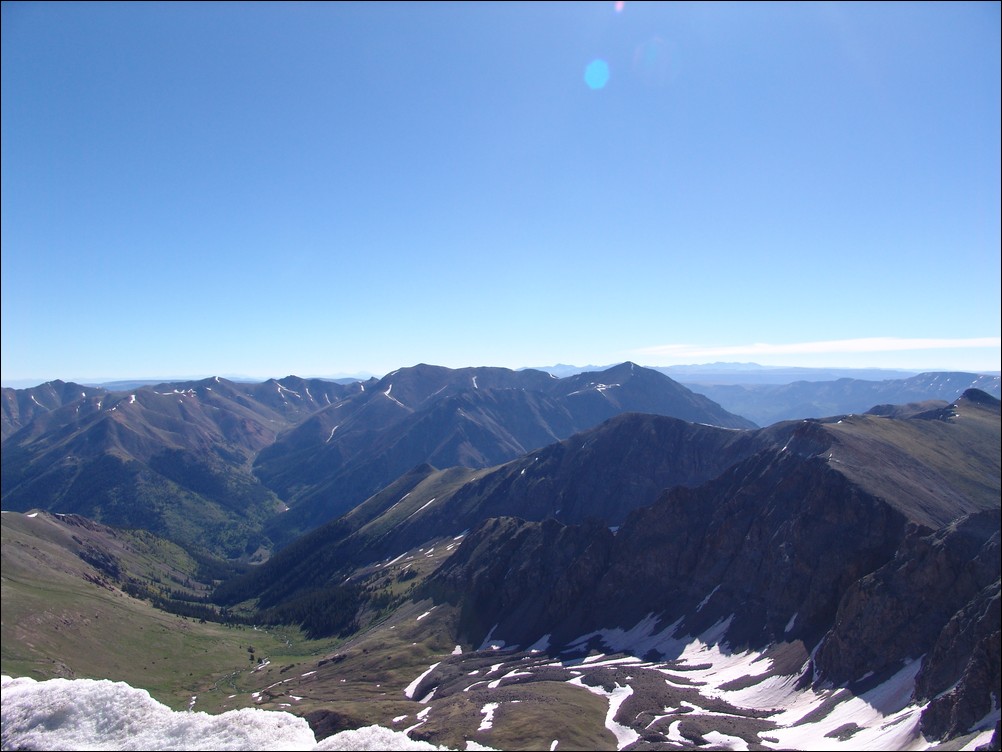
Redcloud and Sunshine Peaks rest just east of Handies.
Additionally, I was able to get a good glimpse of my second objective for the day - Whitecross Mountain. Whitecross looked further away than I thought it would, but with the insanely great weather we had and with my legs feeling superb, I was not concerned.
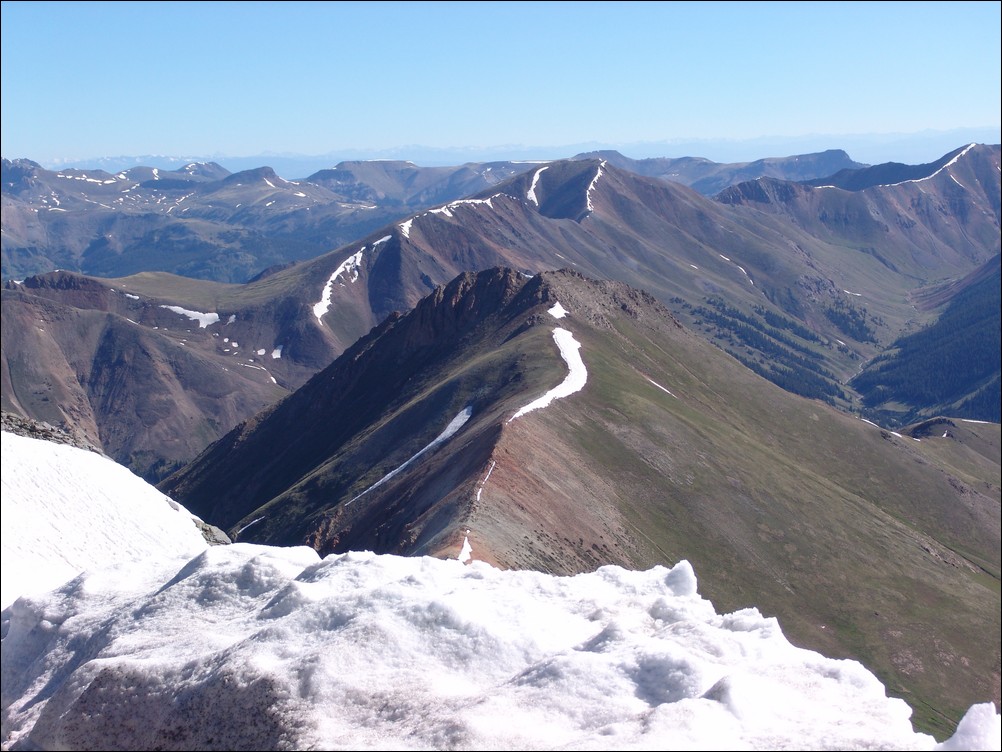
Whitecross Mountain and the traverse to it (partially obscured by snow).
We were joined on the summit by Ben Smith of 14erPlatinumTeam.com. Ben was with his friend Don, and they were quite friendly. We chatted for a bit about our climbing adventures and plans and exchanged website information.
I took more photos of the surrounding peaks.
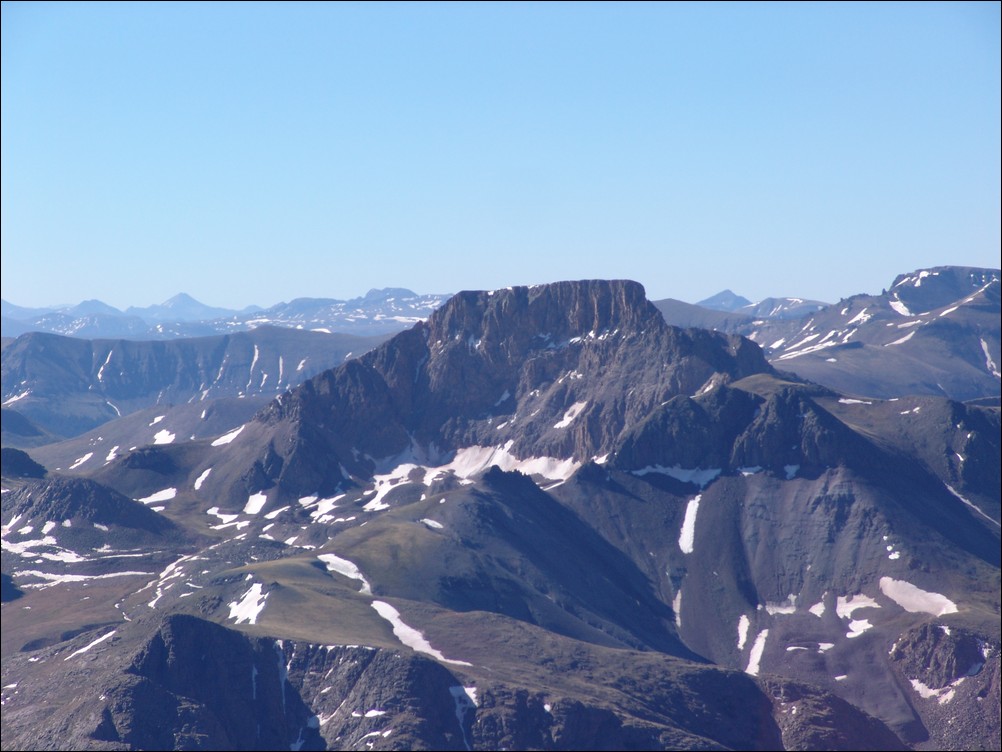
Half Peak
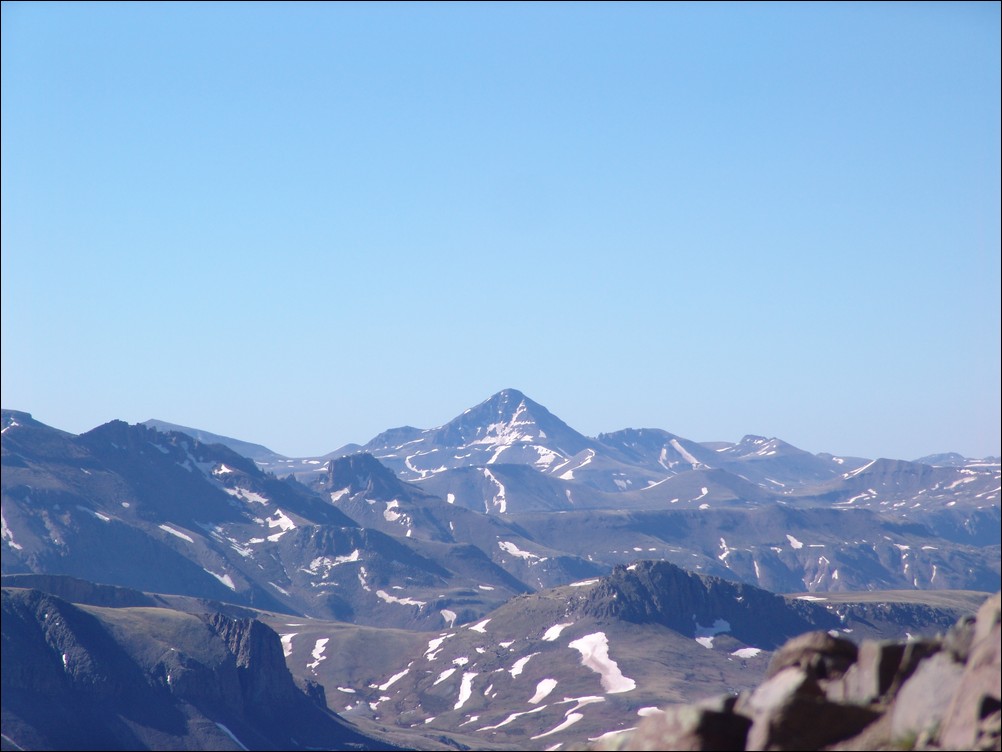
Rio Grande Pyramid
I had Don snap one more photo of my on top and Ben volunteered to take some photos with his camera as well. He was kind enough to email me the photo he took of Ray and I on top.
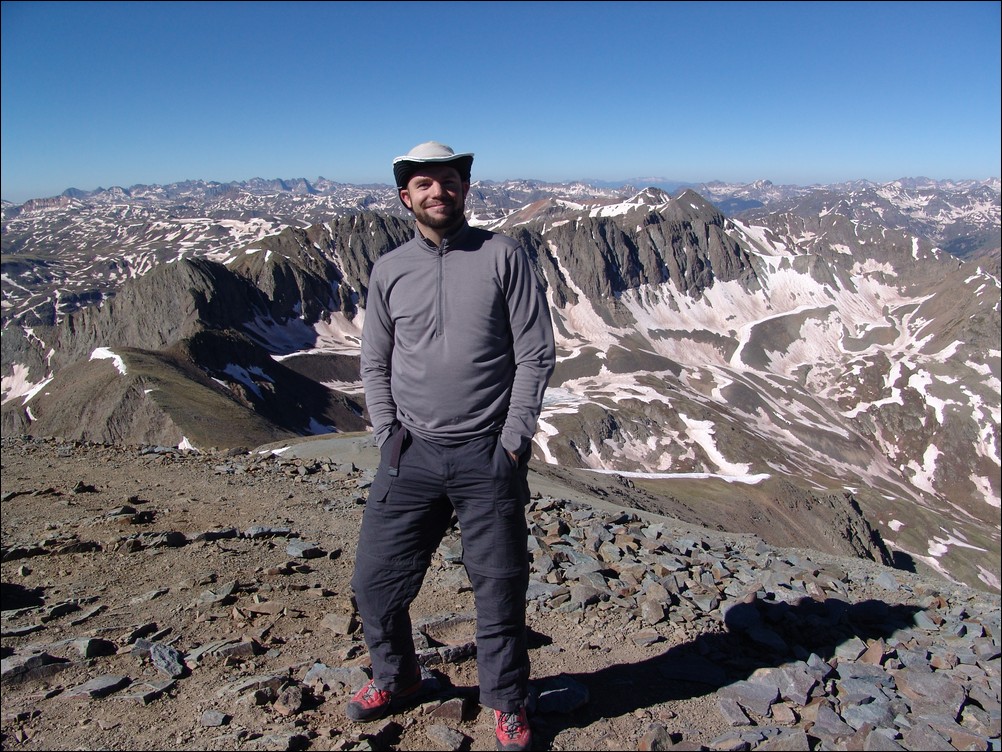
Matt Payne on top of Handies Peak
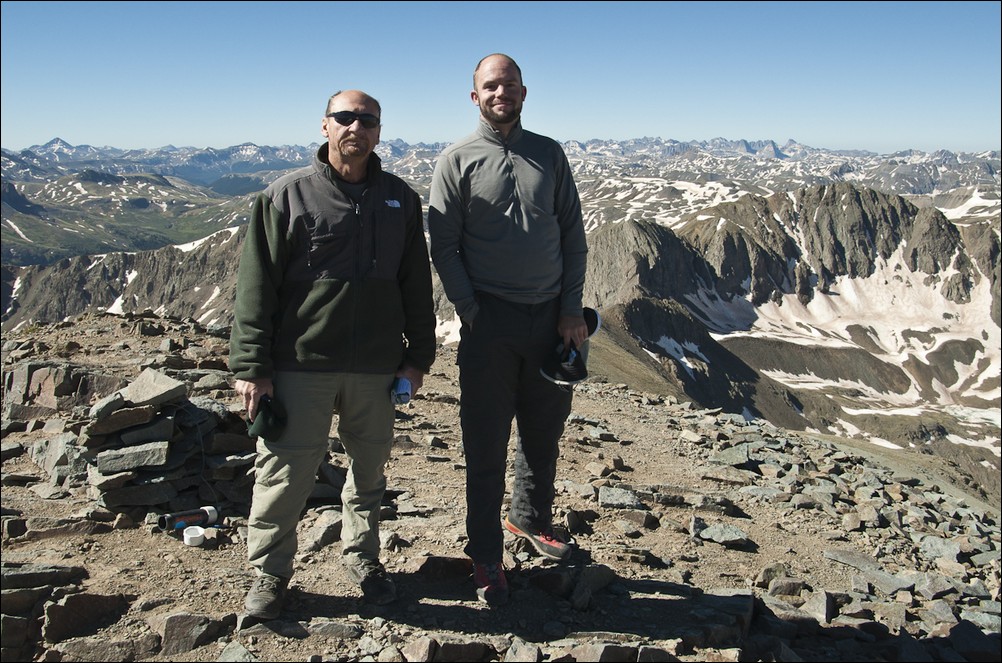
Matt and Ray Payne atop Handies Peak - photo courtesy of Ben Smith.
Ray and I packed up and got ready for our traverse over to Whitecross Mountain. Ray informed me that he would probably not go to Whitecross but would wait for me at the saddle between Handies and Whitecross. This sounded like a good plan and we began to head north after bidding adieu to Ben and Don.
Shortly after making our way down towards the Handies - Whitecross saddle, we gained an excellent view down to the west into the valley we started in. Lo-and-behold we could see my Jeep way down below.
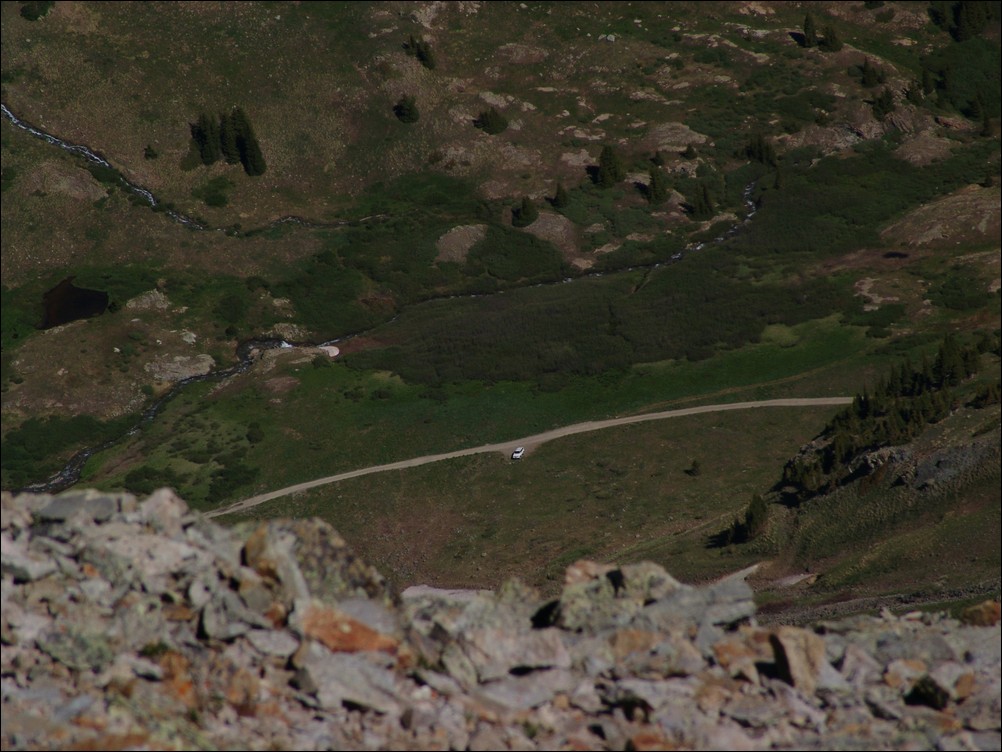
Matt Payne's Jeep far below in the American Basin.
After making it down the steepest section from Handies' summit, we gained excellent views of the Whitecross traverse and the terrain we ultimately needed to navigate across.
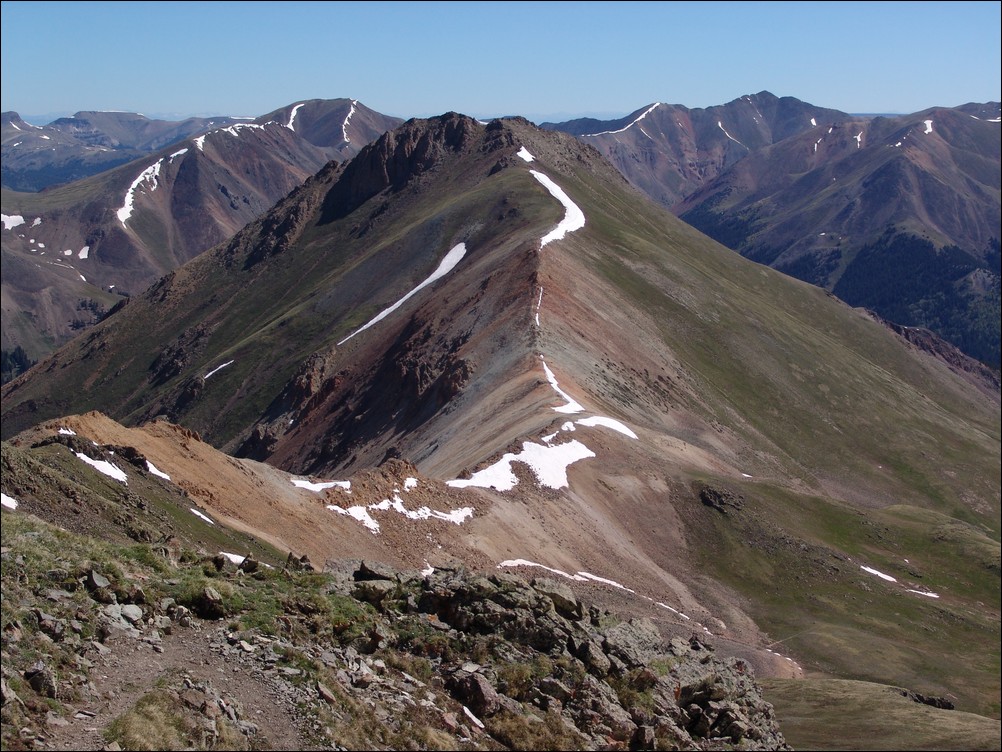
Whitecross Mountain's traverse terrain
By this point, we could look back at Handies and get a really nice profile of it from the north side.
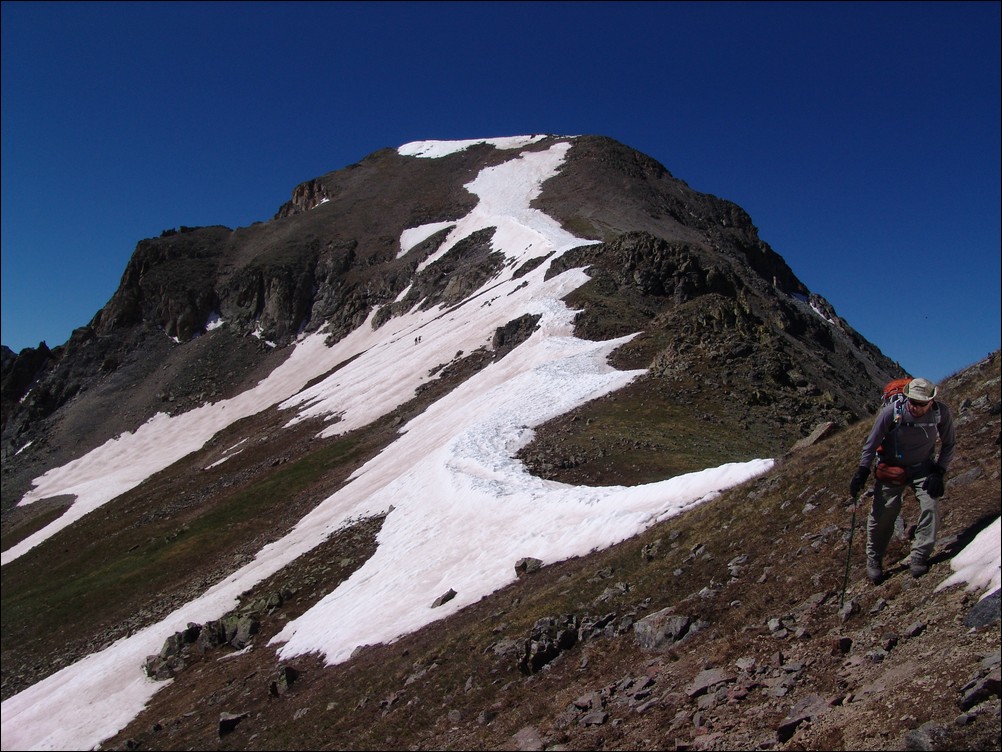
Ray Payne traversing towards Whitecross Mountain away from Handies Peak
Being mid-June still, we encountered some difficult snow on the traverse and at one point I fell up to my hips into a snow bank. This was rather uncomfortable, being on a quite steep section with about 100 feet of run-out below me. I decided to pause to gather my wits and to get out my ice axe. I used the ice axe as a safety device as I faced into the mountain and slow kicked steps into the snow while heading down at an angle towards the saddle. Ray followed in my footsteps and we both decided that it would have been smart to just stay high above on the ridge proper instead of angling around the side of the saddle near PT 13,577.
After successfully making it past the snowy sections, I once again stumbled upon a ptarmigan. This time, it let me get very close to it before I even noticed.
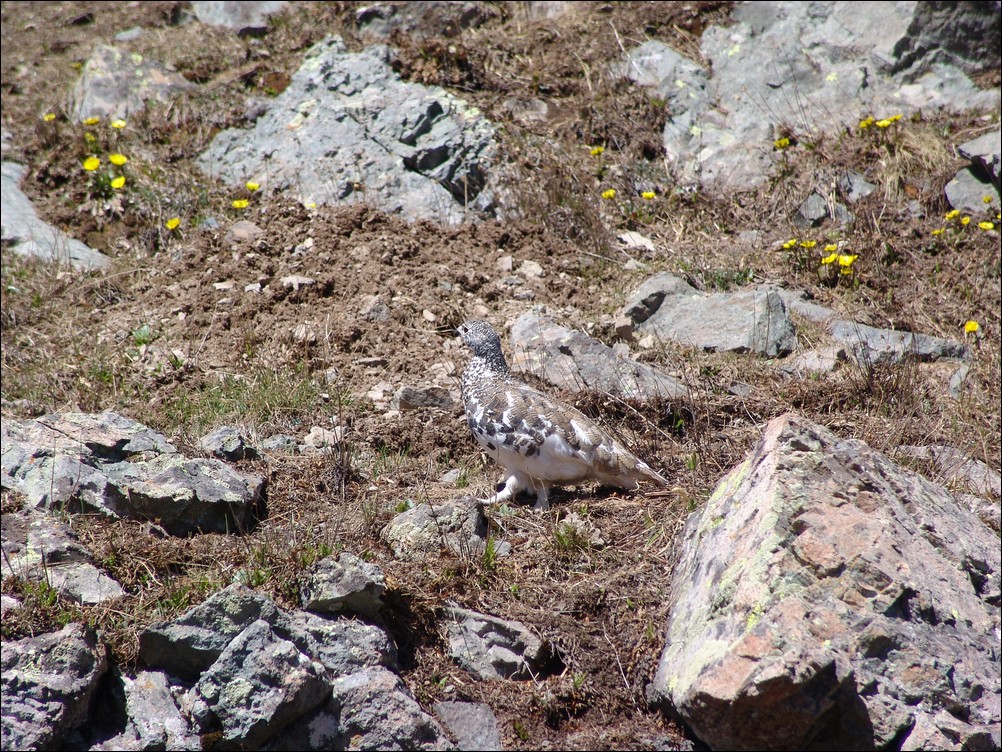
A Ptarmigan feeds upon the tundra near the saddle between Handies and Whitecross
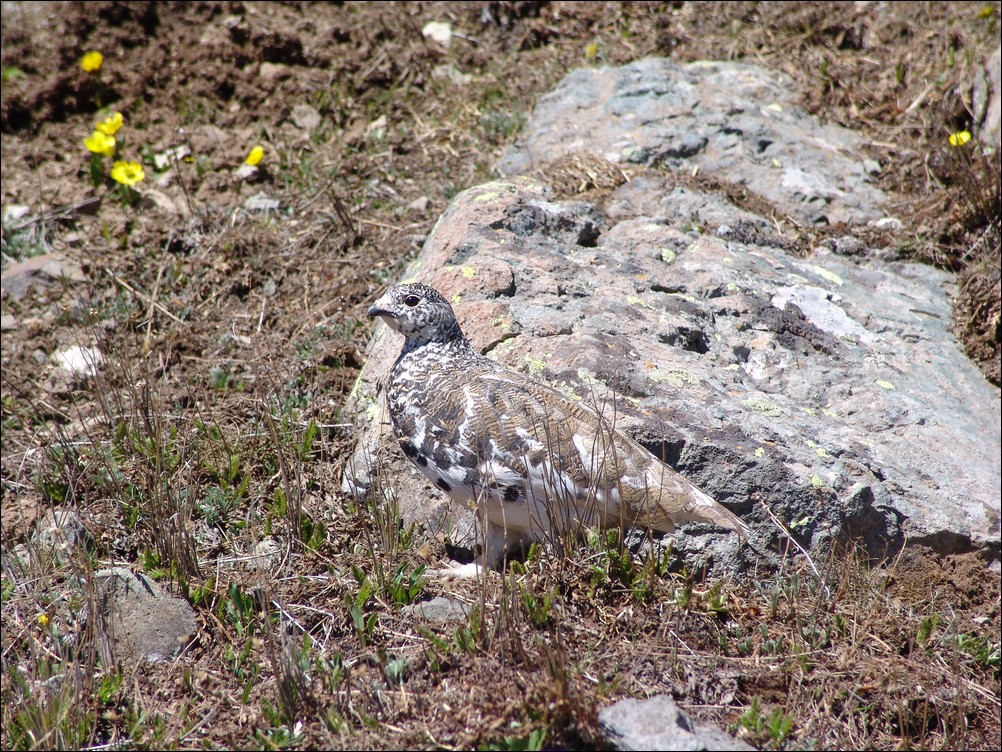
The views down into Grizzly Gulch were great during the traverse and I paused several times to get photos of the area.
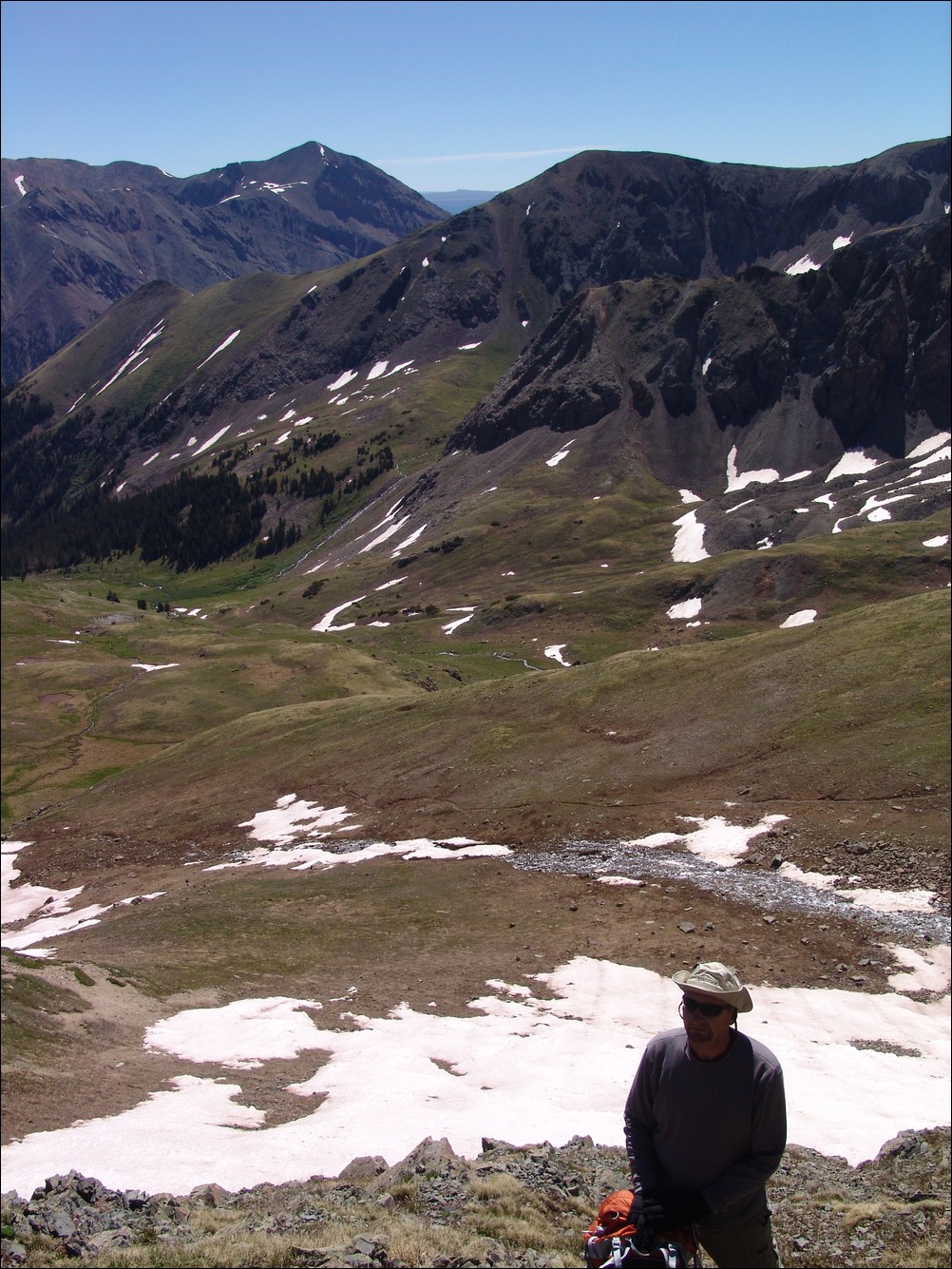
Ray Payne, traversing towards Whitecross Mountain, with Redcloud Peak left of center.
Most of the way to the saddle between Whitecross and Handies, we encountered some nasty scree below the ridge that we were forced to cross. The rock was the kind that when you stepped on it, huge sections of rock would slide above and below your feet. While this terrain is rather fun when down-climbing, it was not so fun while going across it.
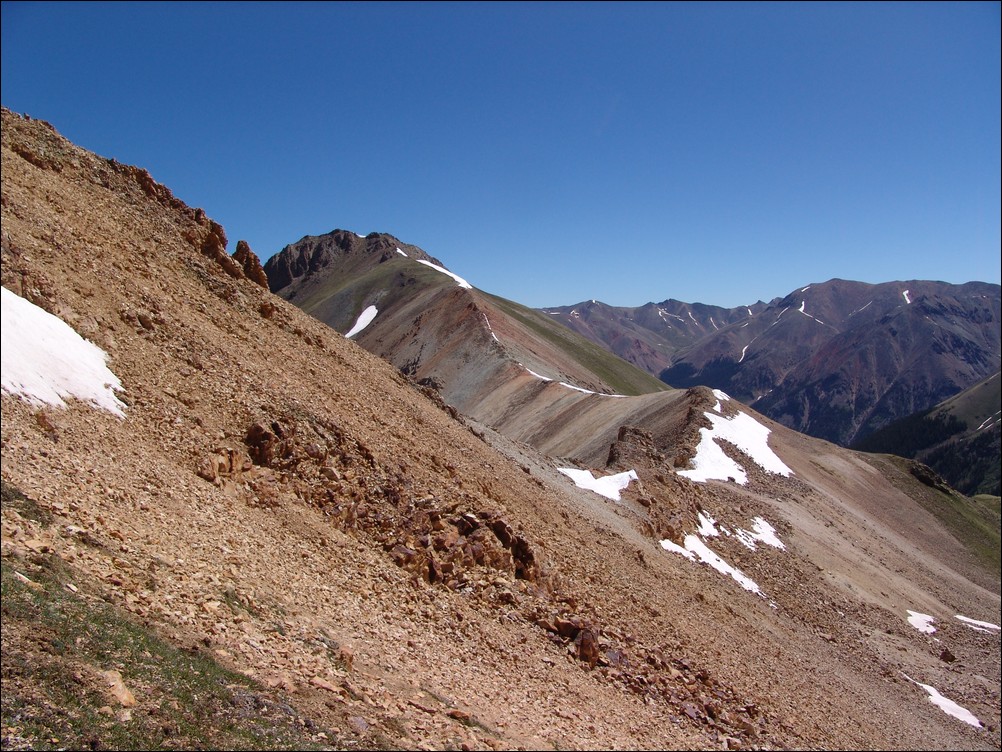
Scree with a red hue made for an interesting traverse to Whitecross Mountain.
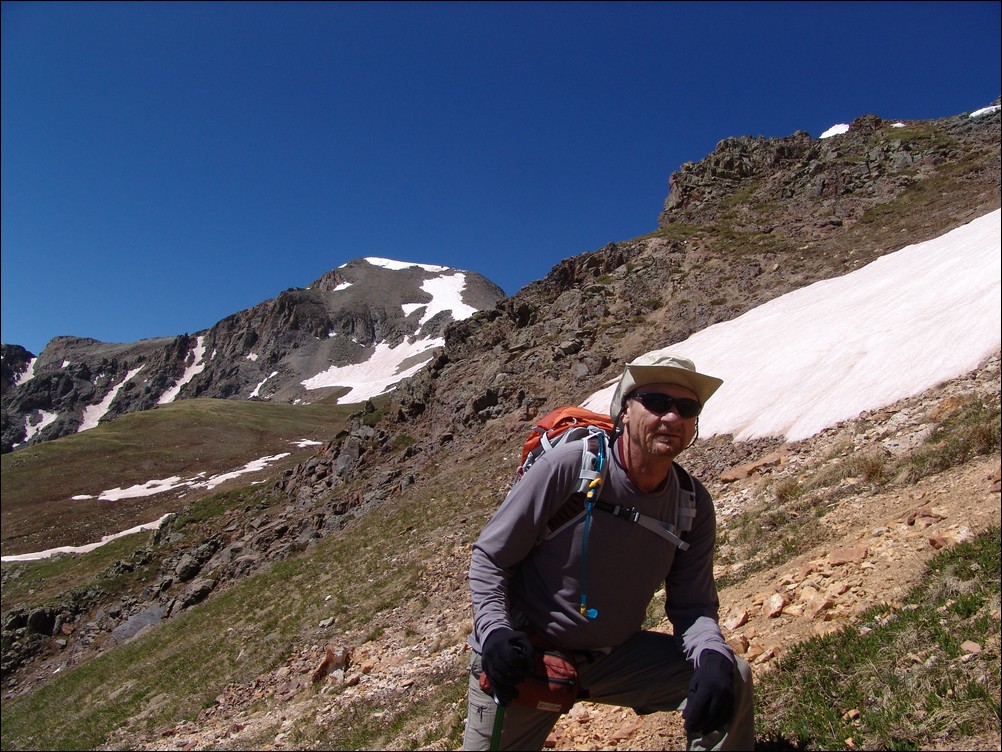
Looking back towards Handies Peak - Ray Payne welcomes the break in crossing the awkward terrain.
Ray and I reached the saddle near some fun rock outcroppings and discussed my plans for heading to Whitecross. I told Ray to "send the cavalry if I'm not back by midnight." I took off most of my gear and left it with Ray so that I could increase my speed for the traverse.
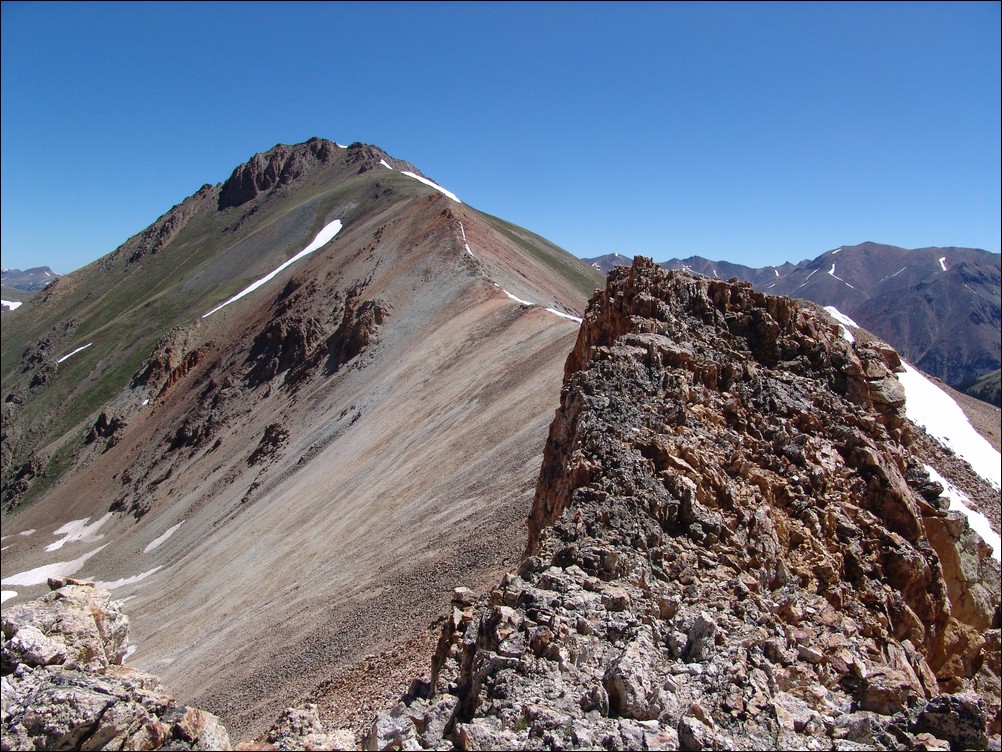
Whitecross Mountain sits above interesting terrain
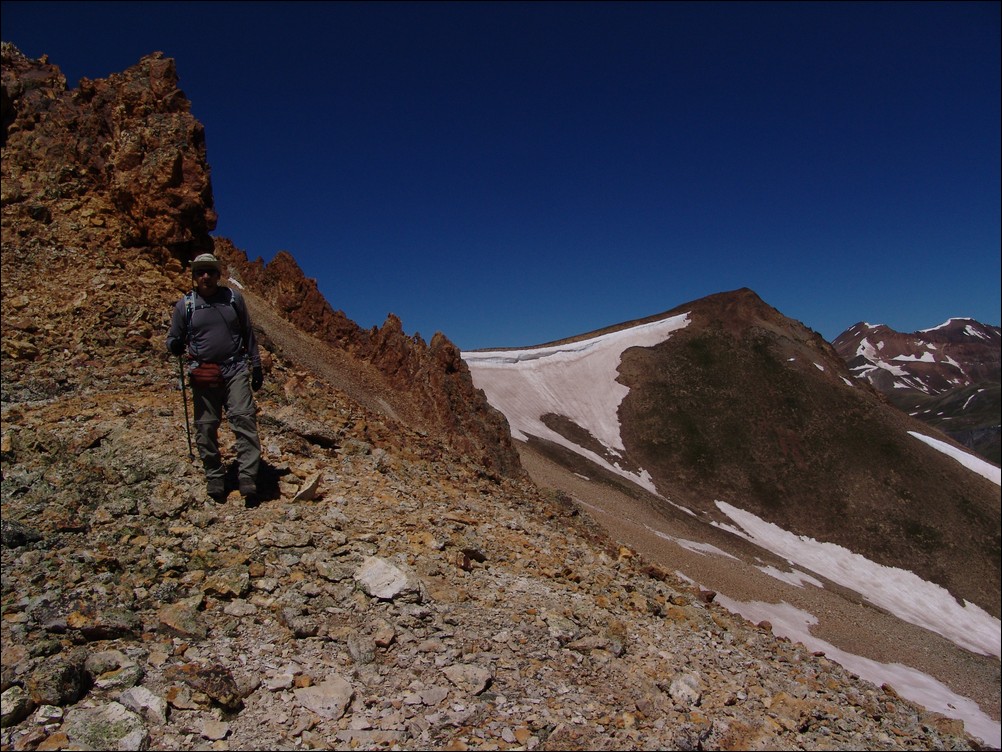
Ray Payne nears our meeting place
I started my traverse over to Whitecross at 11 AM. There were no threatening clouds and I felt solid.
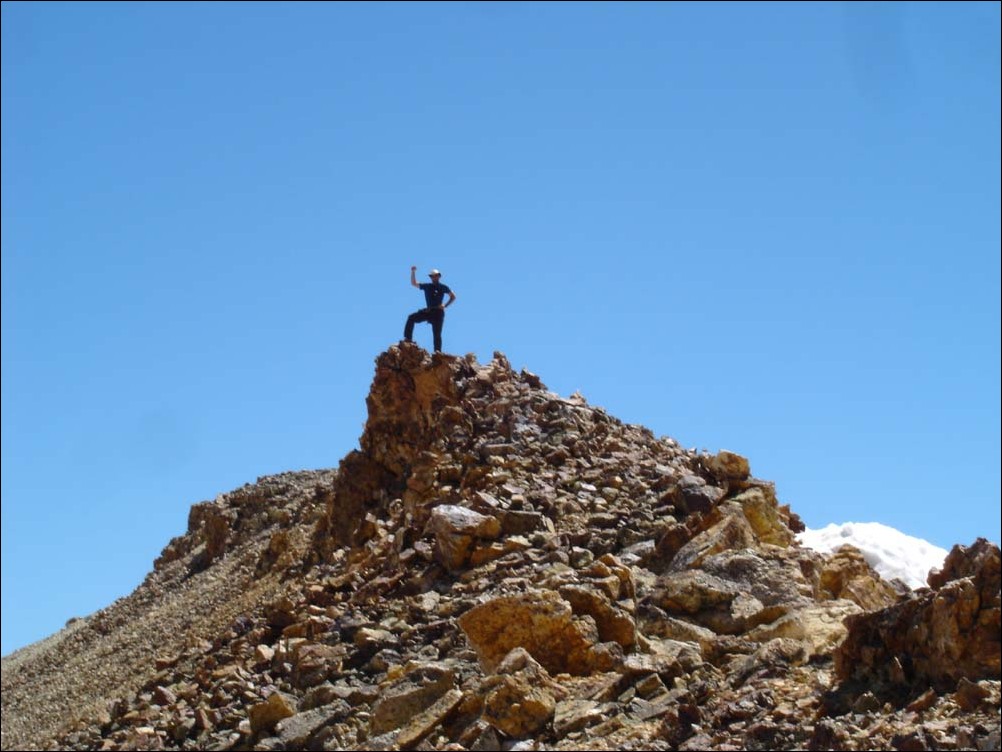
Matt Payne poses on top of a rock formaton on the way up Whitecross Mountain
About halfway up Whitecross, I was able to get a better view of the cornice across the way and Golden Horn (ranked 116) behind it in the distance.
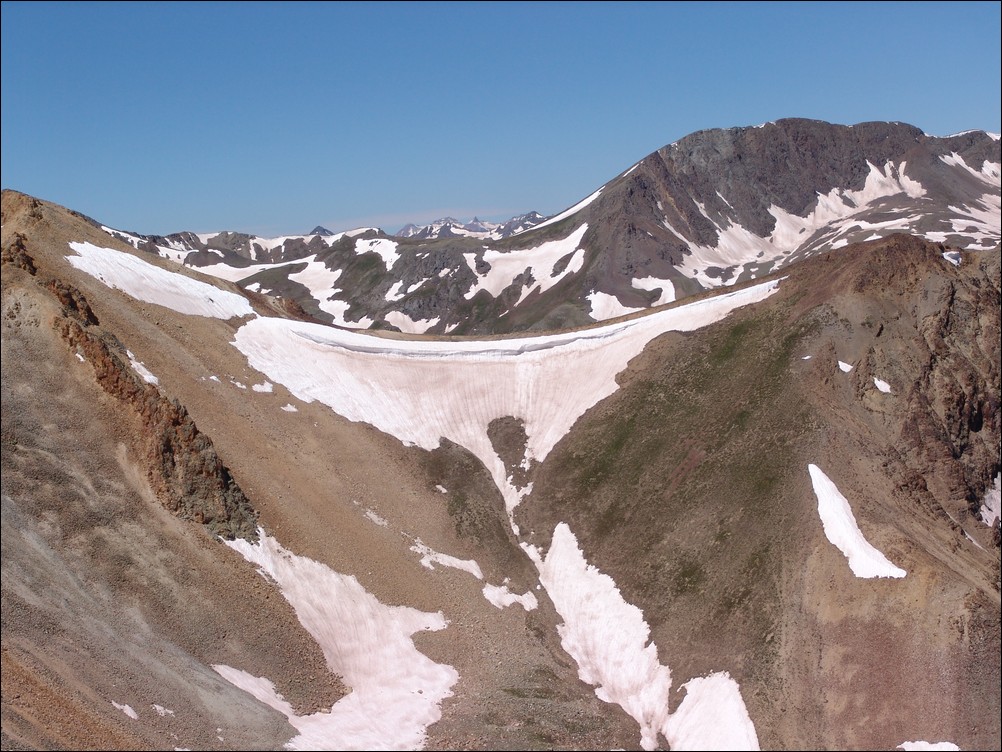
Cornice with Golden Horn behind it.
I made my way up Whitecross quite steadily and quickly. I made great time to the tundra field below it and could see the route up the summit block.
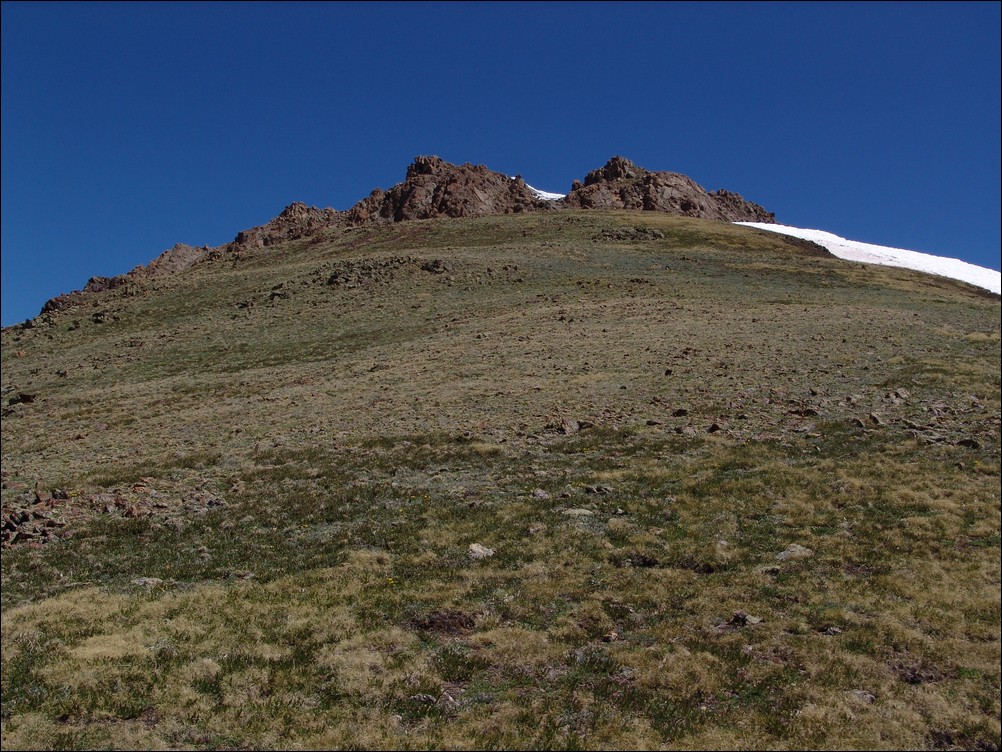
Whitecross Mountain's summit block
I also could see some amazing views of the western ridge of Handies and a couple lakes below it.
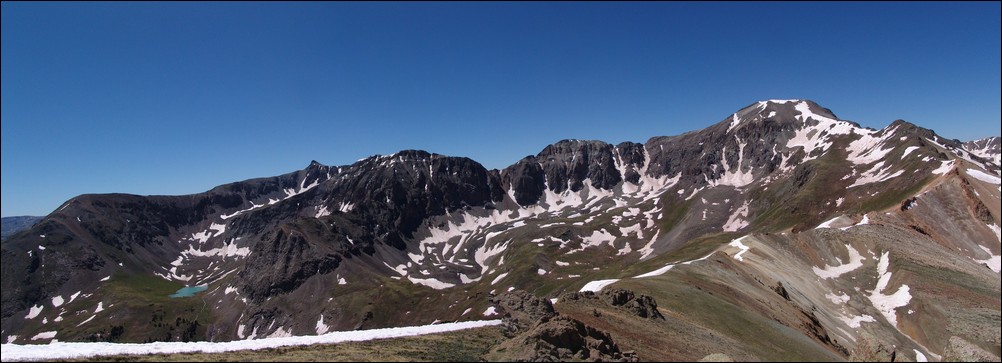
A small lake rests in the basin below the western ridge of Handies Peak.
I made my way up towards the top of Whitecross rather quickly and was greeted with views of another neat cornice sitting in front of Uncompahgre Peak and Whitecross (to its left).
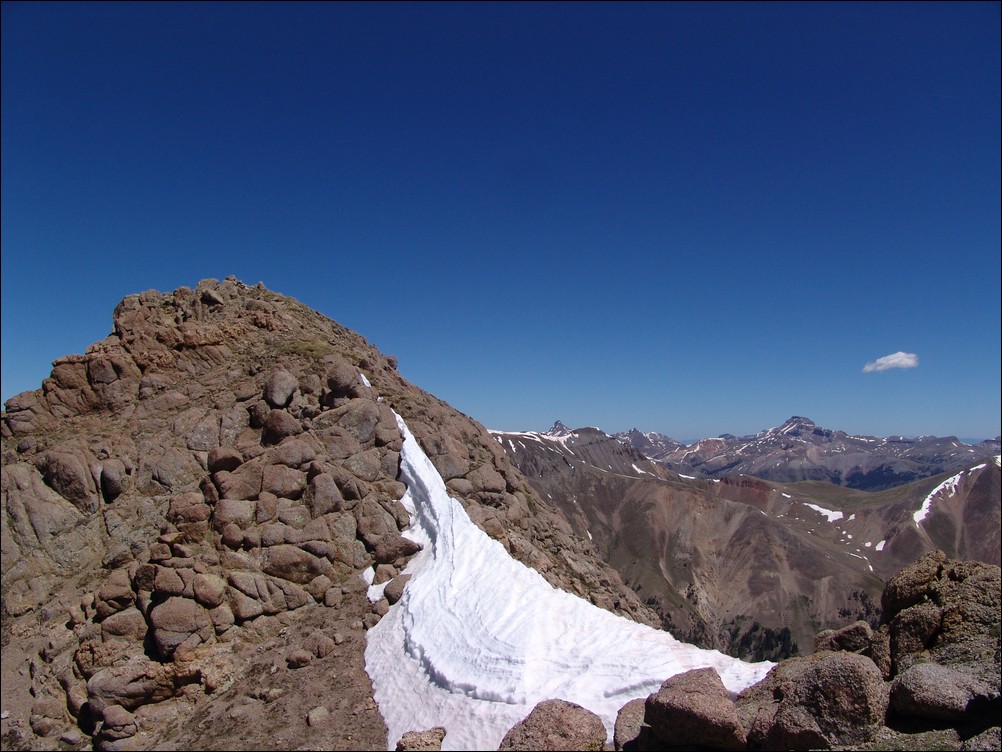
A cornice sits below the summit of Whitecross with Uncompahgre and Wetterhorn in the distance.
I finished up the climb up Whitecross and enjoyed views of Handies and the valley below Whitecross which was obscured before. The traverse from the saddle took 30 minutes on the mark.
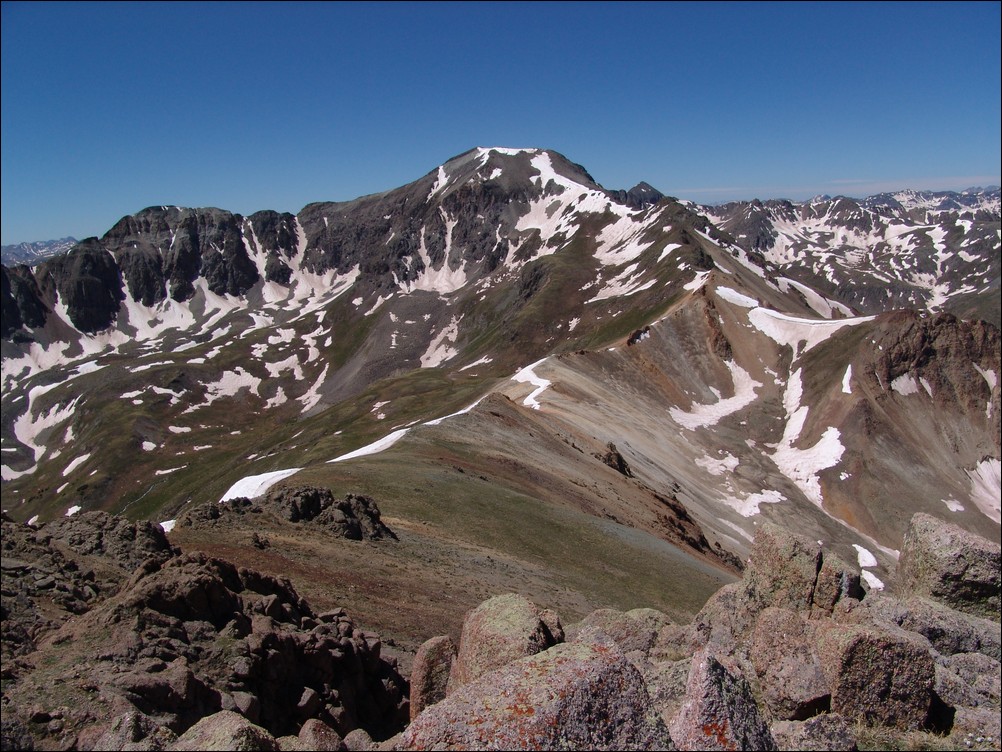
Handies as seen from the summit of Whitecross
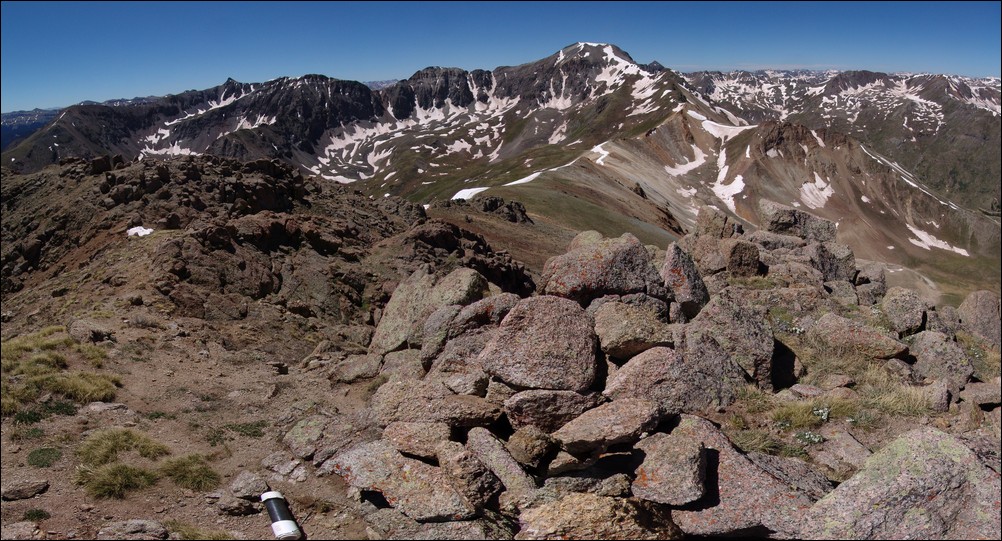
The summit register lays out on the summit of Whitecross.
I signed the summit register (first to do so in 2010), and gathered a few more photos for a panoramic photo and a self-timer summit photo.
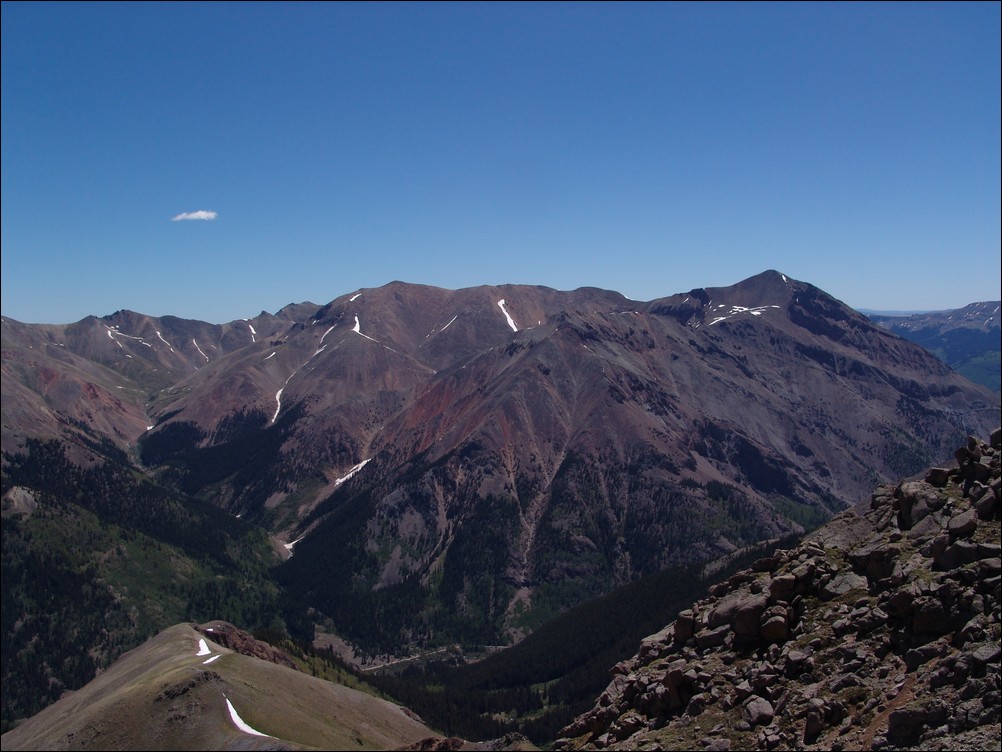
Redcloud and Sunshine are seen in better detail from Whitecross Mountain.

A view north, east, and south from Whitecross Mountain.
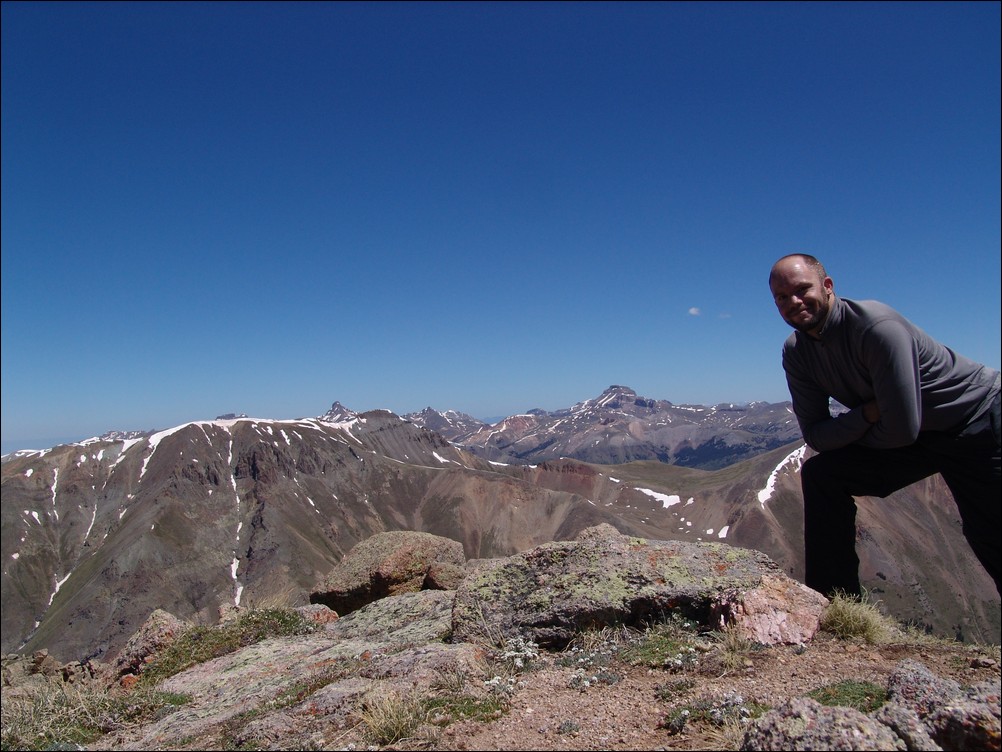
A self-timer summit shot on top of Whitecross Mountain.
After spending a few minutes on top, I headed back down the ridge towards Ray, stopping once on the way to capture a shot of some wildflowers on the ridge.
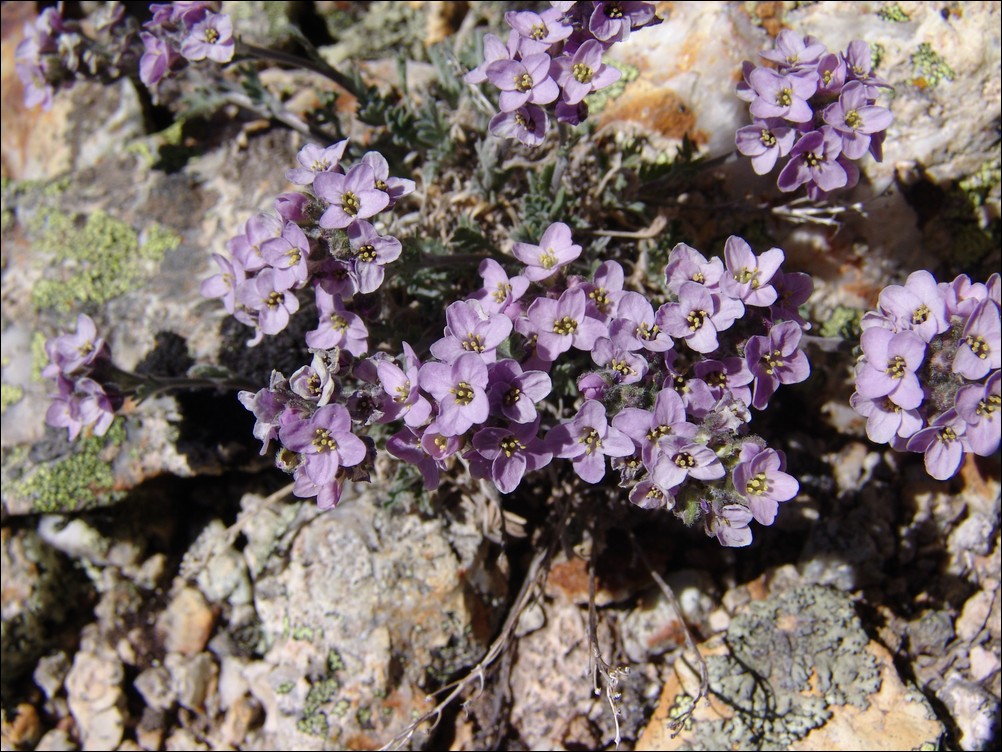
A macro shot of some purple flowers on the ridge between Whitecross and Handies.
After 20 minutes of down-climbing, I reached Ray again, having spent a total of 50 minutes on the traverse from the saddle and traveling a distance of 1.11 miles with 558 ft. of elevation gain. Ray and I packed our belongings and headed down the steep scree to the north of the saddle. We had studied our maps and determined that this route would get us back to the road eventually and that it was the safest descent route. The only downside was that we would be required to hike back up the road to my car. A small price to pay for a great traverse.
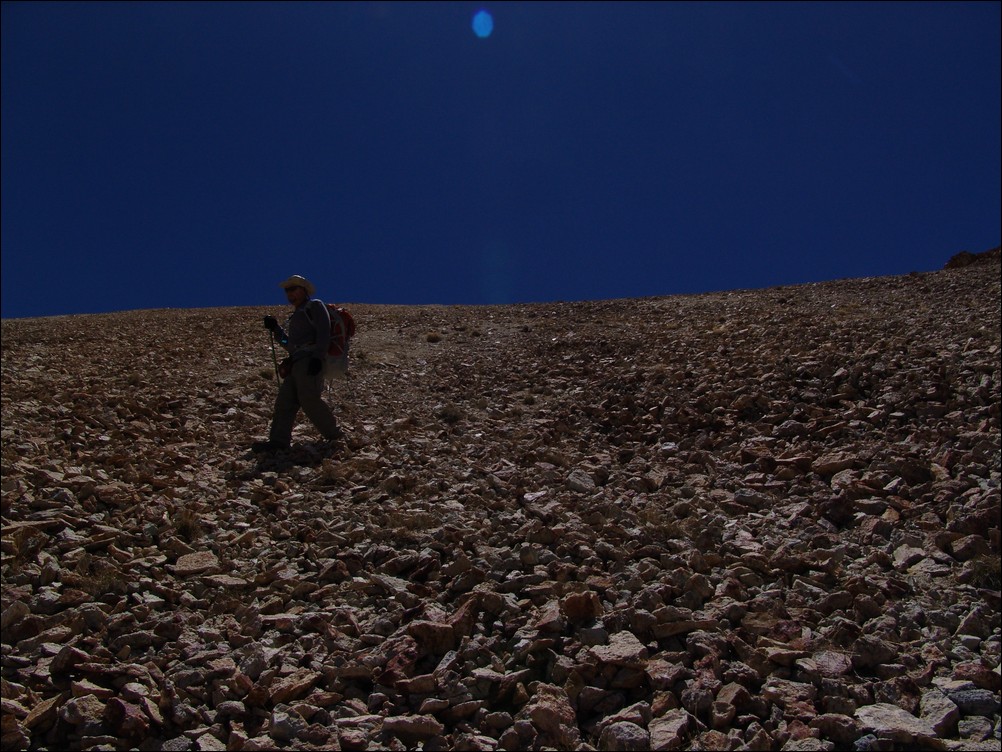
Ray descends the steep and loose scree below the Handies-Whitecross saddle.
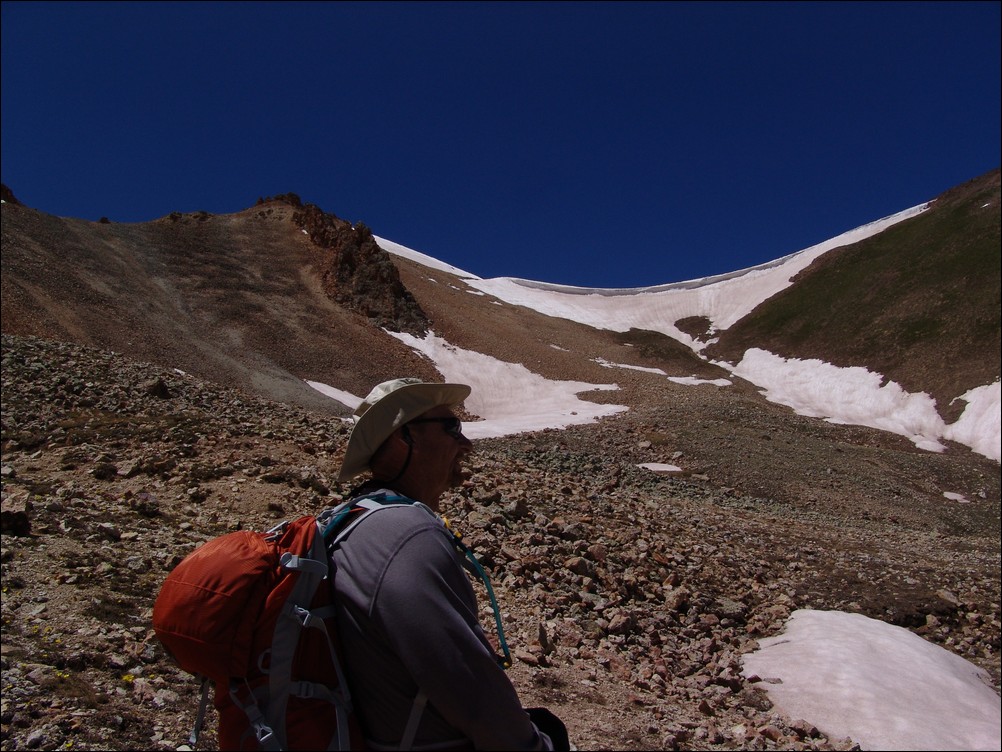
Ray Payne with the Whitecross-Handies saddle above
On the way down, we captured one last view of Uncompahgre.
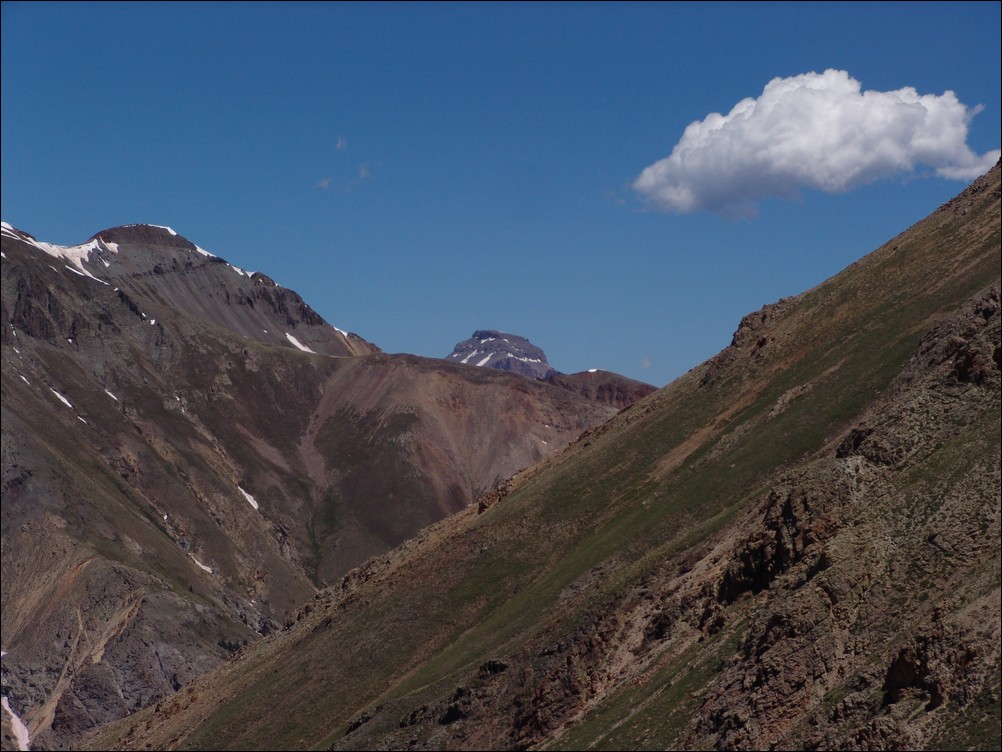
Uncompahgre Peak pokes above the surrounding ridges.
The route down towards the road was straight-forward and enjoyable. We made awesome time down towards tree-line.

A look back towards the Whitecross-Handies saddle and the steep terrain negotiated on the way down from Whitecross.
We made quick time to tree-line, and after less than an hour, we were entering the trees and much steeper terrain.
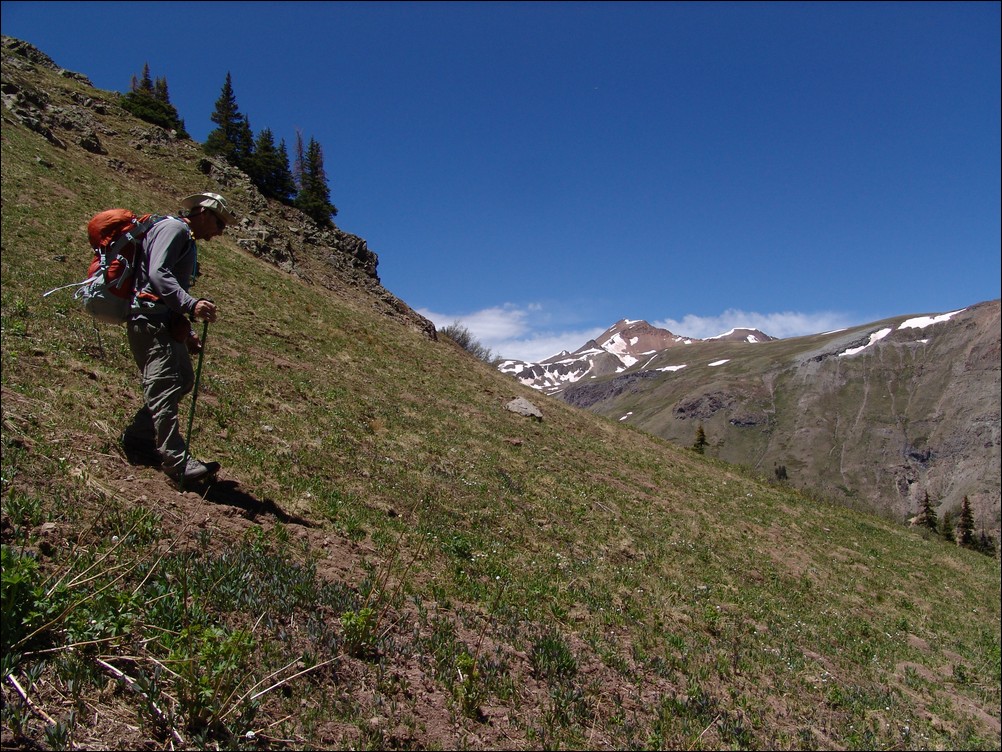
Ray Payne down-climbs from the Whitecross-Handies saddle.
The wildflowers on the fridge of the forest were amazing -yellow flowers were blooming everywhere on the mountainside.
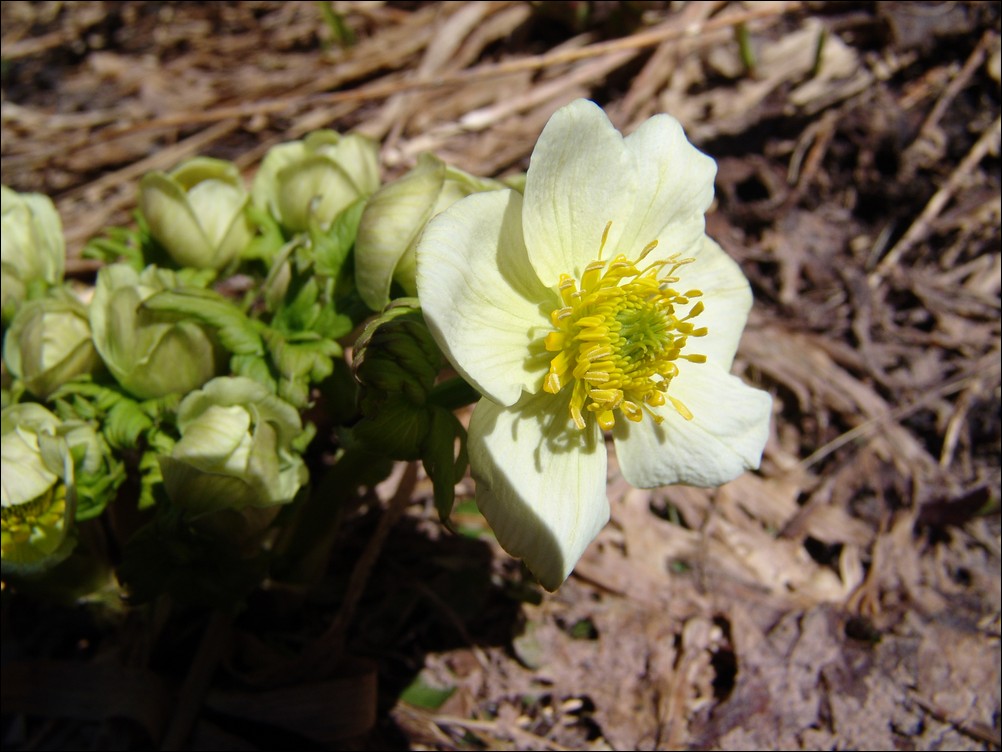
A yellow flower blooms in this macro shot near tree-line.
Soon after entering the trees, the terrain became much steeper and was littered with huge deadfall and other fun obstacles. We negotiated through the deadfall for about 20 minutes until reaching somewhat of a clearing.
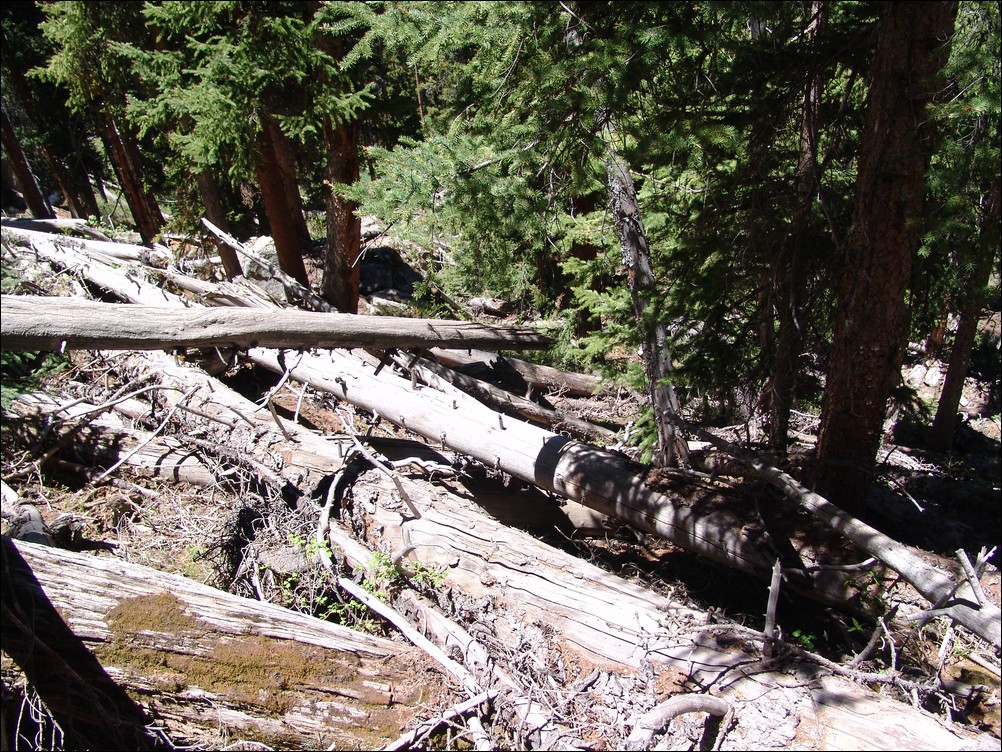
Deadfall on the descent of Whitecross and Handies.
From this clearing, we were able to find a small service road on the mountain side. We aimed for this road, hoping we were not trespassing on private property, and followed it down. We were grateful for finding the road, as it had a bridge across the Lake Fork Gunnison River where it connects with the main American Basin road.
We also saw a large mine shaft with railroad tracks leading into it - evidence of that at one time this region was heavily mined.
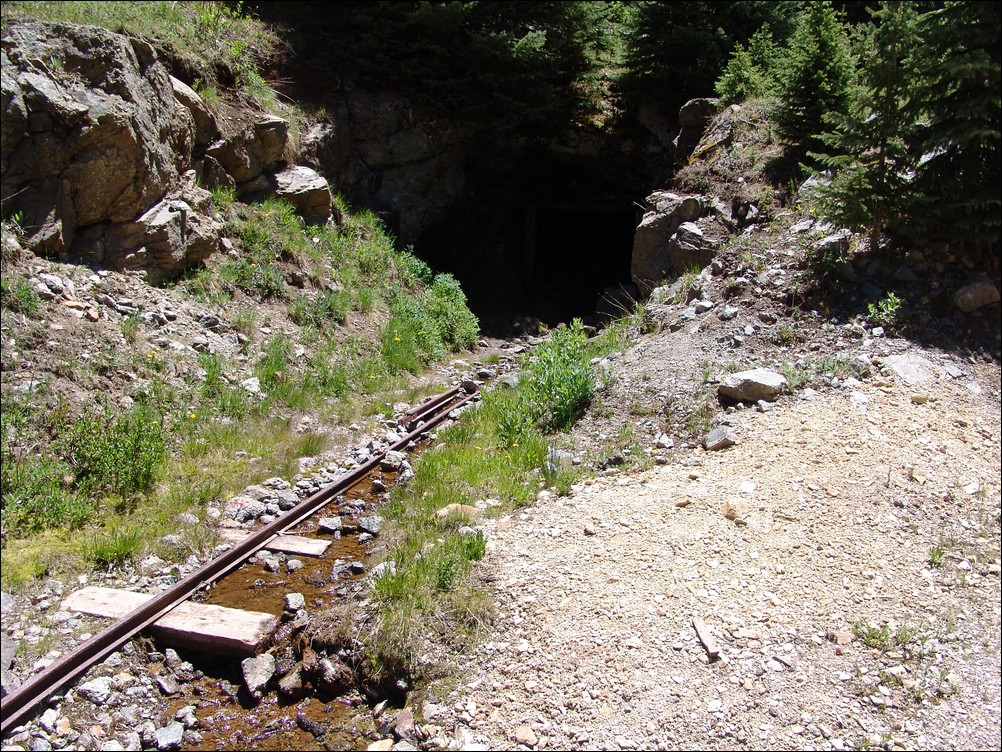
Railroad tracks lead into the darkness of an abandoned mine shaft.
Once back on the main road, we were able to get a good view of the valley and mountainside we had come down.
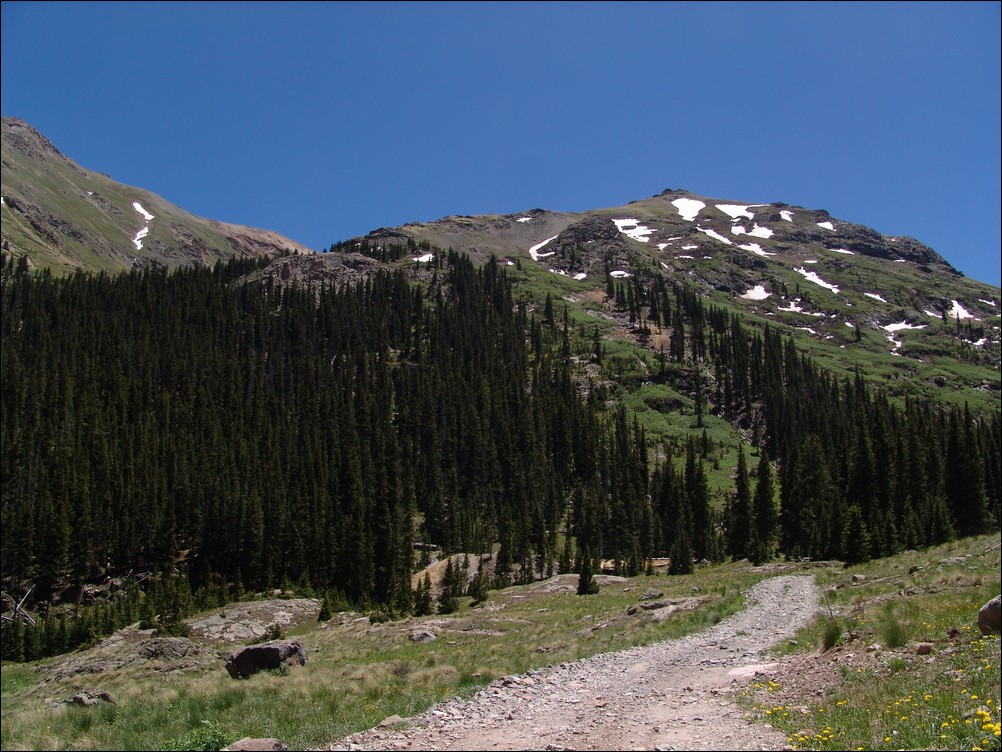
Ray and I hiked back up the road towards my Jeep. The road was pretty long and we needed to hike about a mile or so. American Basin was looking impressive in full sunlight.
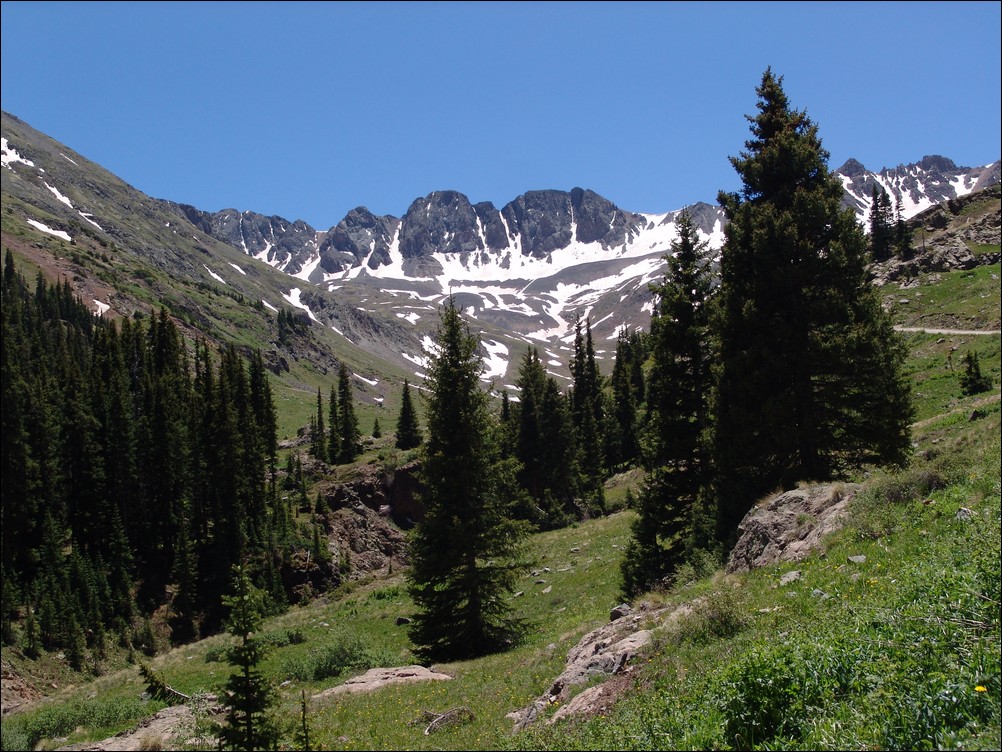
American Basin
We crossed the head of the river near a large snowbank we had noticed on the way up the night before.
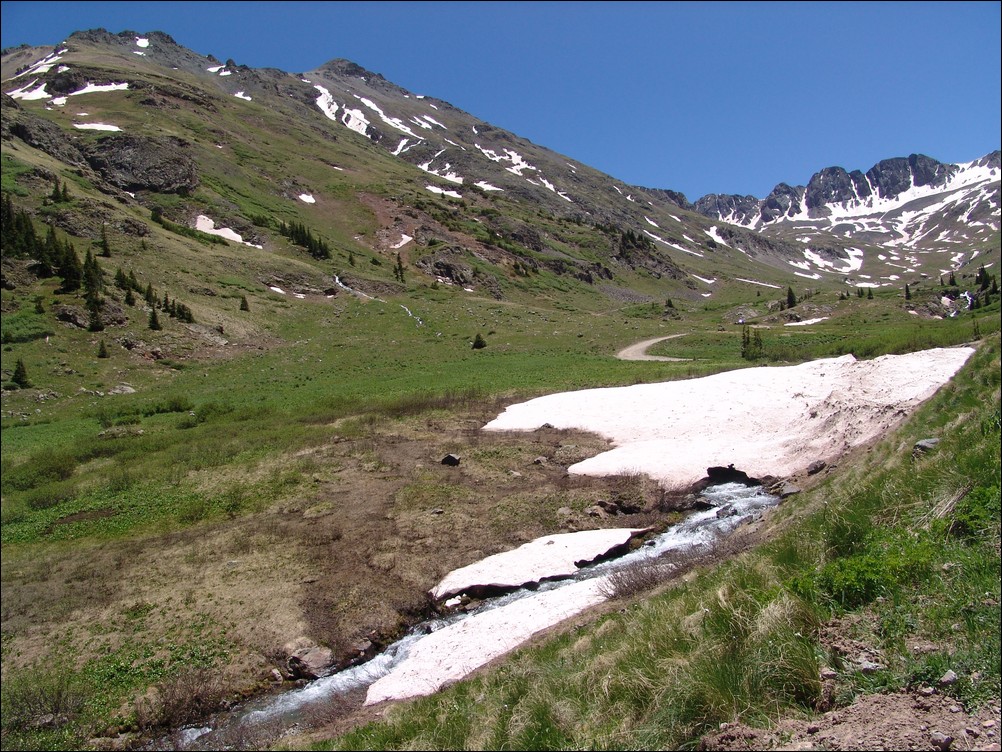
I took one more photo of the American Basin on the way back up to my Jeep. The waterfalls and surrounding terrain were very aesthetically pleasing after the long day of hiking.
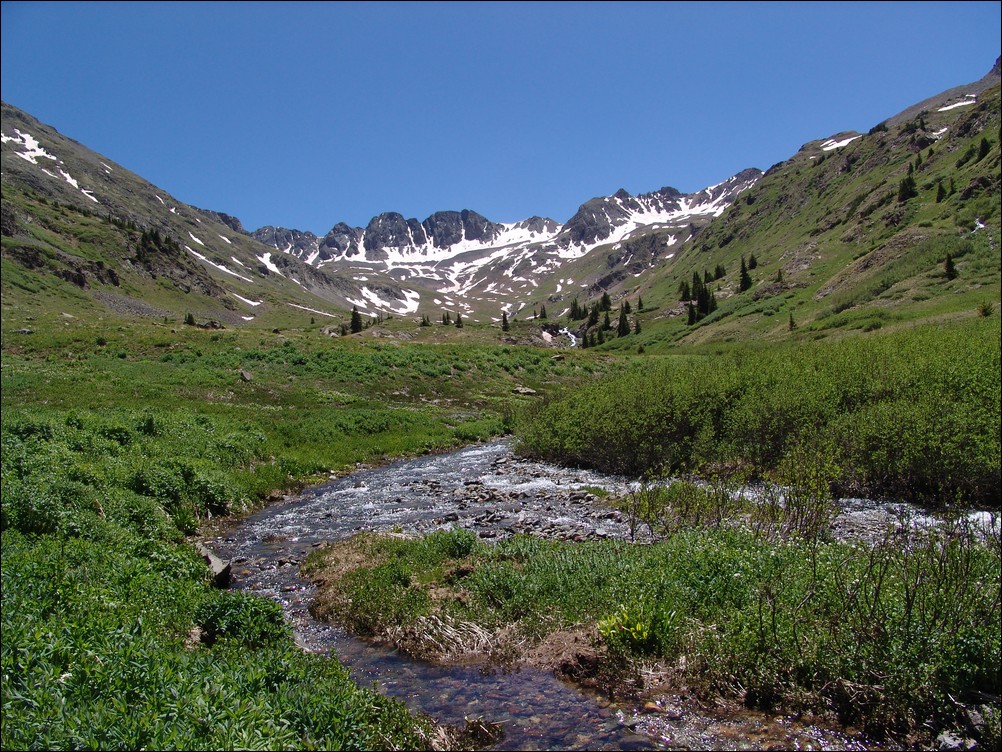
We finally made it back to the Jeep at 2:30 PM and I took one final set of photos to illustrate the daytime views from where we camped.

We packed up our gear after eating some snacks and headed back down the road in my Jeep. This is one of the best hikes up a relatively easy 14er with highly rated views. Given the ease of climb and the rewarding views, I would say that Handies Peak should be on all beginner and serious hikers' to-do lists.
I hope you enjoyed this trip report for Handies Peak and Whitecross Mountain. Next weekend: Missouri Mountain, Iowa Peak and Emerald Peak with my friend, Ethan Buete.


